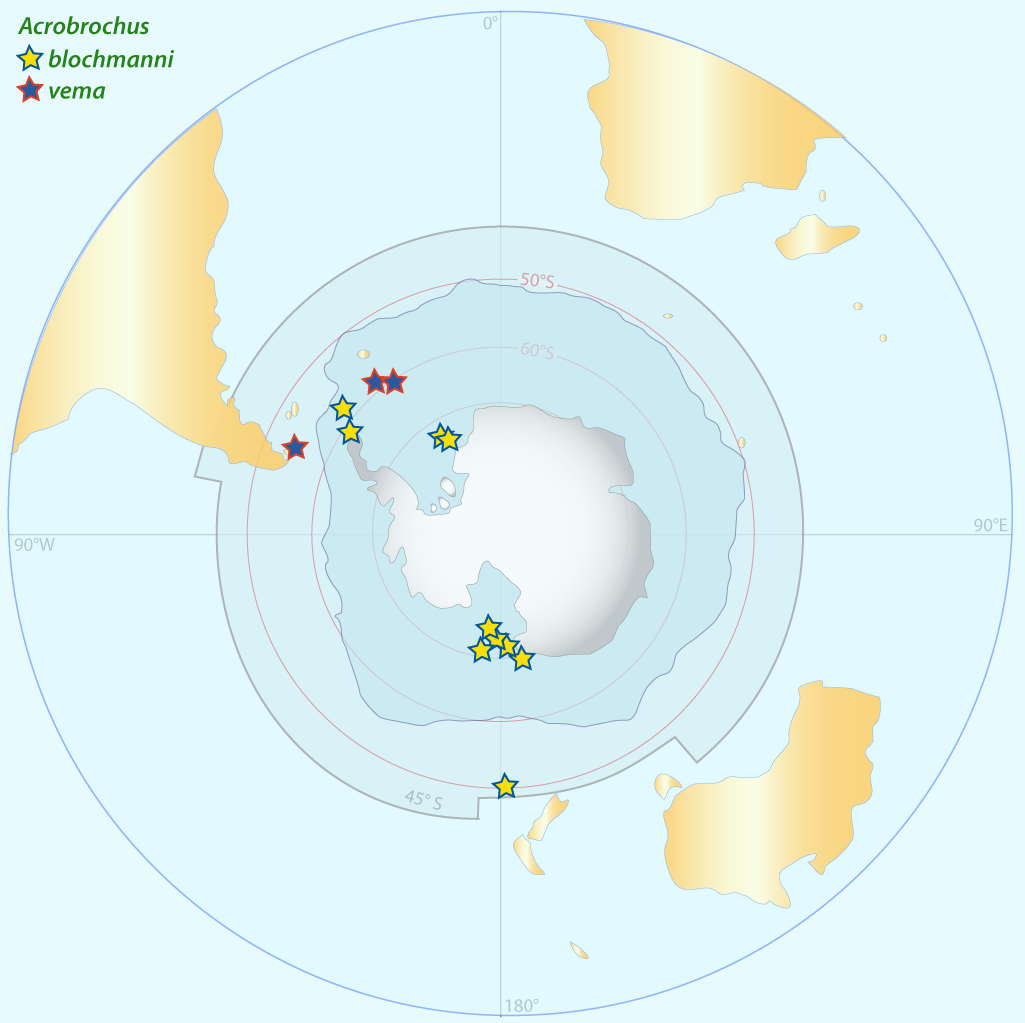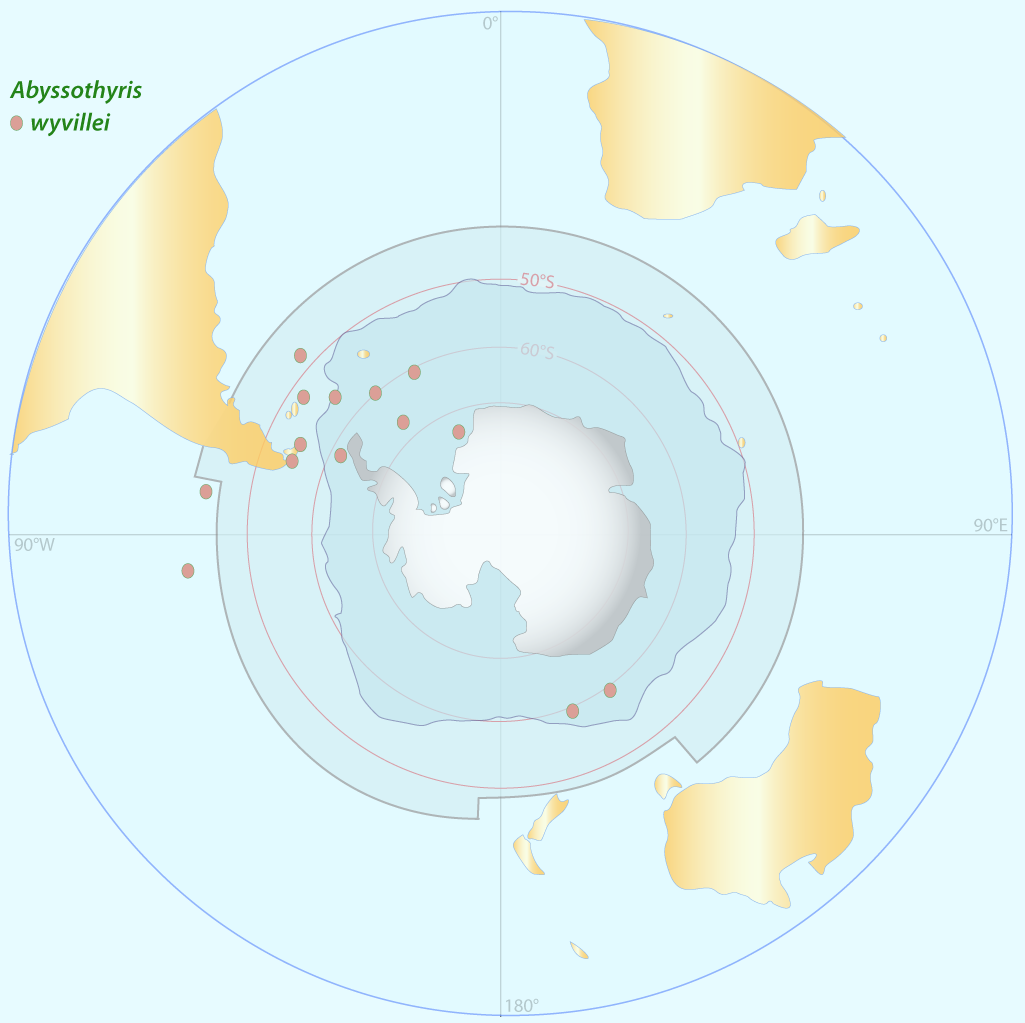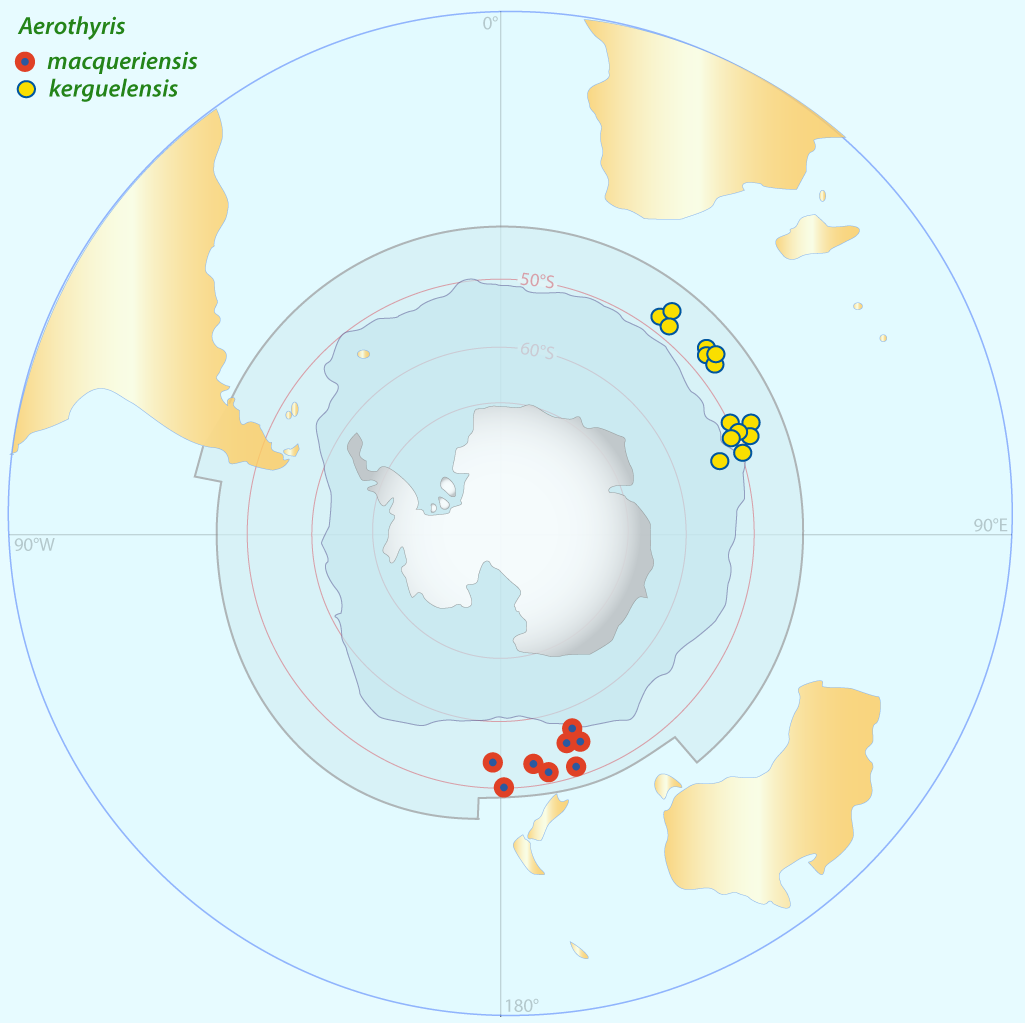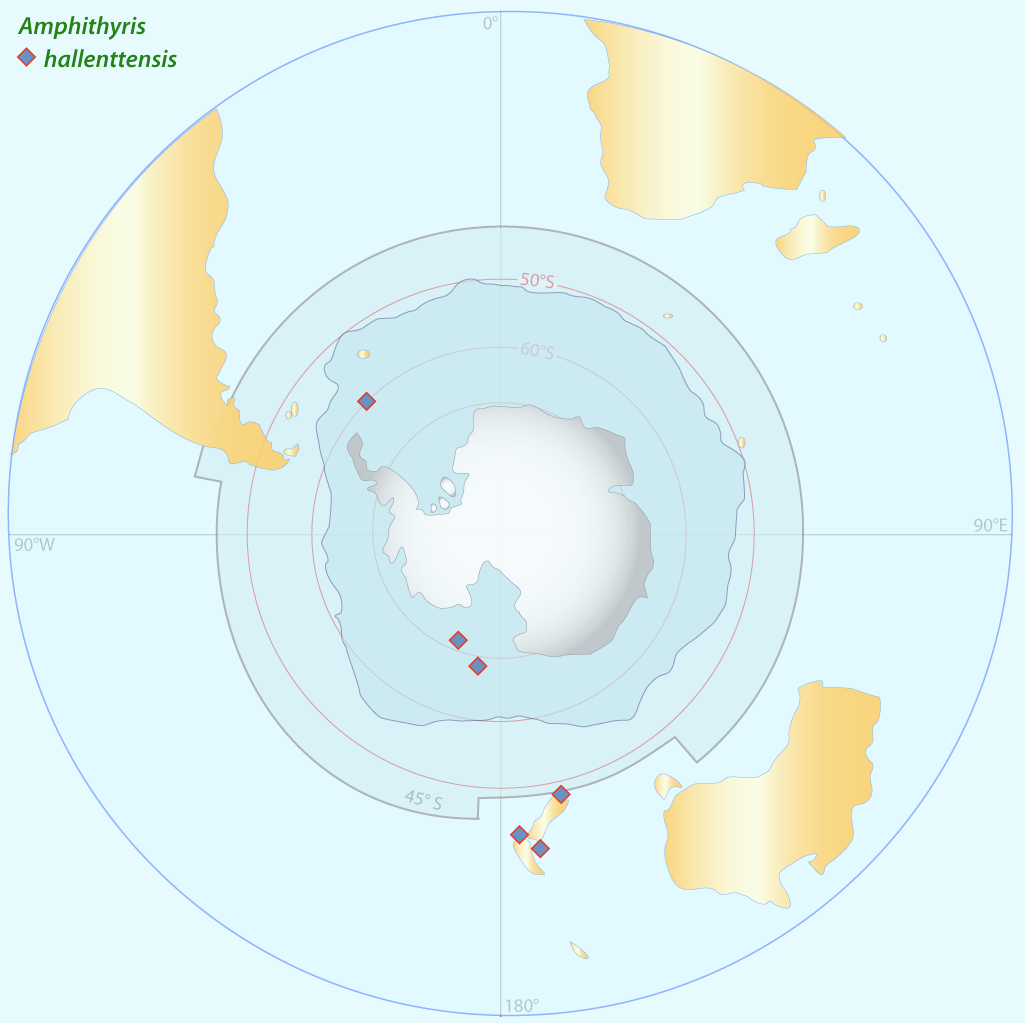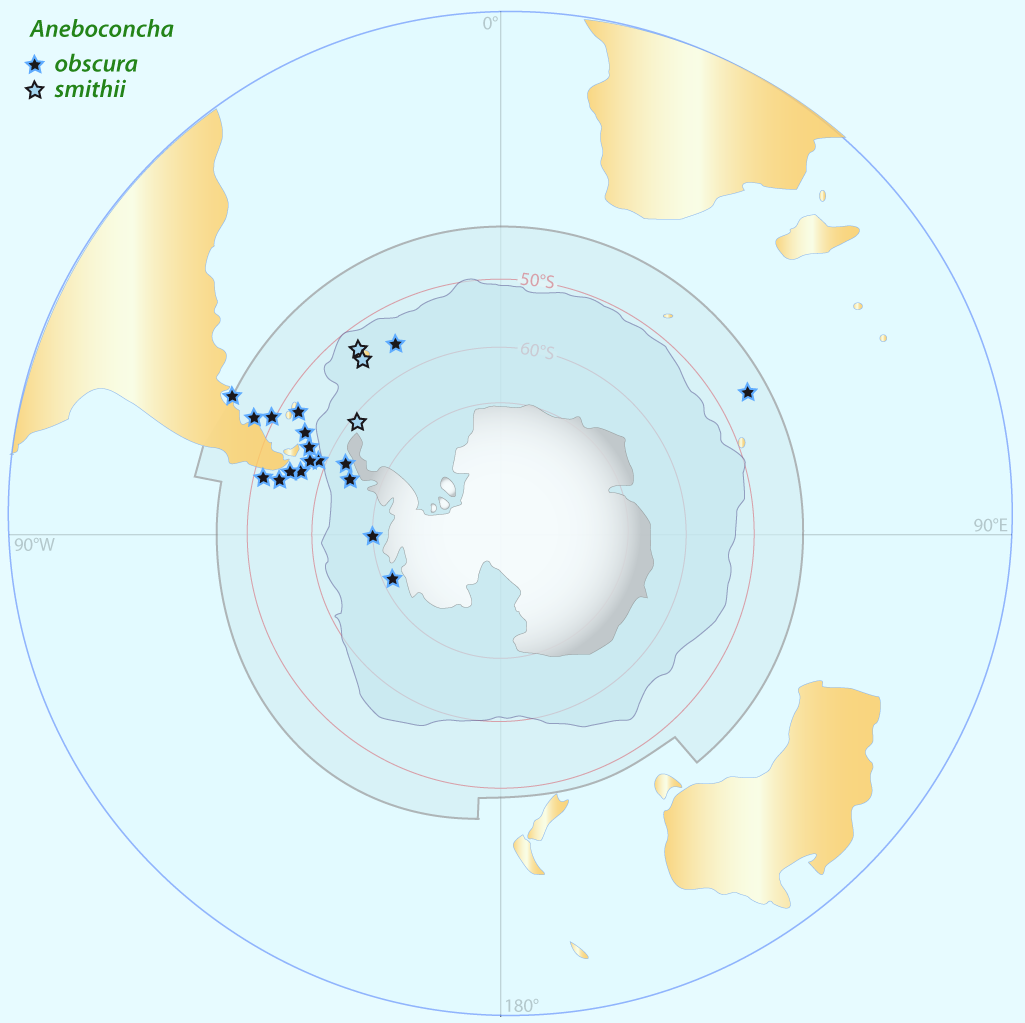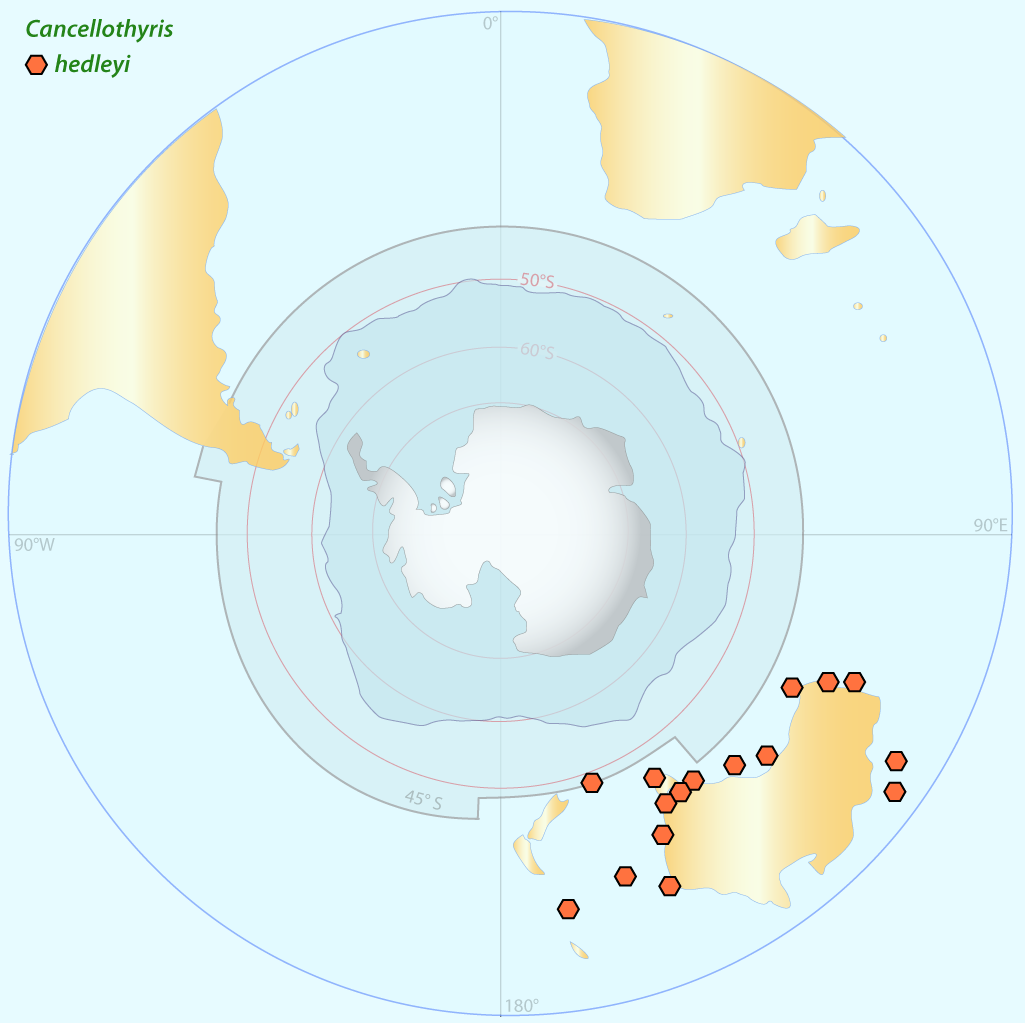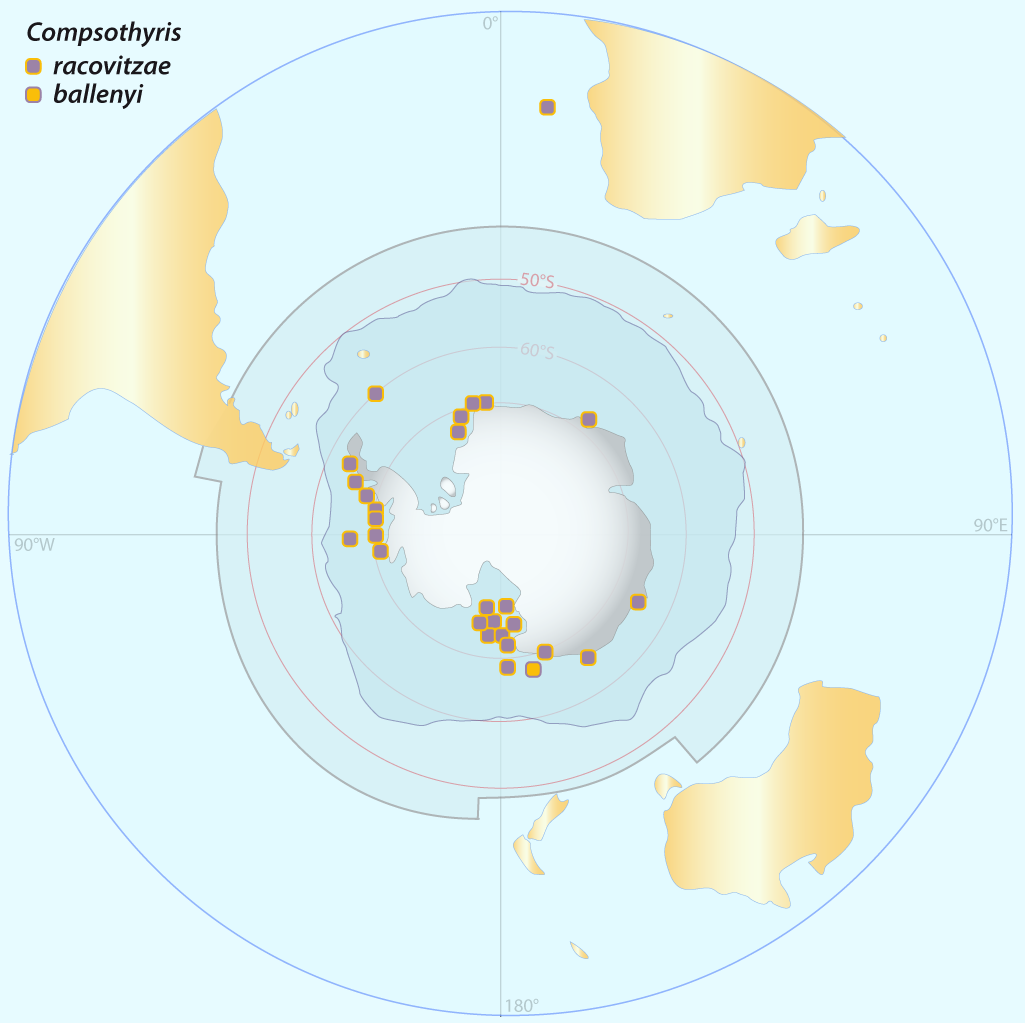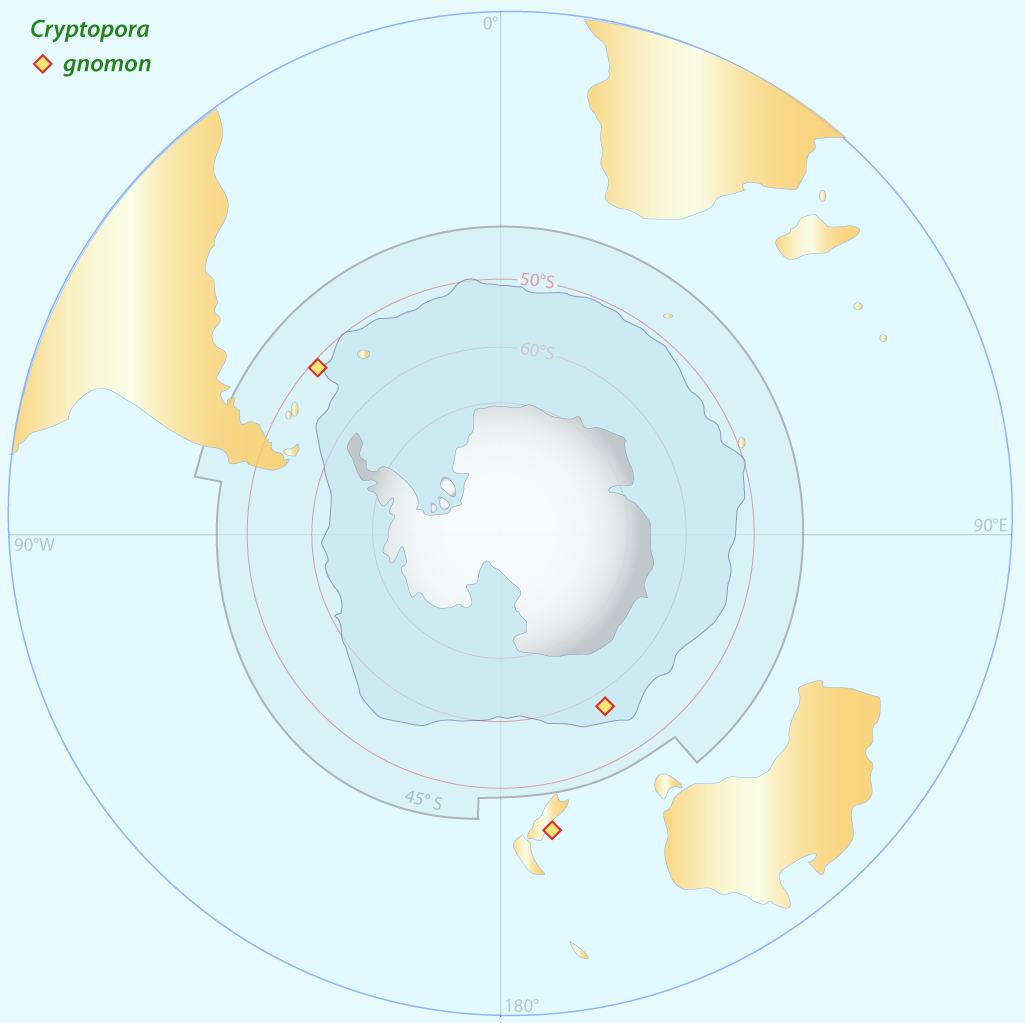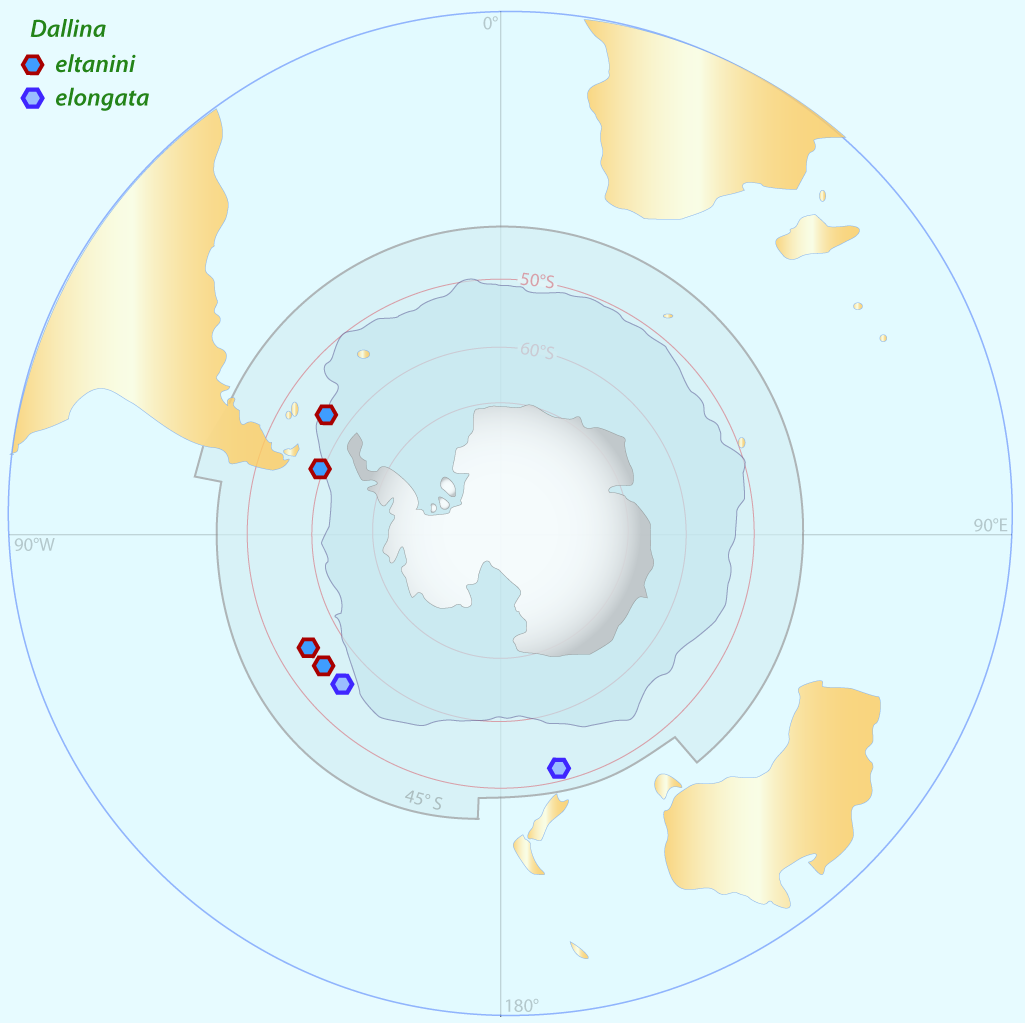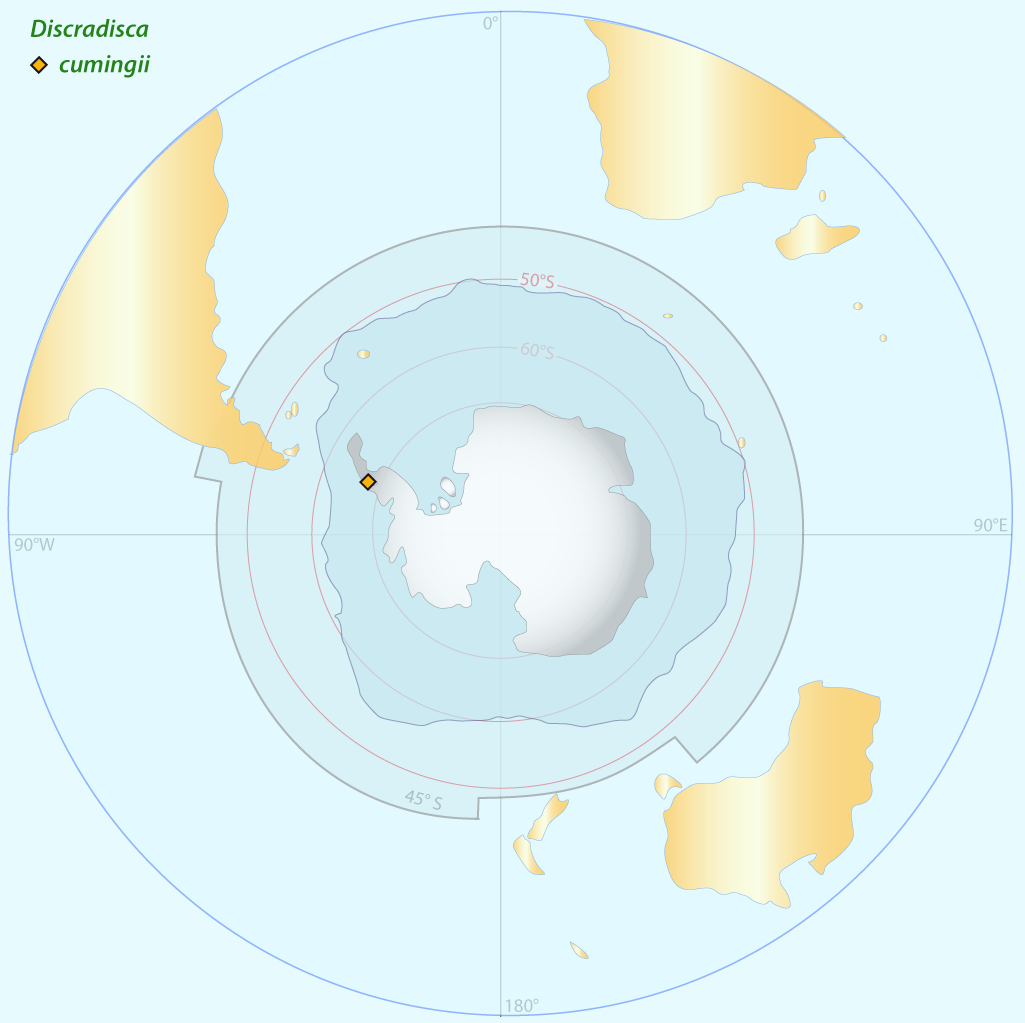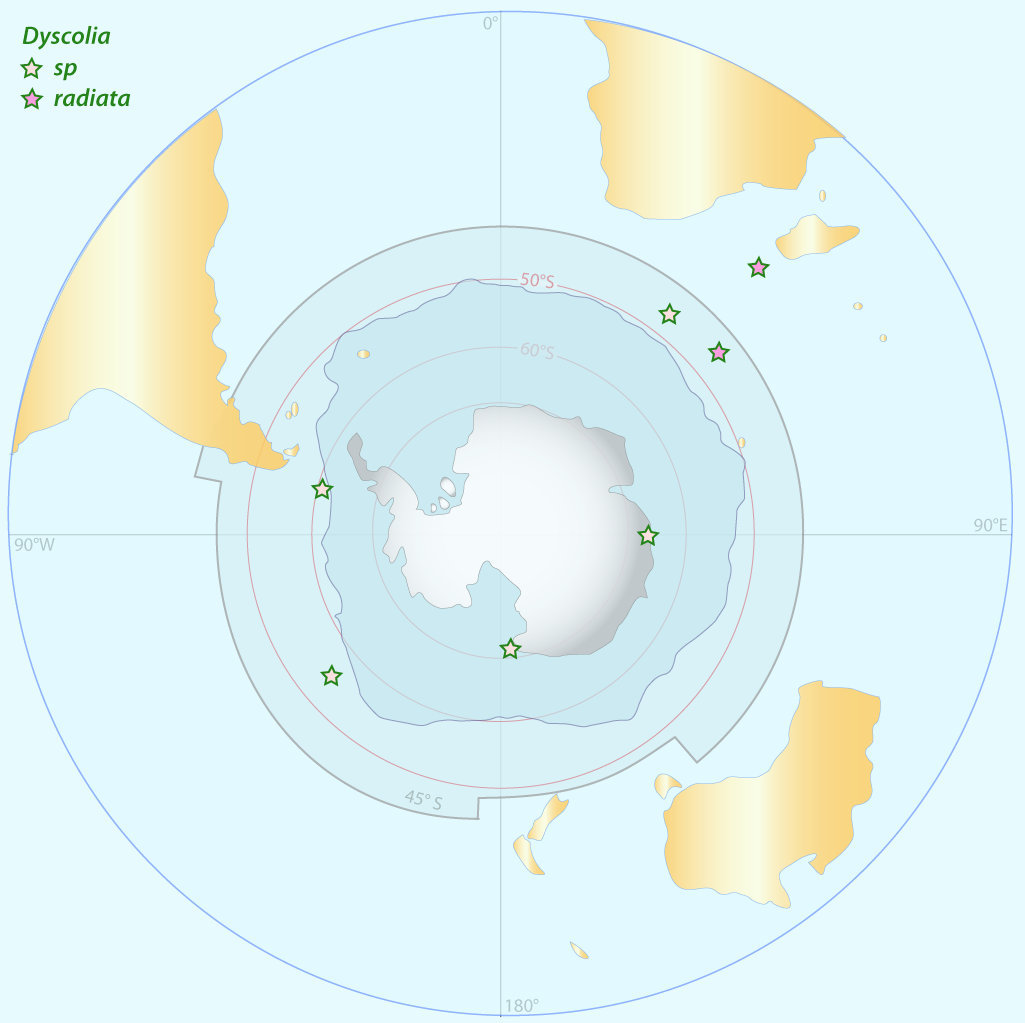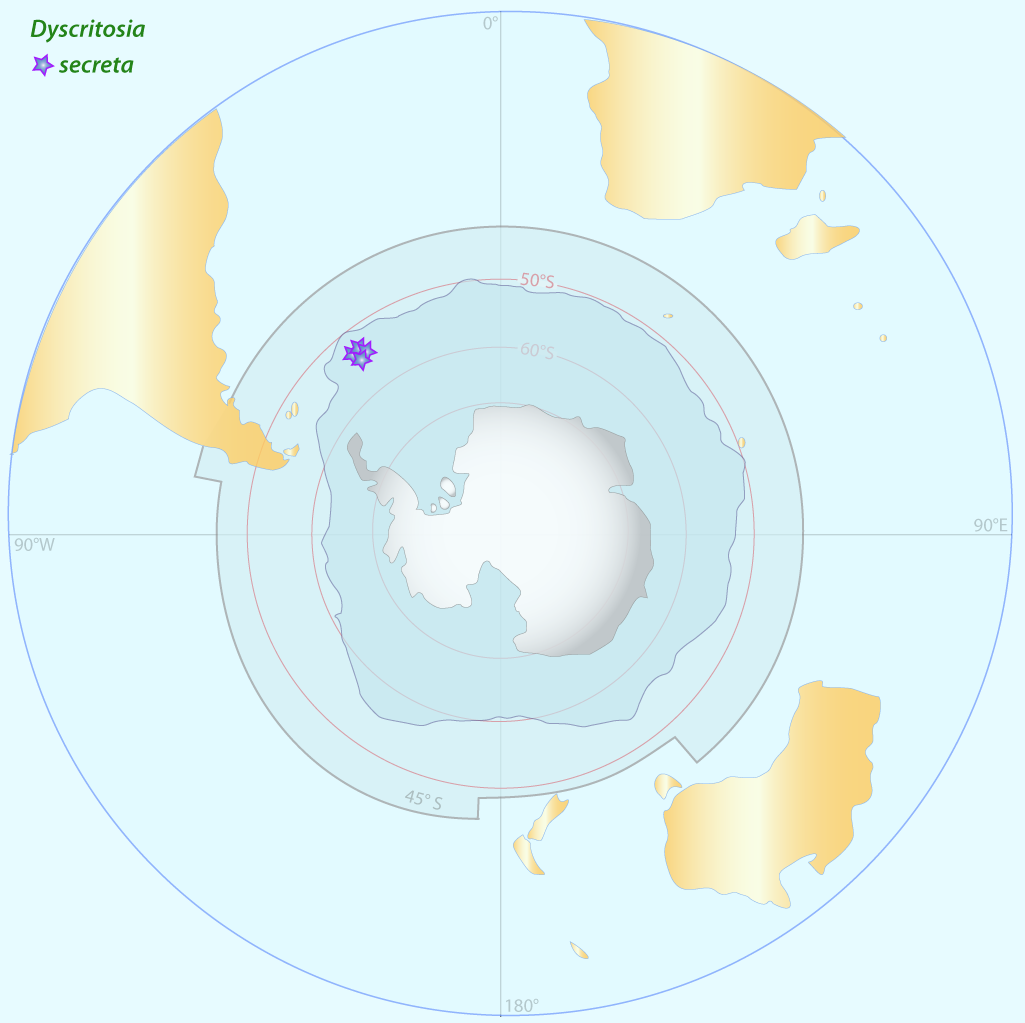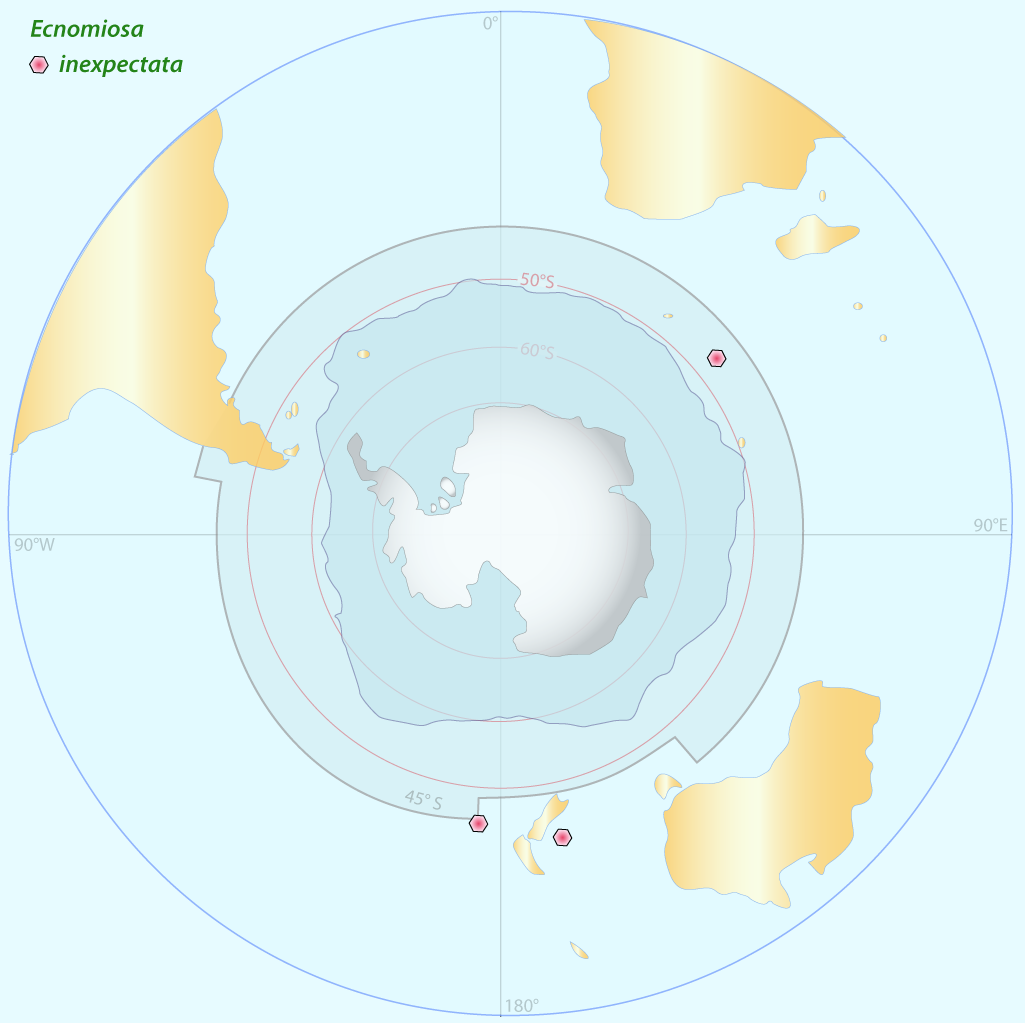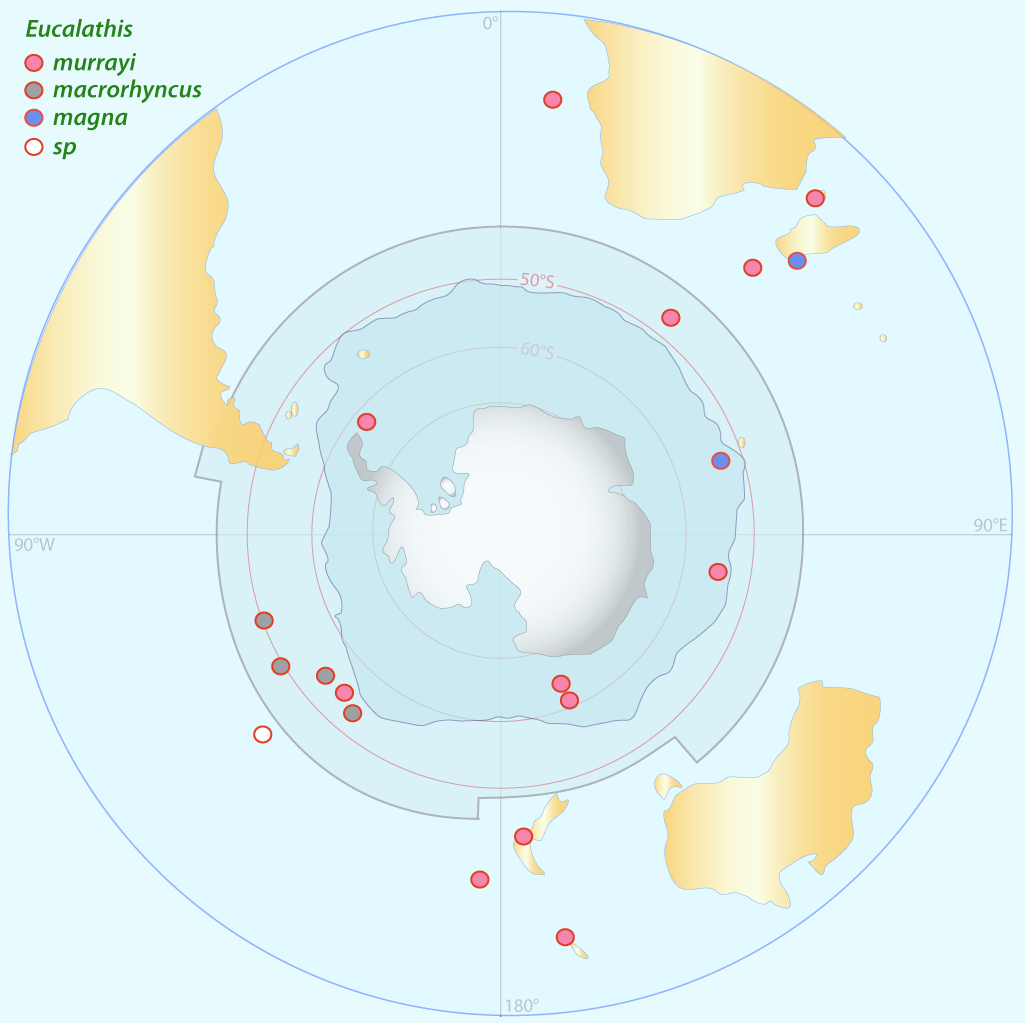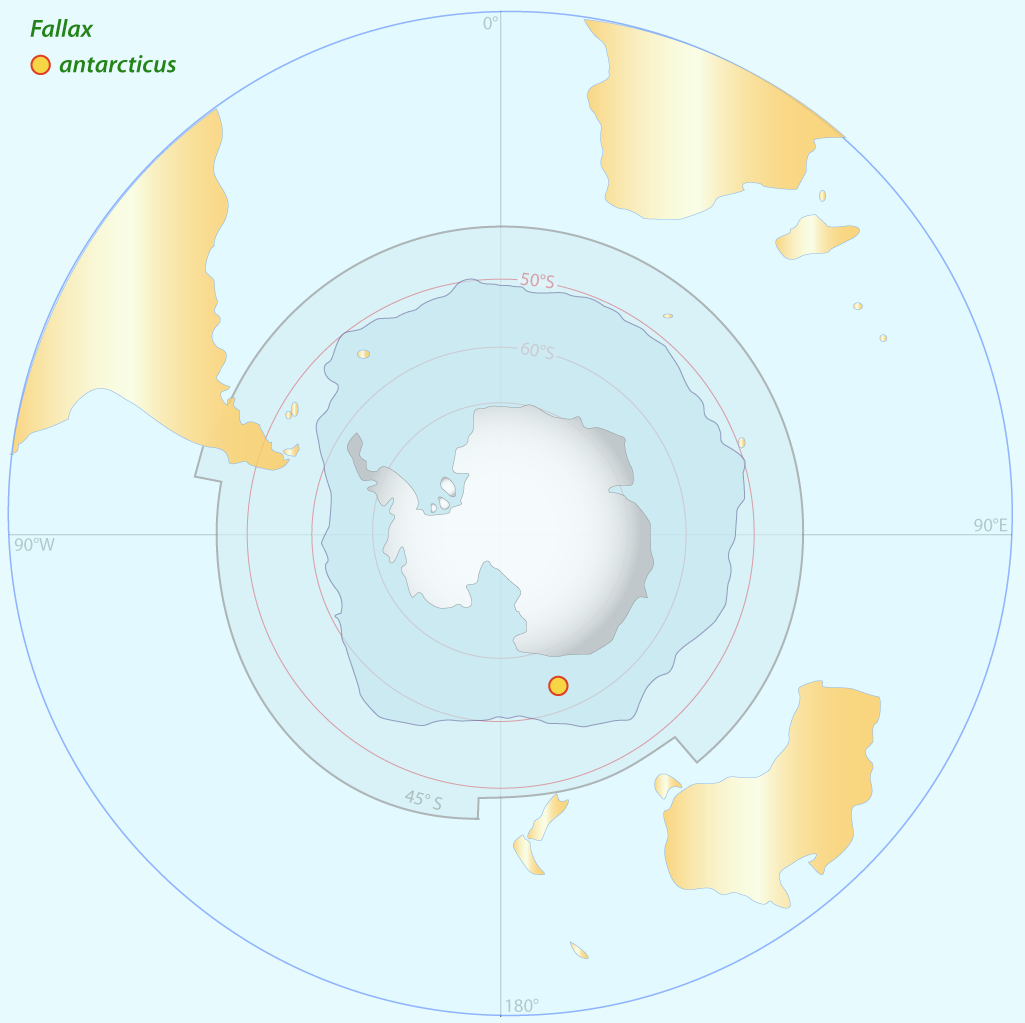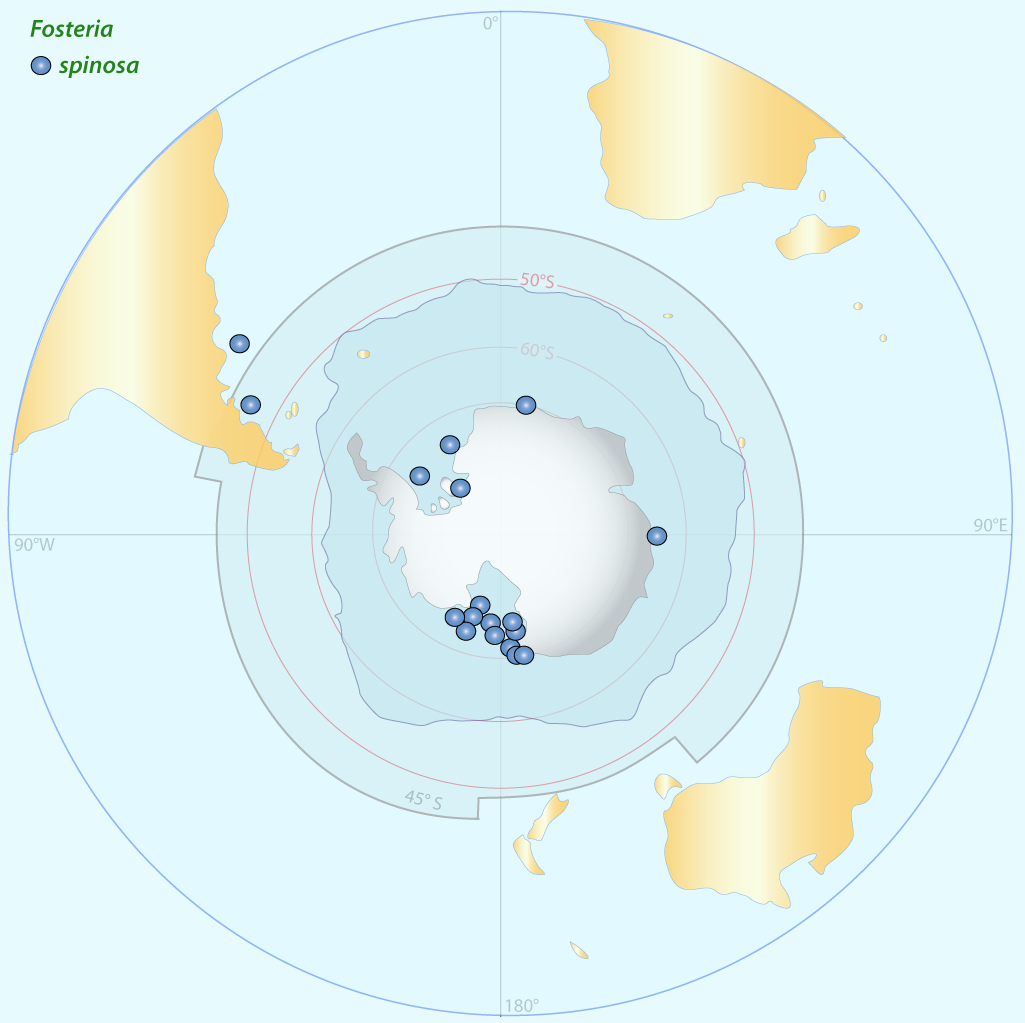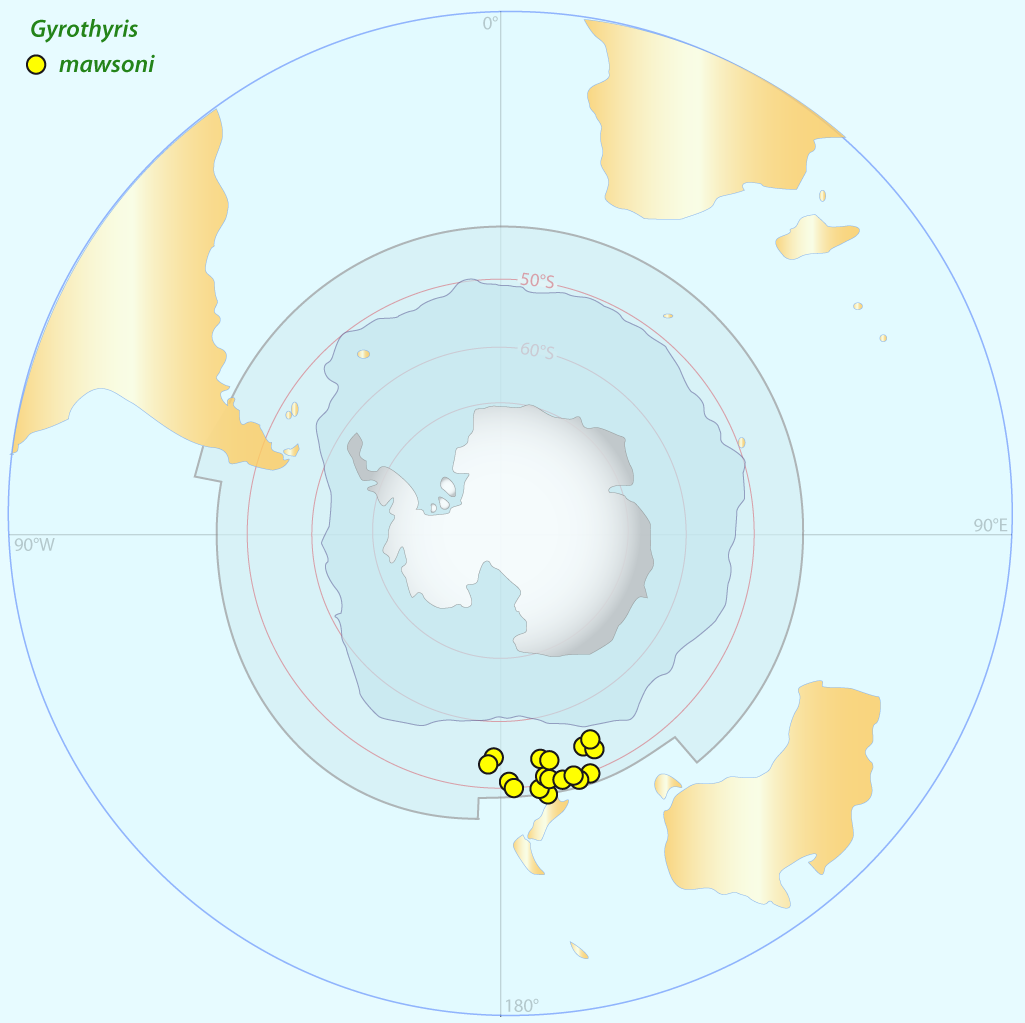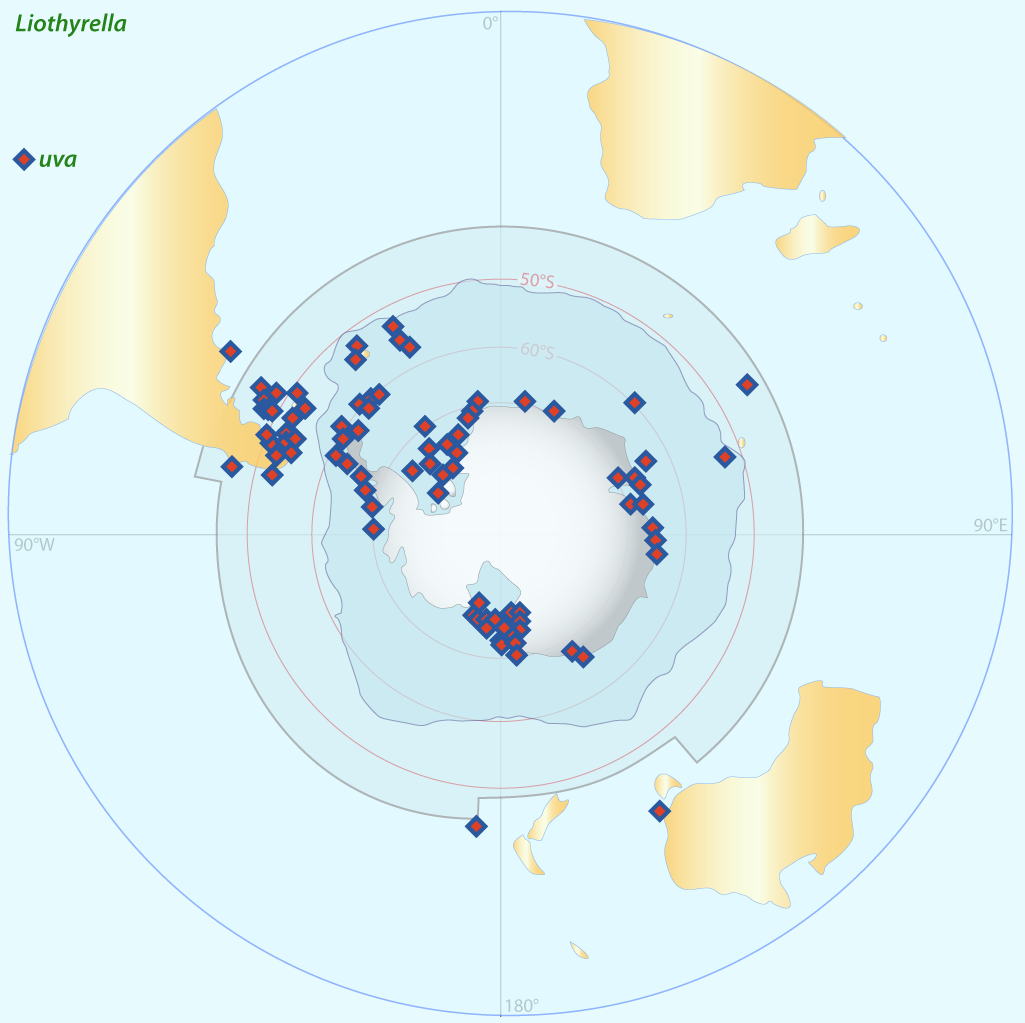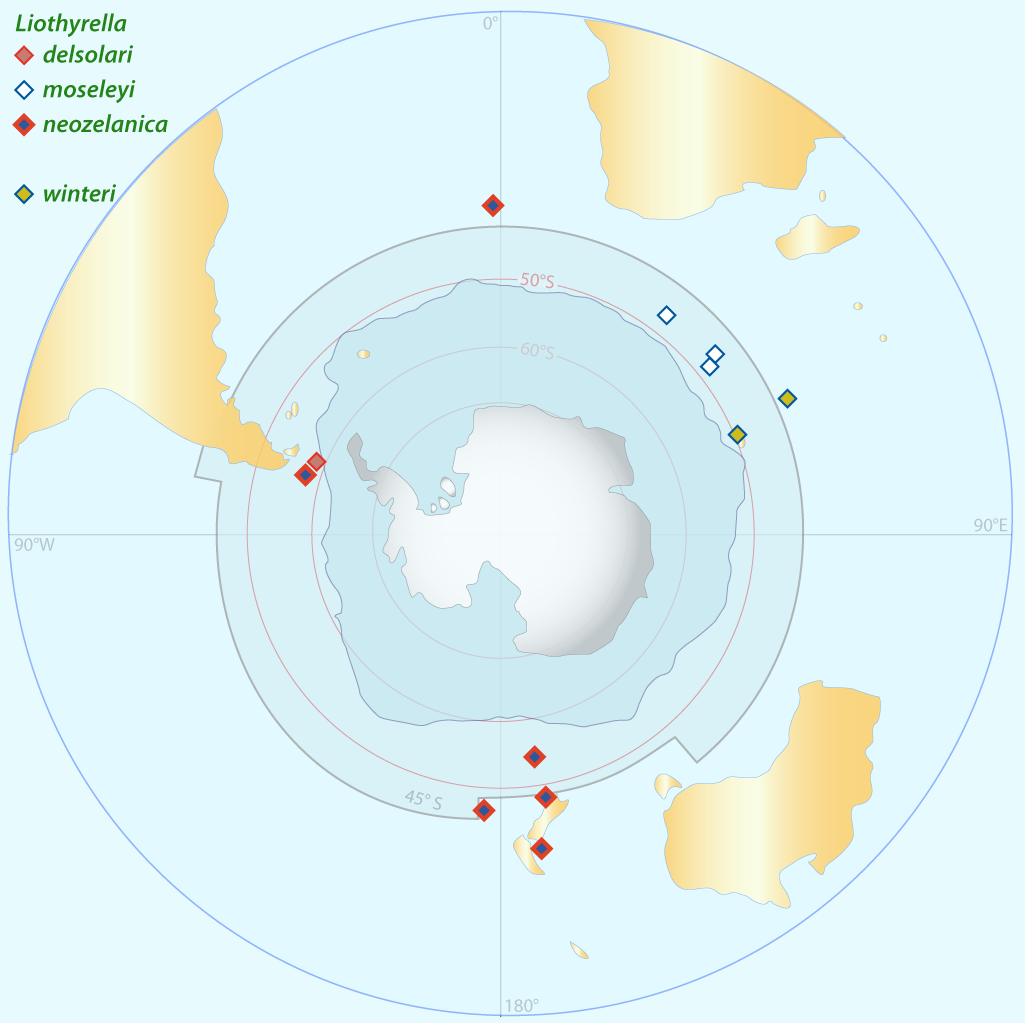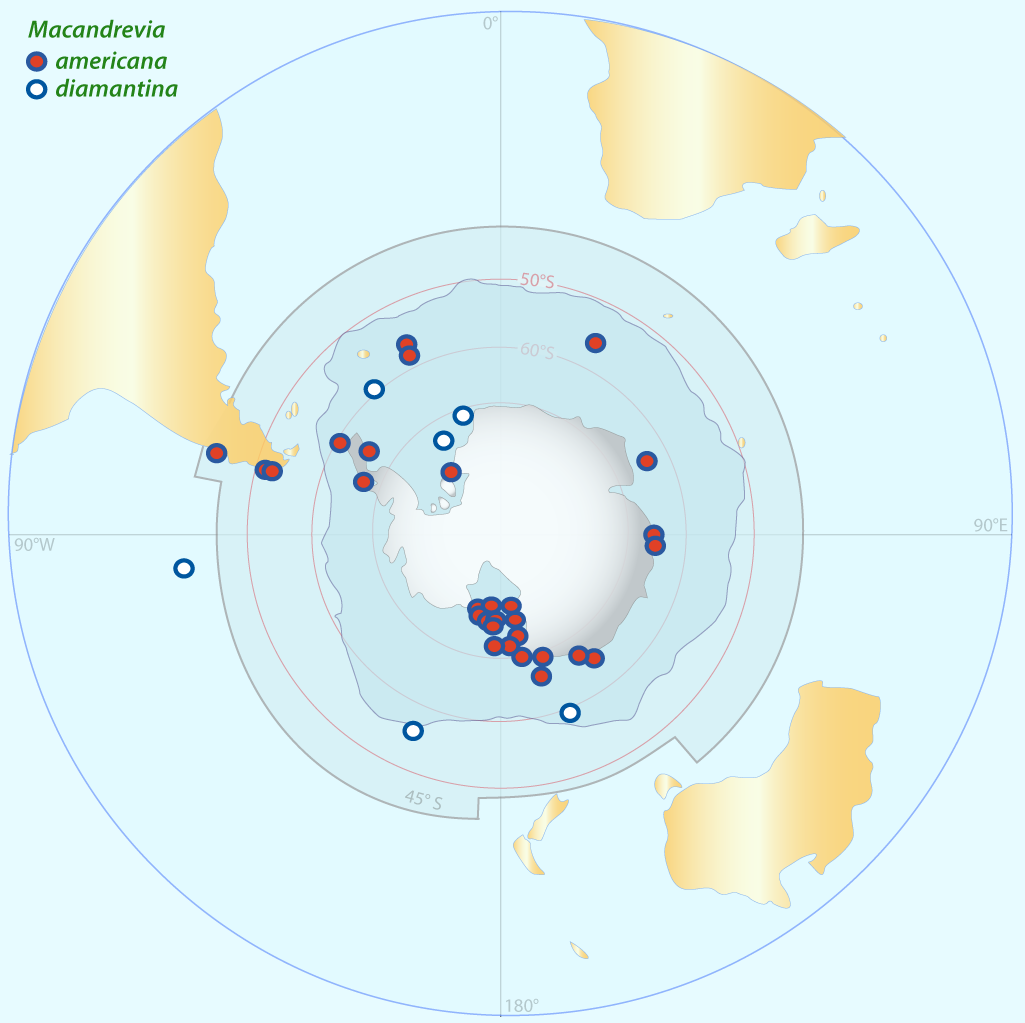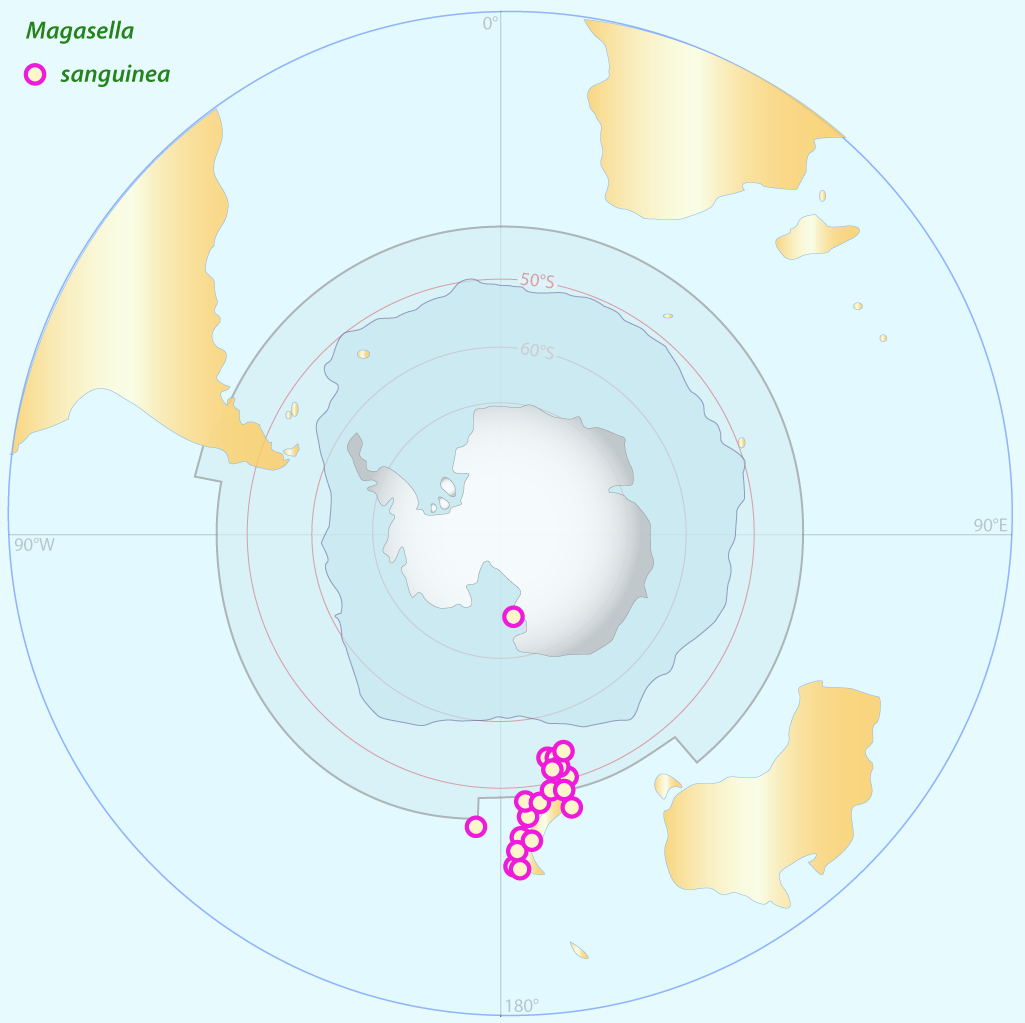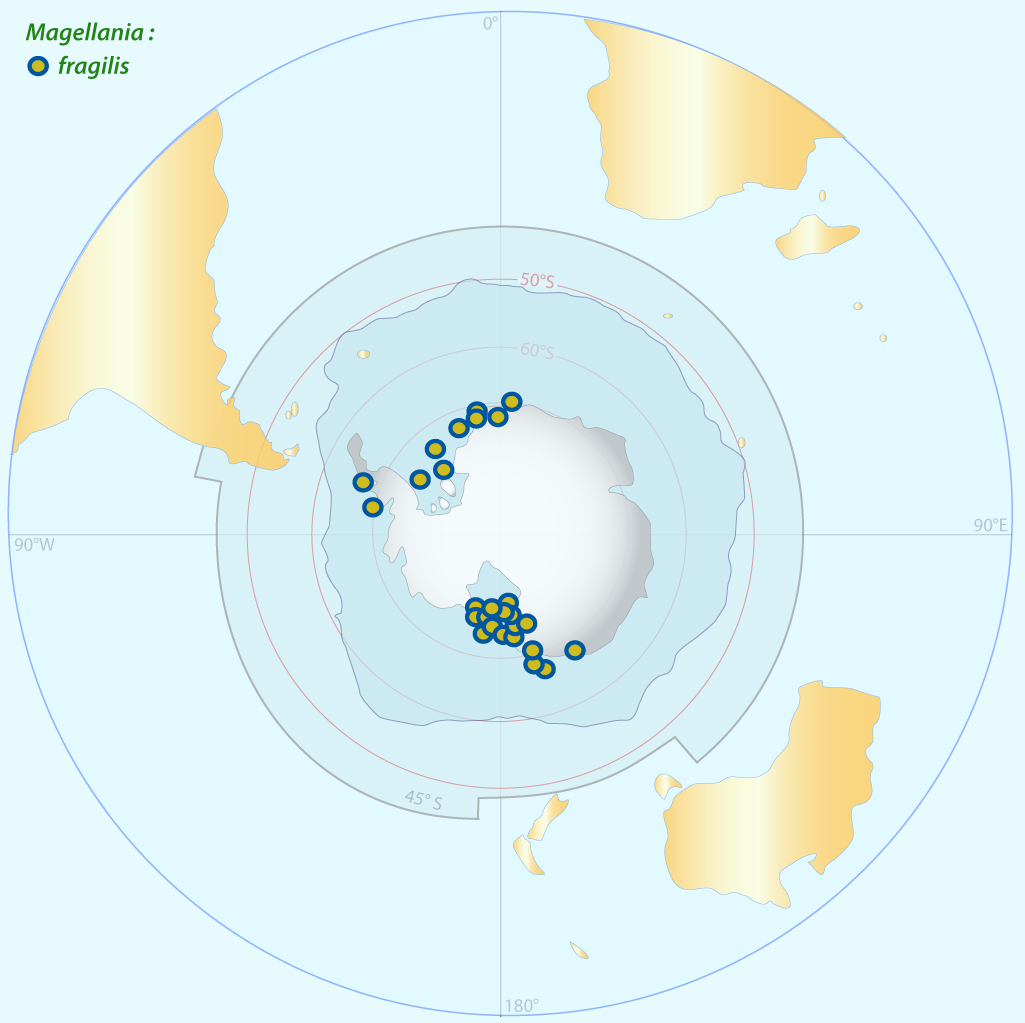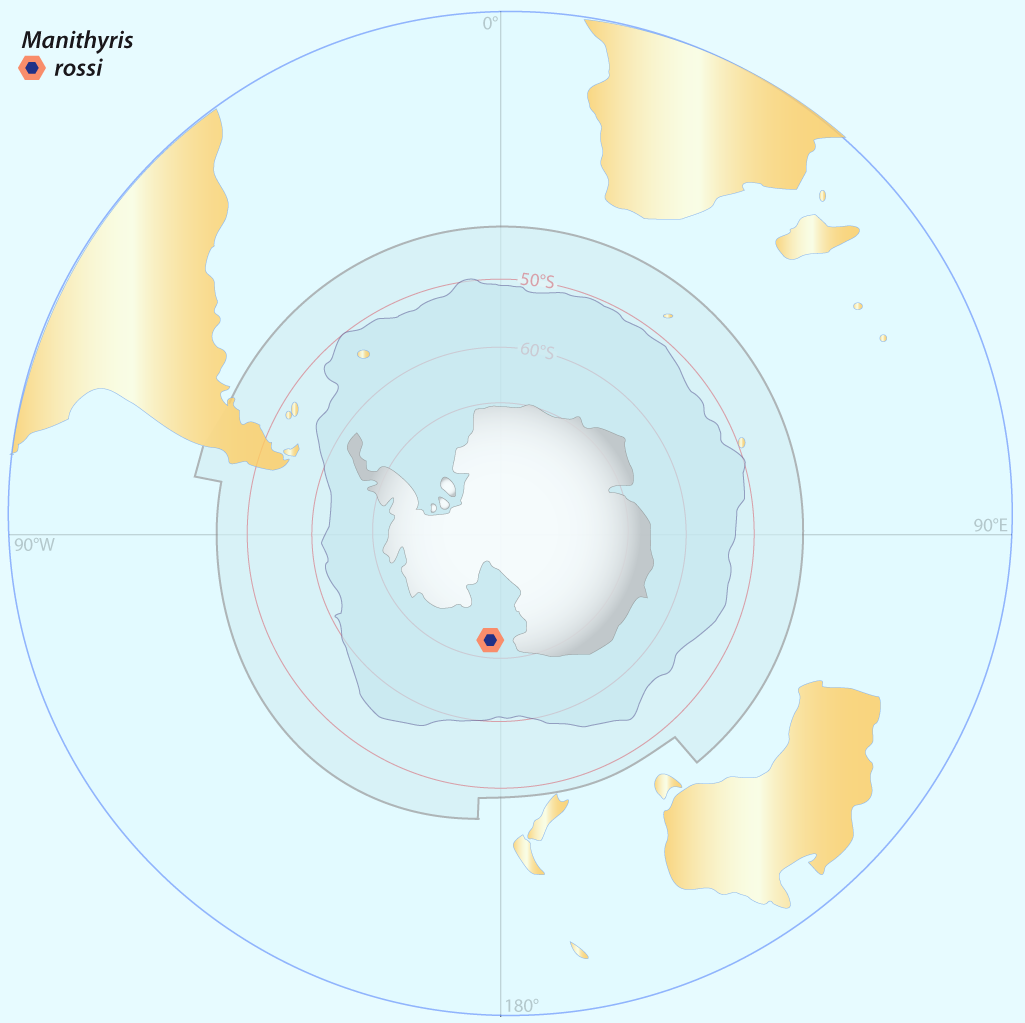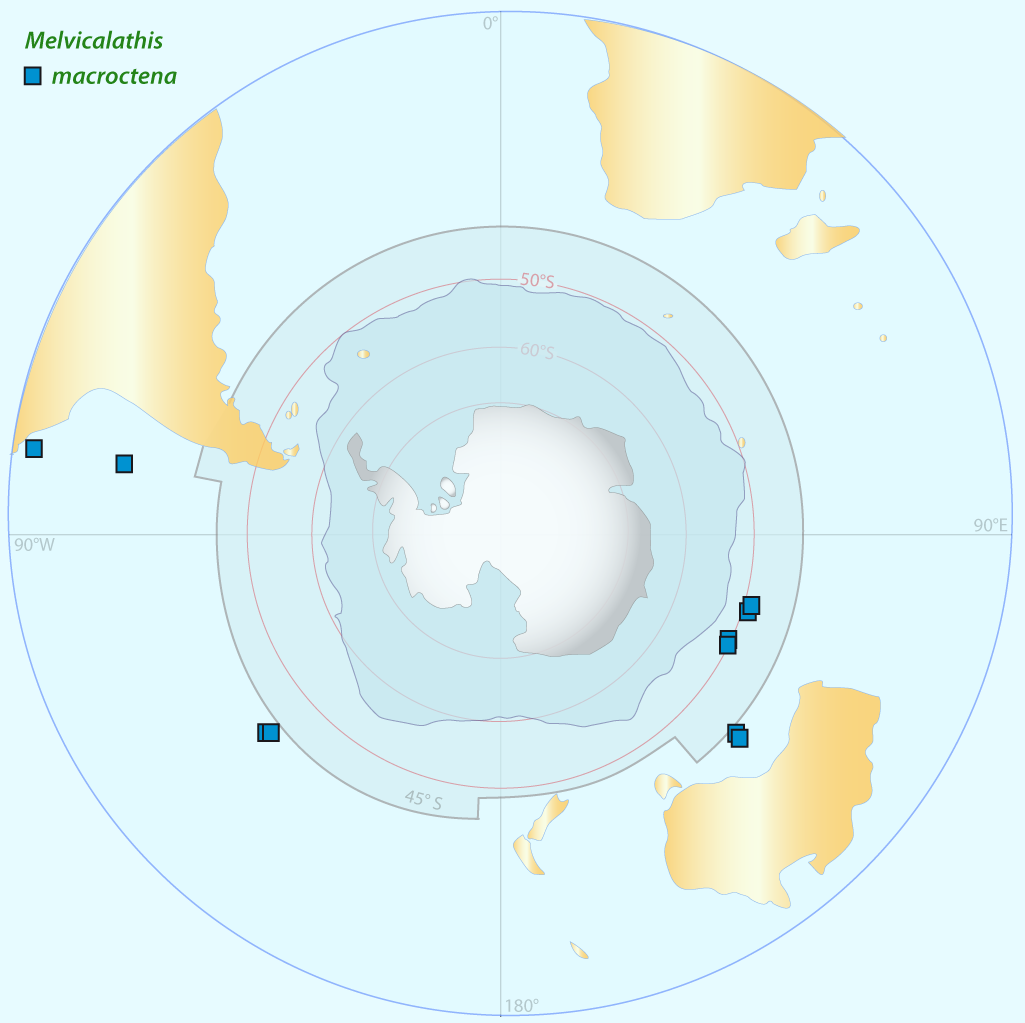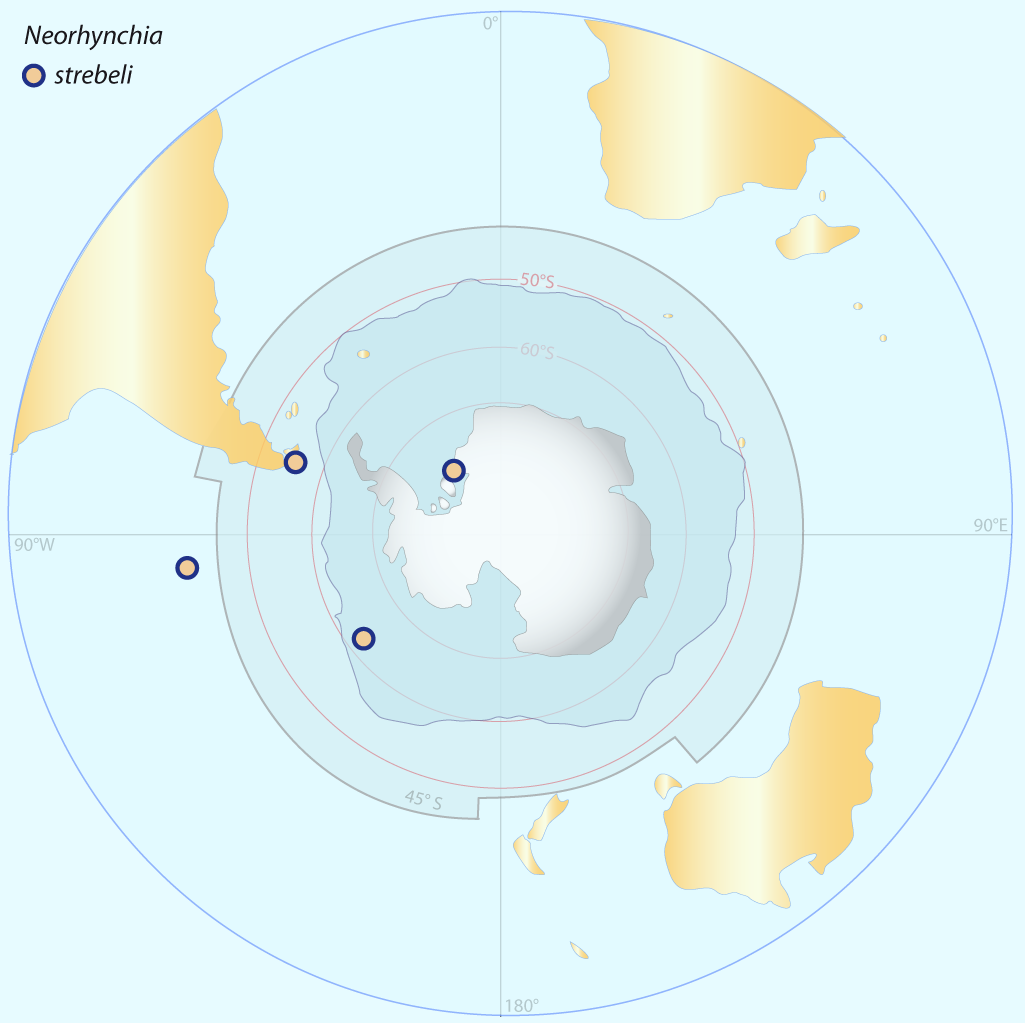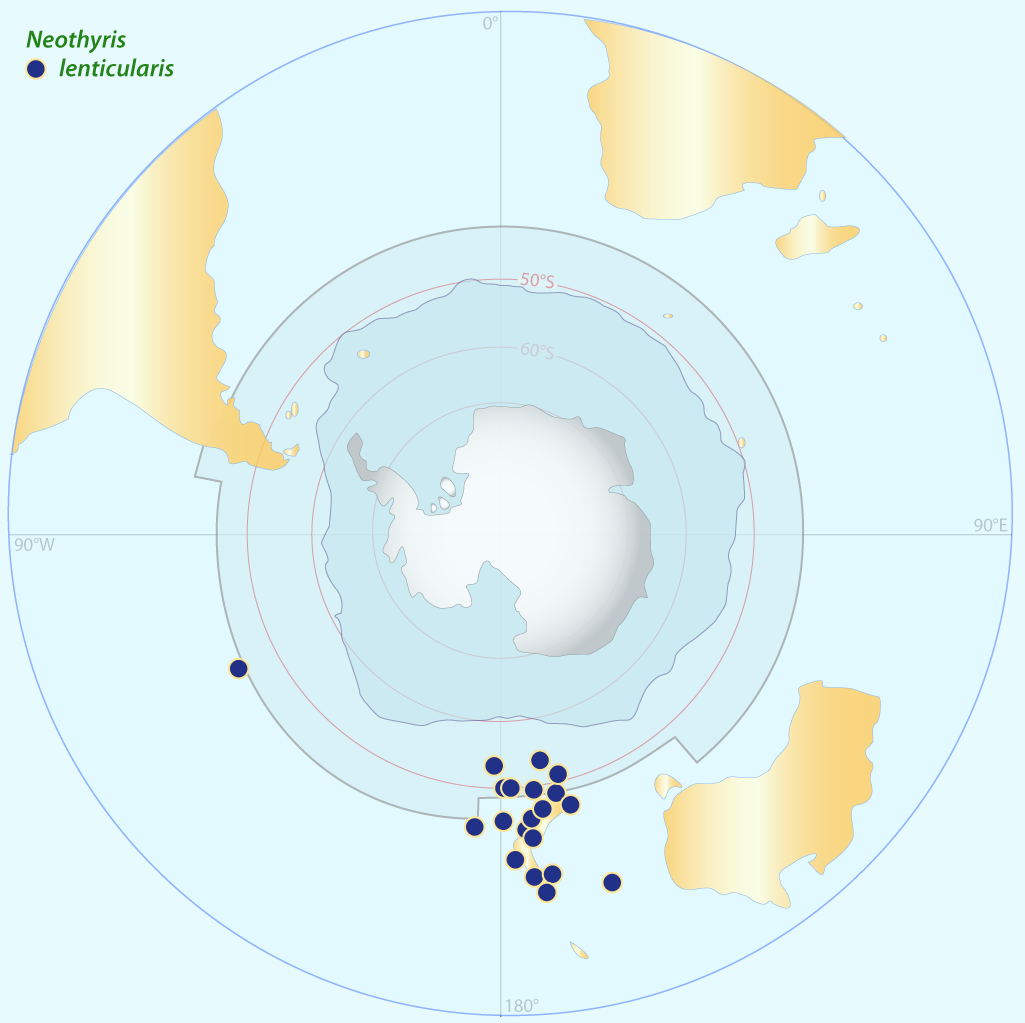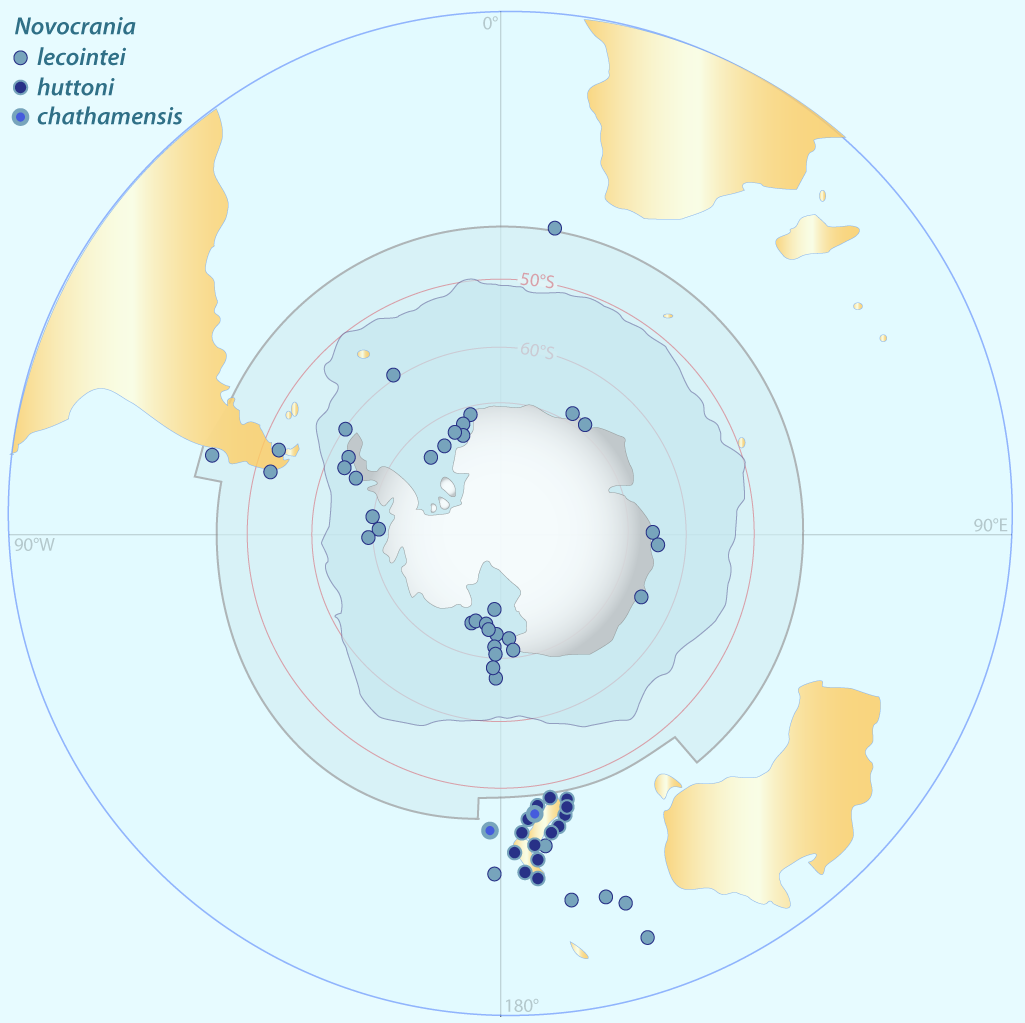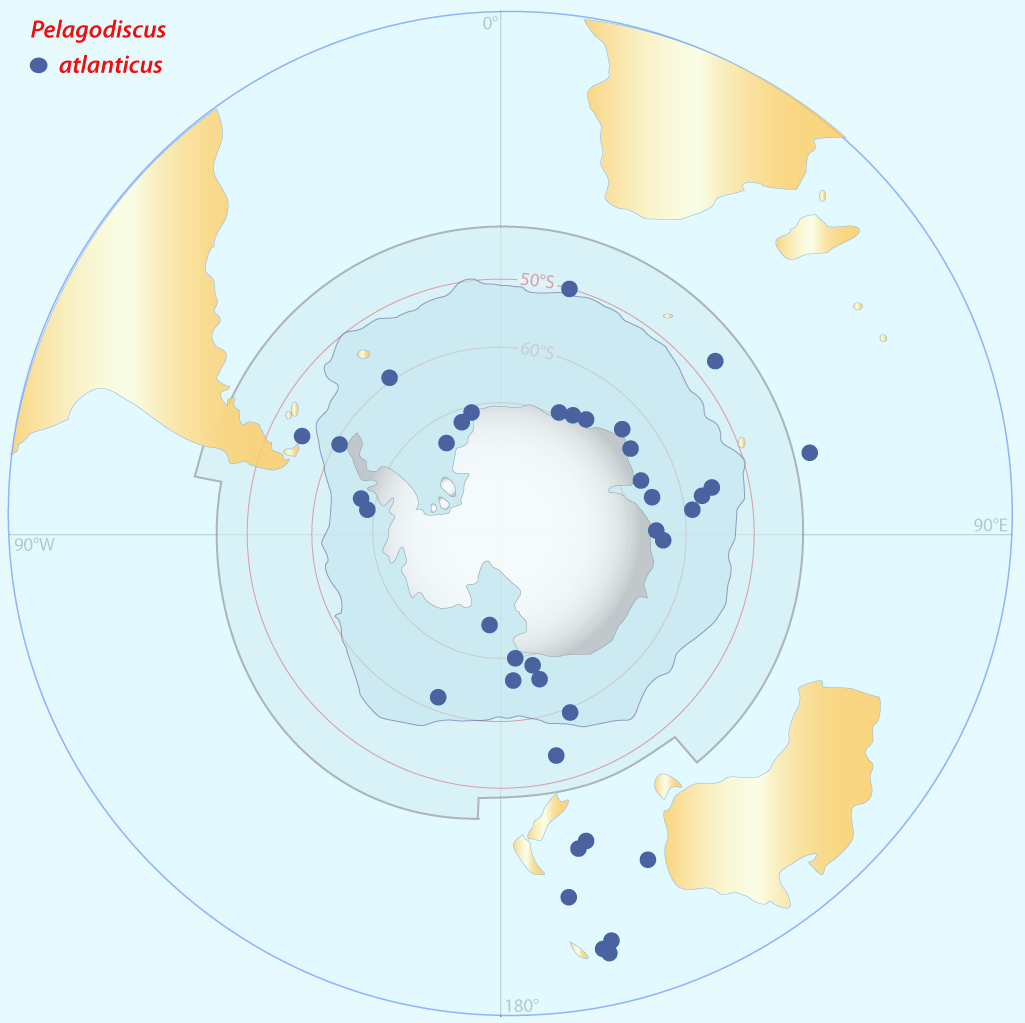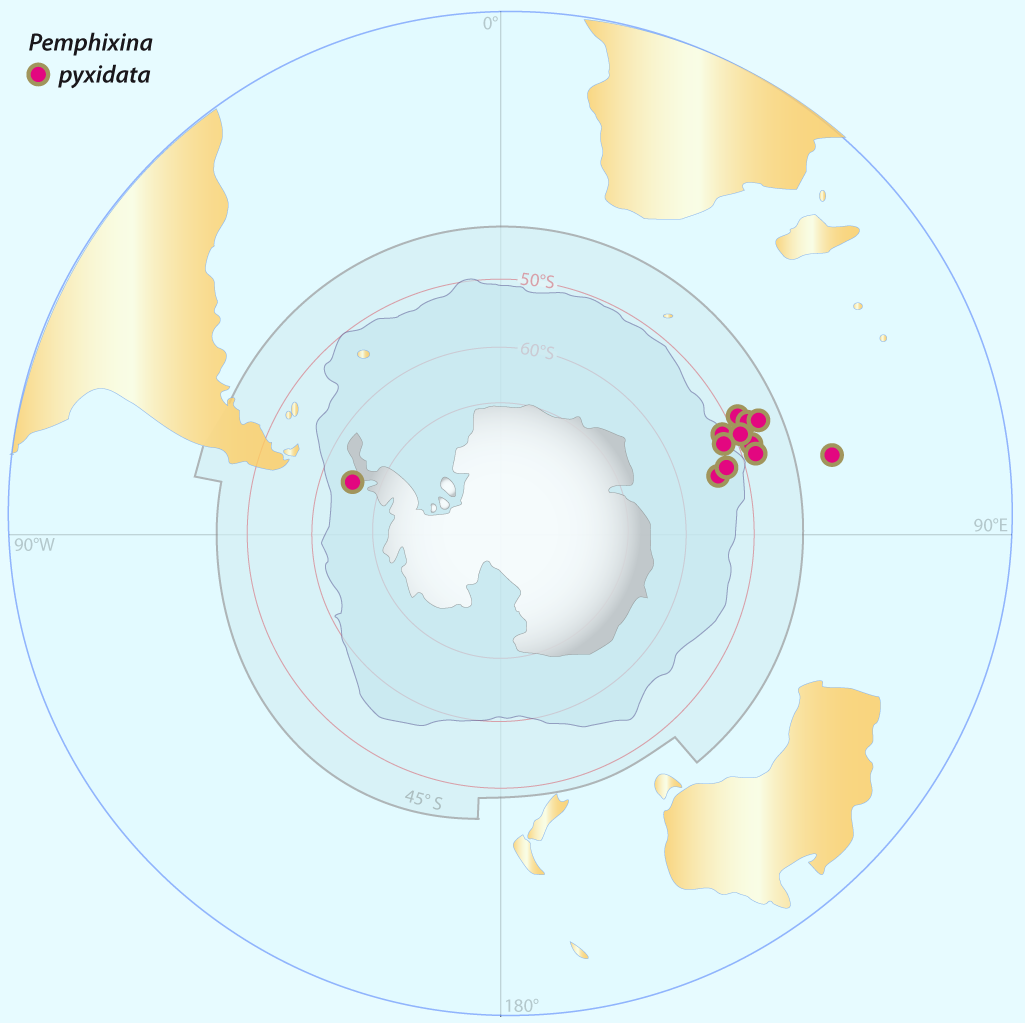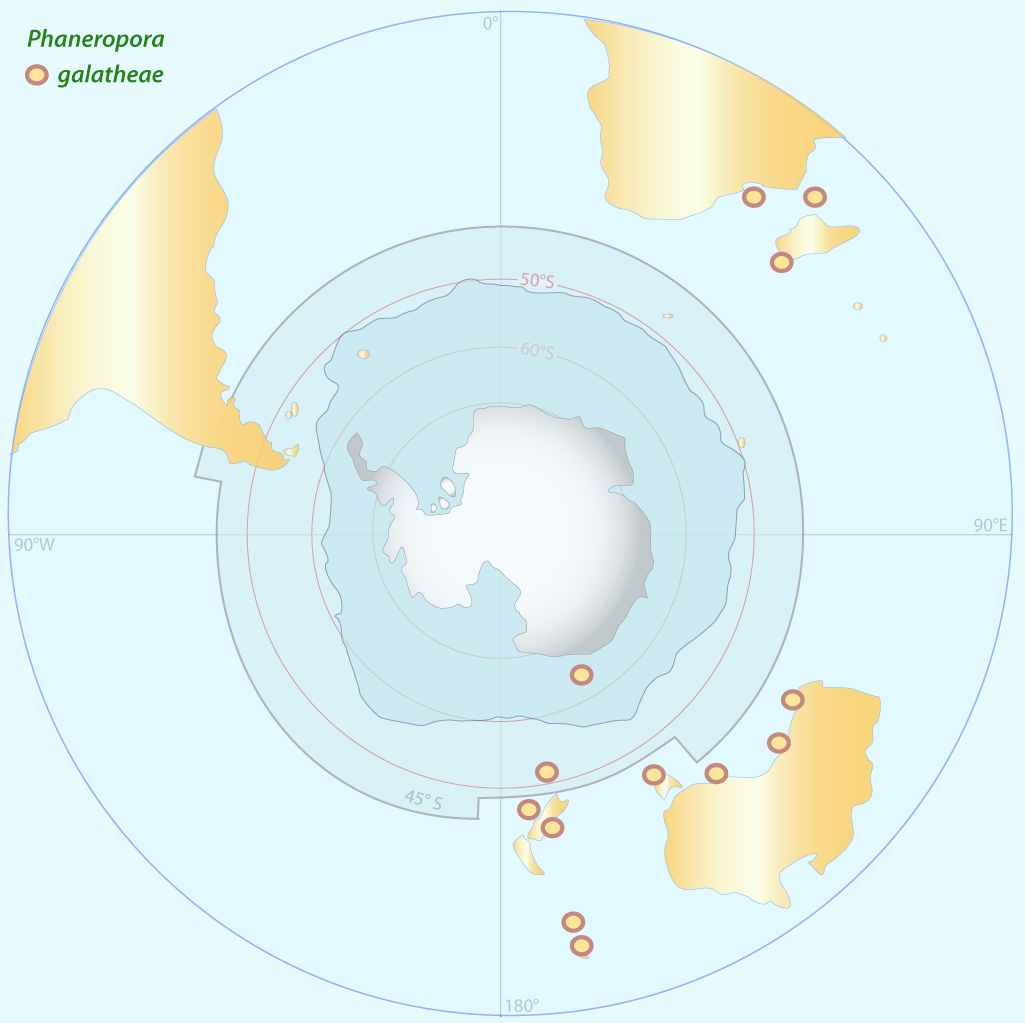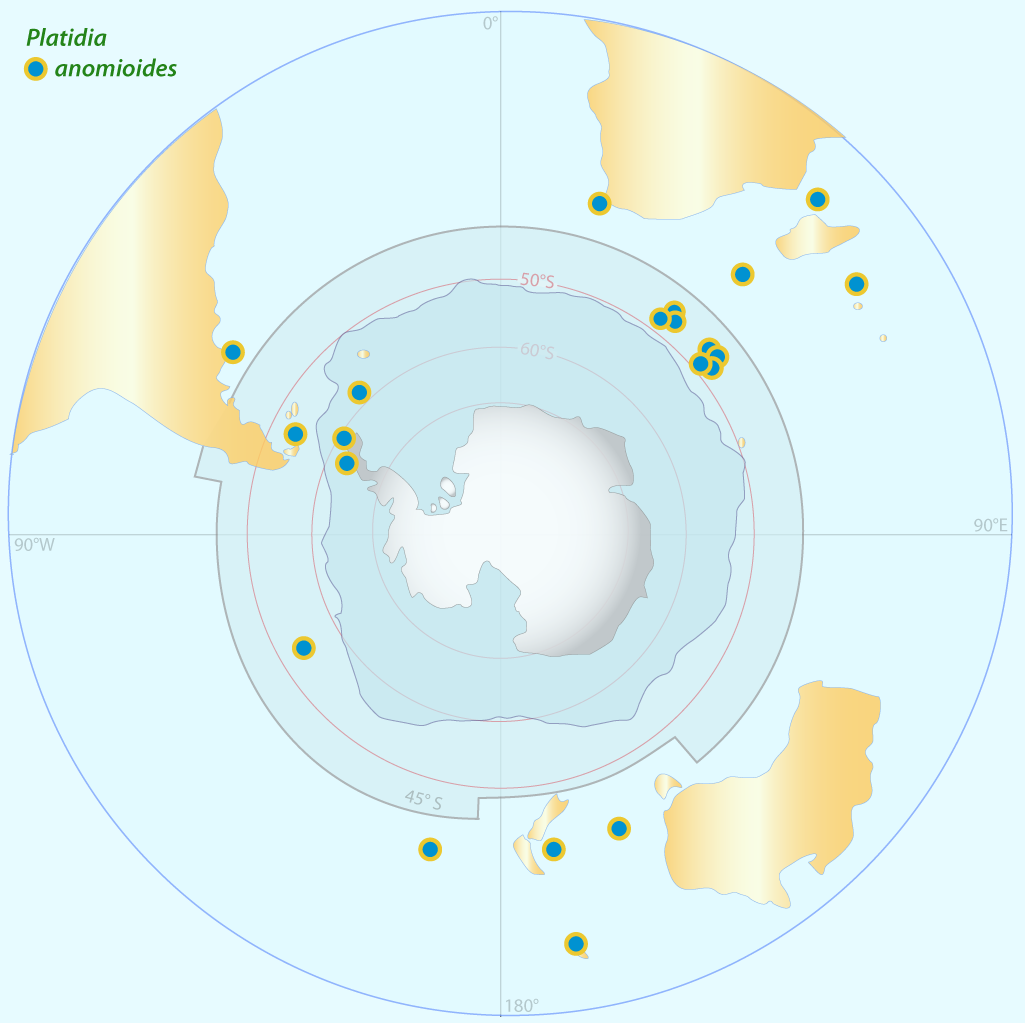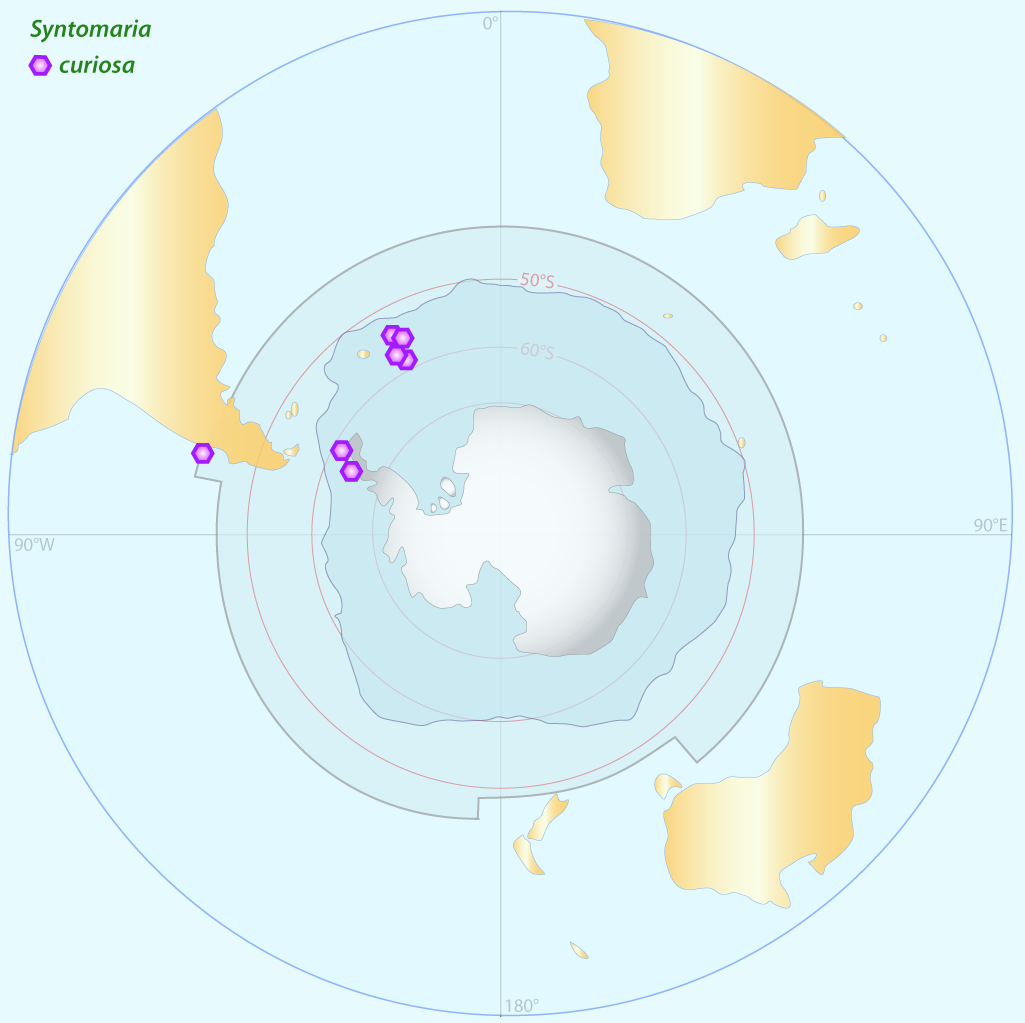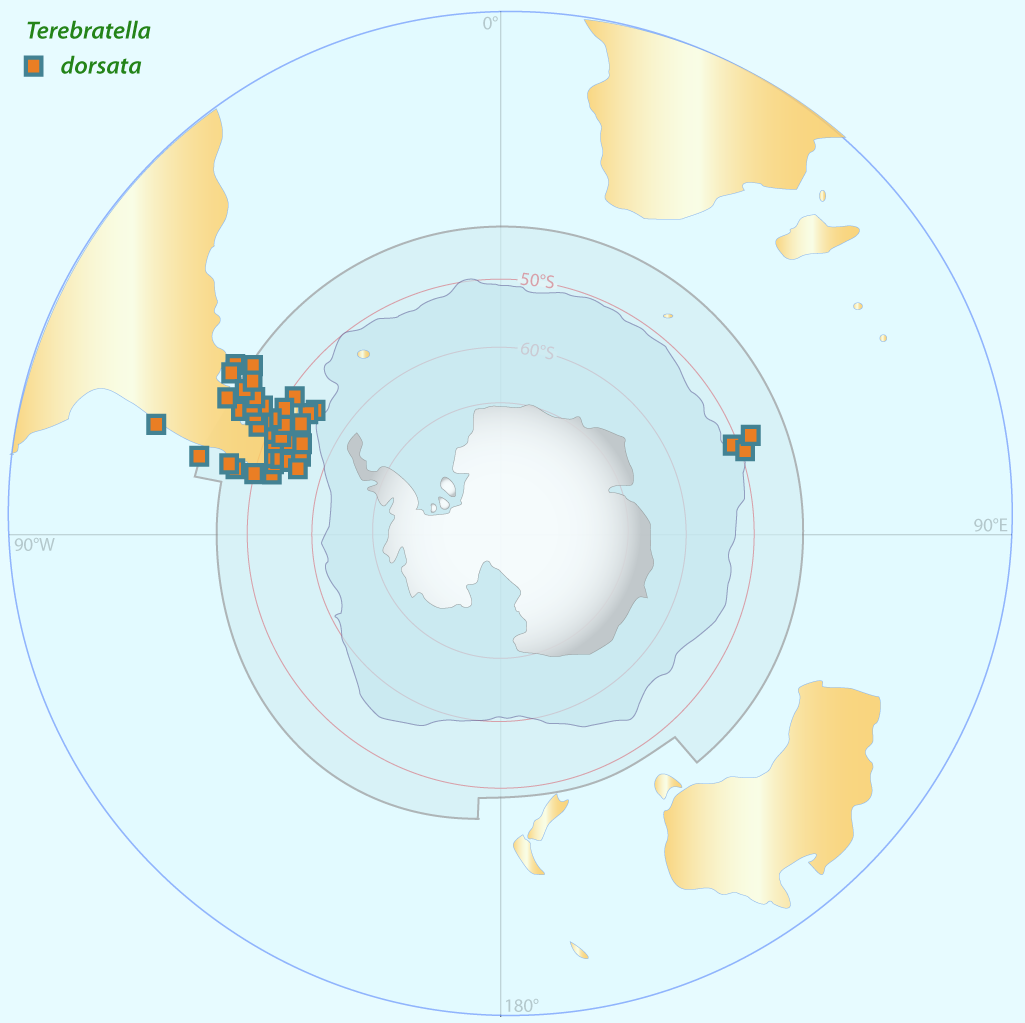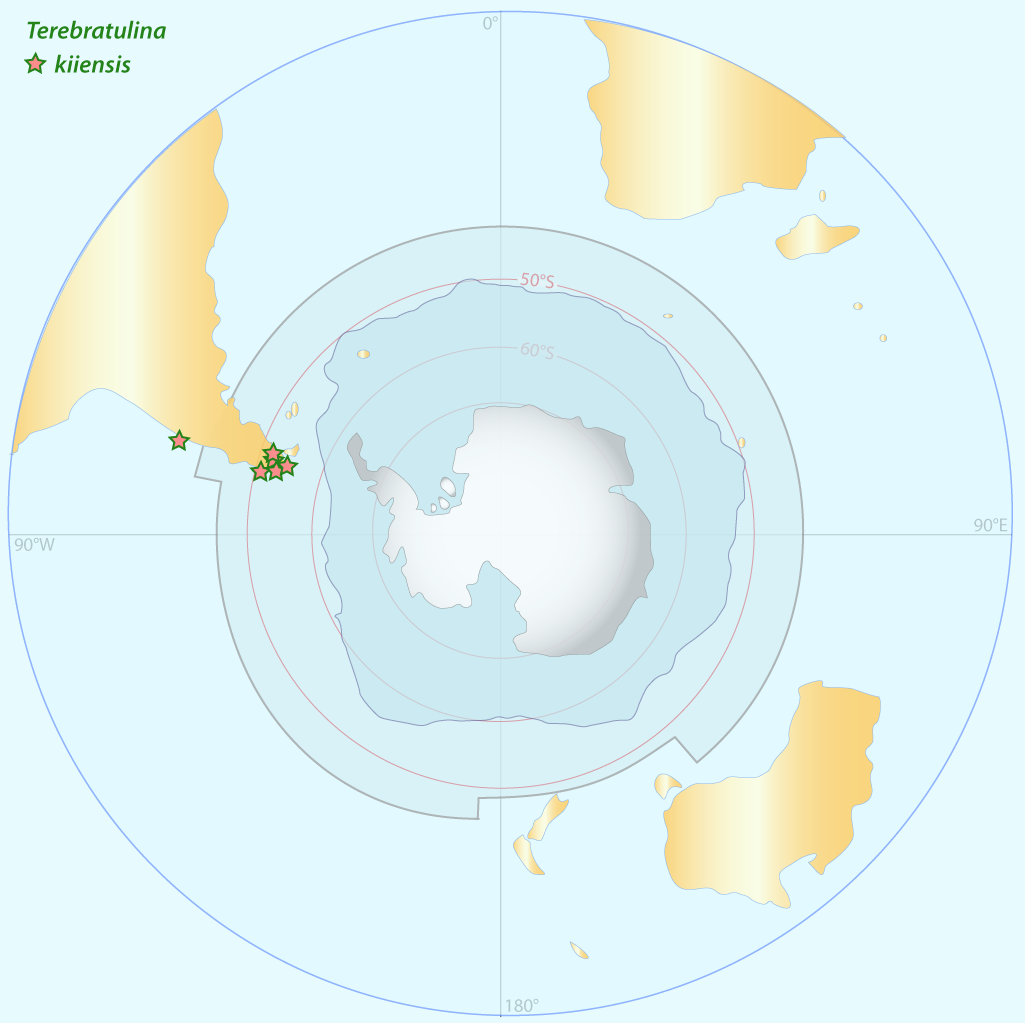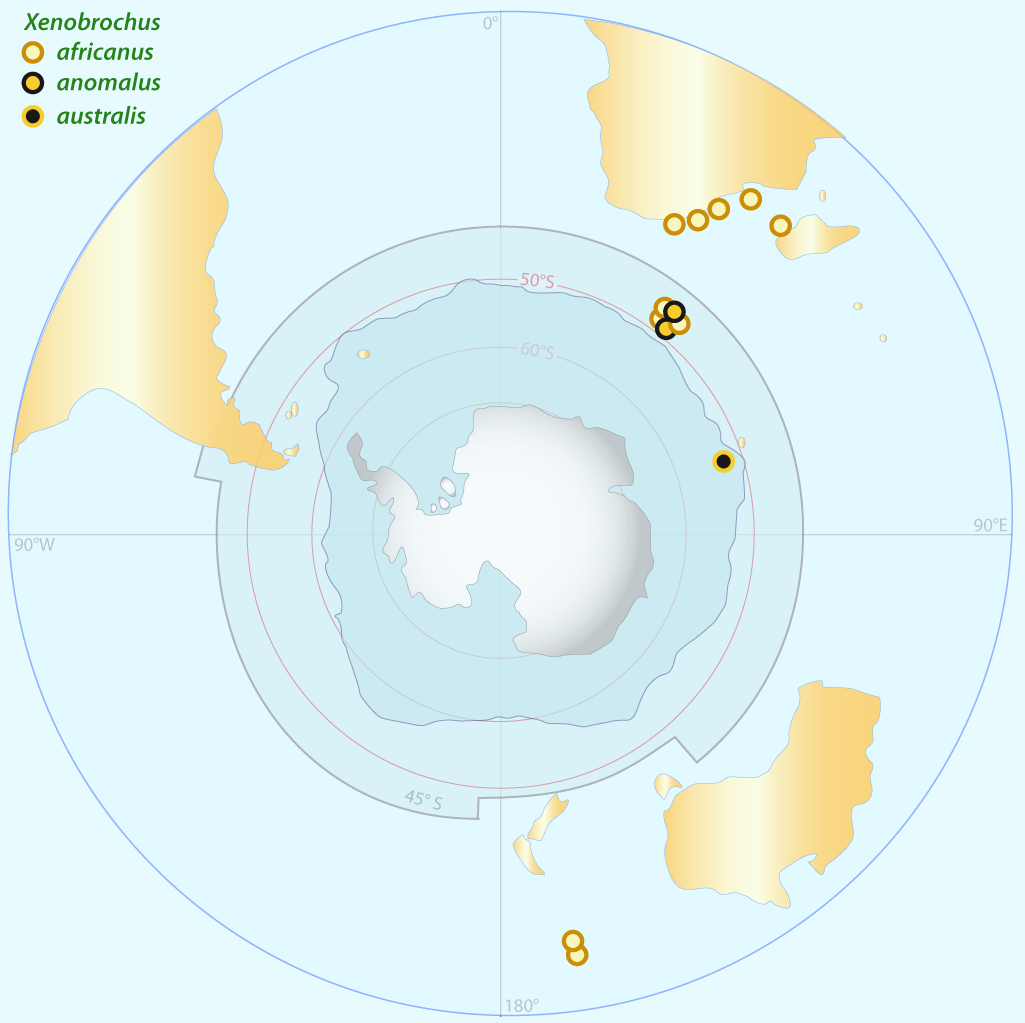
Christian C. Emig
BrachNet, 20, Rue Chaix, F-13007 Marseille (France)
Citation
Emig C.C. (2017).- Atlas of Antarctic and sub-Antarctic Brachiopoda.- Carnets de Géologie, Madrid, CG2017_B03, 93 p.
Manuscript online since August 17, 2017 - ISBN13 : 978-2-916733-15-9
[Editor and technical editor: Christian C. Emig]
Abstract
The specific diversity of Brachiopoda is proposed for the first time in an atlas of the Southern Ocean with maps for each genus in the Antarctic and sub-Antarctic zones. The three sub-phyla Linguliformea, Craniiformea and Rhynchonelliformea are represented: 51 species, belonging to 35 genera occur on a surface area covering about 20% of World Ocean. The low diversity in those zones is confirmed by the occurrence of only 12.6% of the total number of extant species of brachiopods (402) and of 29.4% of that of the genera (119). The absence of reliable diagnoses in most of the species makes difficult some comparisons and attributions. In the future several of these species and even genera could be considered as synonymous.
Keywords: brachiopod; diversity; Antarctic; sub-Antarctic; atlas.
Résumé
Atlas des brachiopodes antarctiques et sub-antarctiques.- La diversité spécifique des Brachiopoda est proposée pour la première fois dans l'Océan Austral (ou glacial antarctique) sous forme d'un atlas avec des cartes pour chaque genre dans les zones antarctiques et sub-antarctiques. Les trois sub-phylums Linguliformea, Craniiformea et Rhynchonelliformea sont représentés : 51 espèces, appartenant à 35 genres. La faible diversité dans ces zones est confirmée par la présence de seulement 12,6% du nombre total d'espèces actuelles de brachiopodes (402) et de 29,4% de celui des genres (119). L'absence de diagnoses fiables dans pratiquement toutes les espèces rend difficile certaines comparaisons et attributions. Plusieurs de ces espèces et même genres pourraient se révéler être synonymes.
Mots-clés : brachiopod ; diversité ; antarctique ; sub-antarctique ; atlas.
Introduction
Brachiopods, commonly known as lamp-shells, are lophophorate animals found only in marine waters. They are bilaterally symmetrical solitary coelomates, sessile benthic suspension-feeders, enclosed in a shell formed by a dorsal and a ventral valve, and fixed to or into the substrate by a pedicle. However, some taxa lacking a pedicle are cemented to the substratum by one of their valves, i.e., Novocrania. Brachiopods range in size from a few millimetres to over eight centimetres. The pedicle can adjust the position of the organism in relation to its surroundings (see Richardson, 1997; Emig, 1997). The lophophore, usually supported by a brachidium, varies in complexity among the taxa. Larvae are either planktotrophic or non-planktotrophic.
Brachiopods are one of the most ancient zoological groups with a long evolutionary history from before Precambrian to Holocene times. Extremely abundant during the Palaeozoic, especially during the Silurian and Devonian periods, they dominated the benthic fauna in number of species and in diversity of form. After the Permo-Triassic period the group has progressively decreased in diversity. However, in some biocenoses the brachiopods remain dominant. Fossil brachiopods are reported from the Antarctica since the lower Cambrian. Cenozoic brachiopods are rather well-known especially those from the Antarctic Peninsula. However, their degree of diversity remains questionable related to taxonomic uncertainties.
The classification established in the "Treatise on Invertebrate Paleontology" (Kaesler, 1997-2006) divides the Brachiopoda into three subphyla: the Linguliformea, the Craniiformea and the Rhynchonelliformea. Today, all three have representatives in Antarctic and sub-Antarctic waters (Table 1). Brachiopoda extend world-wide with at least 119 extant genera represented by 402 species. Representatives are found at all depths from littoral waters (generally subtidal) to the abyssal zone (Fig. 1). Most are epifaunal on hard substrates.
Table 1 : From the 70-75 extant species described in Antarctic and sub-Antarctic waters, there are only 51 valid recognized species, comprising 35 genera.
| Taxa | genera | species | |
| Linguliformea | 2 | 2 | |
| Craniiformea | 1 | 1 | |
| Rhynchonelliformea | 32 | 48 | |
| O. Rhynchonellida | 6 | 7 | |
| O. Terebratulida |
9 17 |
18 23 |
s/O.Terebratulidae s/O. Terebratellidae |
| Total | 35 | 51 |
In Antarctic and sub-Antarctic waters, fifty-two extant species representing thirty-six genera have been recorded, of which seven genera occur also in Arctic waters (Table 2). All are epifaunal and are attached to hard substrate (stones, rocks, boulders, shells, worm tubes…). The diversity of the Antarctic fauna compares favourably with that of the faunas off other landmasses in the Southern Hemisphere: Australia, New Zealand, South Africa and South America, their identity being at either generic or specific levels. Several taxa in the vicinity of New Zealand differ markedly from those with a Magellanic distribution around South America and Antarctica; this diversification began about 82 Mya (Cohen et al., 2011). Few Antarctic species are endemic. Many have a large distribution at least in the Southern Hemisphere. Among these, Pelagodiscus atlanticus and Cryptopora gnomon, are also present in Arctic waters (Table 2).
The extant brachiopod taxa are unusual in their relationship to science in that they are studied and described not only by zoologists but also and preponderantly by palaeontologists. Nevertheless most early studies from the Antarctic waters were by zoologists: Friedrich Blochmann (1858-1931), Louis Joubin (1861-1935), Paul Eichler, William Dall (1845-1927), Johann Gerhard Helmcke (1908-1993), Paul Fischer (1835-1893) who had been sent material garnered during Antarctic cruises. However palaeontologists too: Thomas Davidson (1817-1885), Œhlert (1849-1920; see Emig, 2013), Allan Thomson (1881-1928), Wilfrid Jackson (1880-1978), Merrill Foster (publications in 1974 and 1989) have studied extant Antarctic brachiopods, providing excellent descriptions of the morphology and anatomy of soft body parts, includind taxonomic characters.
Palaeontologists who since the 1950's have described some of the Antarctic brachiopods include only those characteristics found in fossils. Consequently, their accounts are restricted to characters used in describing fossils so the taxonomic characteristics they include are much less complete than the diagnoses prescribed by the International Code of Zoological Nomenclature (ICZN, 1999). This failing increased the number of species while omitting well-defined characters proposed previously. New species were established mainly on dimensional and morphological aspects of the shell, so several are invalid taxonomically.
However, morpho-anatomical characters were brought to prominence by various authors: musculature (Bulmann, 1939; Helmcke, 1939a, 1940; Foster, 1974; Emig, 1997; and others), lophophore and disposition of mantle canals (Emig, 1992; Williams et al., 1997), pedicle (Richardson, 1979, 1981b), shell (Boullier et al., 1986; Álvarez et al., 2010), and the taxonomic value of spicules, nephridia, gonads and larvae was not yet appreciated. None of these diagnostic characters was used in the revision of systematics in part H (Brachiopoda) of the Treatise of Invertebrate Paleontology (Kaesler, 1997-2006; Selden, 2007), although they are detailed in the Anatomy chapter of Volume 1 (Williams et al., 1997).
Moreover, ignorance regarding ecological data makes it impossible to place a population in its biocenosis (see Emig, 1987). And some of these data may also be considered as having a phylogenetic significance. It is well known that two species of the same genus may not occur in the same biotope. This fact must be taken into account in the Antarctic where specific diversity is low: about 12.6% of all extant brachiopod species, and 29.4% of the genera, have been recorded in the Southen Ocean which covers about about 20% of the surface area of the Global Ocean (Tables 3 and 4; Fig. 1).
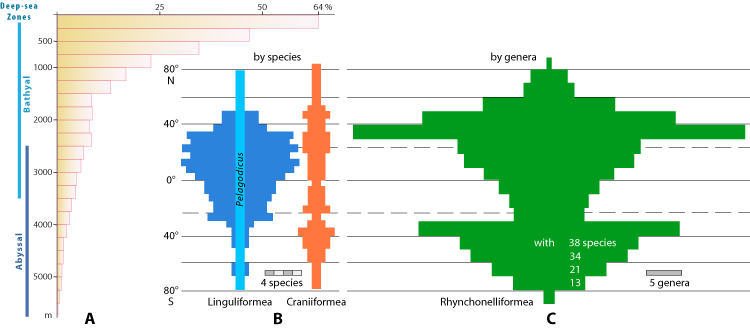
Figure 1: A. Bathymetrical distribution of the species of extant brachiopods (in percentage). B & C. Latitudinal distribution of the extant species of Linguliformea and Craniiformea (B) and the extant genera of Rhynchonelliformea (C). From Emig (2017).
Finally, there is a basic need to establish the intra- and inter-population variations for all valid taxonomic characters, as well as for those that are modified in accordance with the age of the individual. Three or more species of one genus have sometimes been established and described on the basis of differences in a given character, especially those of shell outline and shape. Yet such elements are known to have no taxonomic value. Consequently, a large number of described species, not only those from the Antarctic area, lack phylogenetic authenticity. For example, Liothyrella moseleyi, L. delsolari and L. winteri may probably be considered synonyms of L. uva, along with Acrobrochus and Liothyrella.
Consequently there is a pre-eminent need for the establishment of well-defined phylogenetic criteria for each species and genus that will result in a rigorous and reliable systematics, a requirement for any worthwhile analysis of biodiversity and molecular studies, but also in the food and pharmaceutical industries, taphonomy, palaeoecological interpretation, and in the broad field of formal and informal education at all levels. A cladistic approach based on extant brachiopod species cannot be confined solely to the shape and dimensions of the shell, because other phylogenetical characters occur in the soft-bodied parts of the brachiopods.
The diversity of brachiopods in the Arctic and Antarctic realms is best expressed by their numbers, respectively 10 and 51 species. Obviously the epifauna is more heterogeneous and predominates in the Antarctic communities. The list of brachiopod genera and species in the Arctic (Arndt & Grieg, 1933; Zezina, 1977a, 1997b, 1980, 1997; Zezina & Raysky, 2010) and that of the species of the same genera found in the Antarctica (Tables 1 and 4) is given on Table 2.
Both Arctic and Southern Oceans have great differences which may explain their diversity: shortly, the Arctic Ocean is the smallest one in the World (14.2 millions de km2) and its southern limit is about the Arctic Circle (66°33'N), while the Southern Ocean has an area at last twice with a northern limit at nearly 40°S (Table 3).
Table 2: List of the seven genera of Brachiopoda occurring in the Arctic and Antarctic zones.
|
Genera |
Species |
|
|
Arctic |
Antarctic |
|
| Pelagodiscus | atlanticus | atlanticus |
| Discradisca | ? | cumingii |
| Cryptopora | gnomon | gnomon |
| Novocrania | anomala | lecointei |
| Terebratulina | retusa | kiiensis |
| septentrionalis | ||
| Macandrevia | cranium | americana |
| diamantina | ||
| Dallina | septigera | elongata |
| eltanini | ||
Limits of the Antarctic and sub-Antarctic zones
The scientific zones of the Southern Ocean used herein have been defined in De Broyer et al. (2011). Nevertheless as true biological demarcation of the Antarctic zone, we have retained the Antarctic Polar front (Table 3). The limit of the sub-Antarctic zone is defined on Table 3. This line is close to the sub-tropical front.
Both zones are covered by the Southern Ocean which circles Antarctica. The northern limit of the Southern Ocean is not so clearly defined, but biological it is usually consider the Subtropical Front (Table 3) which is a transition zone between cool, fresh, nutrient-rich subantarctic waters and warm, salty, nutrient-poor subtropical waters. Although the position of the Subtropical Front varies with longitude, it lies roughly along 40°S for much of the Southern Ocean. Defined in this way, this latter occupies about 20% of the surface area of the Global Ocean.
The occurrences of the genera and species of Brachiopoda in each zone are listed on Table 4: only 12.6% of the species and 29.4% of the genera have been recorded when comparing to the diversity of the extant brachiopod in Global Ocean.
Table 3: Limits of the Antarctic and sub-Antarctic zones.
|
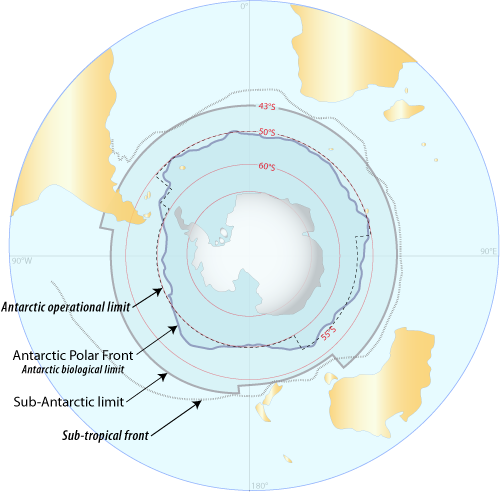 [Enlarge] |
Table 4: Occurrences of genera and species in the Antarctic and sub-Antarctic zones.
|
Genera |
Antarctic Zone |
Sub-Antarctic Zone |
| Abyssorhynchia | 1 | |
| Abyssothyris | 1 | 1 |
| Acrobrochus | 2 | 2 |
| Aerothyris | 2 | 2 |
| Amphithyris | 1 | |
| Aneboconcha | 2 | 1 |
| Cancellothyris | 1 | |
| Compsothyris | 2 | |
| Cryptopora | 1 | 1 |
| Dallina | 1 | 2 |
| Discradisca | 1 | |
| Dyscolia | 1 | 1 |
| Dyscritosia | 1 | |
| Ecnomiosa | 1 | |
| Eucalathis | 2 | 2 |
| Fallax | 1 | |
| Fosteria | 1 | 1 |
| Gyrothyris | 1 | |
| Liothyrella | 1 | 4 |
| Macandrevia | 2 | 2 |
| Magasella | 1 | 1 |
| Magellania | 3 | 2 |
| Manithyris | 1 | |
| Melvicalathis | 1 | |
| Neorhynchia | 1 | 1 |
| Neothyris | 1 | |
| Novocrania | 1 | 1 |
| Pelagodiscus | 1 | 1 |
| Pemphixina | 1 | 1 |
| Phaneropora | 1 | 1 |
| Platidia | 1 | 1 |
| Syntomaria | 1 | 1 |
| Terebratella | 1 | |
| Terebratulina | 1 | |
| Xenobrochus | 1 | 2 |
| Genera: 35 | 28 | 30 |
| Species: 51 | 35 | 39 |
Classification
Phylum Brachiopoda Duméril, 1805
Subphylum LINGULIFORMEA Williams, Carlson, Brunton, Holmer & Popov, 1996
Class Lingulata Gorjansky & Popov, 1985
Order Lingulida Waagen, 1885
Superfamily Discinoidea Gray, 1840
Family DISCINIDAE Gray, 1840
Pelagodiscus atlanticus (King, 1868)
Discradisca cumingii (Broderip, 1833)
Subphylum CRANIIFORMEA Popov, Basset,Holmer &Laurie, 1993
Class Craniata Williams, Carlson, Brunton, Holmer& Popov, 1996
Order CRANIIDA Waagen, 1885
Superfamily Cranioidea Menke, 1828
Family CRANIIDAE Menke, 1828
Novocrania Lee & Brunton, 2001
Novocrania lecointei (Joubin, 1901)
Subphylum RHYNCHONELLIFORMEA Williams, Carlson, Brunton, Holmer & Popov, 1996
Class Rhynchonellata Williams, Carlson, Brunton, Holmer & Popov, 1996
Order RHYNCHONELLIDA Kuhn, 1949
Superfamily Dimerelloidea Buckman, 1918
Family CRYPTOPORIDAE Muir-Wood, 1955
Cryptopora gnomon Cooper, 1981
Superfamily Norelloidea Ager, 1959
Family FRIELEIIDAE Cooper, 1959
Subfamily Freileiinae Cooper, 1959
Compsothyris racovitzae (Joubin, 1901)
Compsothyris ballenyi Foster, 1974
Subfamily Hispanirhynchiinae Cooper, 1959
Manithyris rossi Foster, 1974
Abyssorhynchia craneana (Dall, 1895)
Subfamily Neorhynchiinae Mancenido & Owen, 2002
Neorhynchia strebeli (Dall, 1908)
Superfamily Hemithiridoidea Rzhonsnitskaia, 1956
Family HEMITHIRIDIDAE Rzhonsnitskaia, 1956
Pemphixina pyxidata (Davidson, 1880)
Order TEREBRATULIDA Waagen, 1883
Suborder Terebratulidina Waagen, 1883
Superfamily Terebratuloidea Gray, 1840
Family TEREBRATULIDAE Gray, 1840
Subfamily Terebratulinae Gray, 1840
Acrobrochus vema (Cooper, 1973)
Acrobrochus blochmanni (Jackson, 1912)
Liothyrella uva (Broderip, 1833)
Liothyrella moseleyi (Davidson, 1878)
Liothyrella winteri (Blochmann, 1906)
Liothyrella neozelanica Thomson, 1918
Liothyrella delsolari Cooper, 1982
Superfamily Dyscolioidea Fischer & Œhlert, 1891
Family DYSCOLIIDAE Fischer & Œhlert, 1891
Subfamily Dyscoliinae Fischer & Œhlert, 1891
Dyscolia Fischer & Œhlert, 1890
Dyscolia radiata Cooper, 1981
Dyscolia sp.
Subfamily Aenigmathyridinae Cooper, 1983
Abyssothyris wyvillei (Davidson, 1878)
Xenobrochus africanus (Cooper, 1973)
Xenobrochus anomalus Cooper, 1981
Xenobrochus australis Cooper, 1981
Superfamily Cancellothyroidea Thomson, 1926
Family CANCELLOTHYRIDIDAE Thomson, 1926
Subfamily Cancellothyridinae Thomson, 1926
Cancellothyris hedleyi (Finlay, 1927)
Terebratulina kiiensis Dall & Pilsbry, 1891
Family CHLIDONOPHORIDAE Muir-Wood, 1959
Subfamily Eucalathinae Muir-Wood, 1965
Eucalathis Fischer & Œhlert, 1890
Eucalathis murrayi (Davidson, 1878)
Eucalathis macrorhyncus Foster, 1974
Eucalathis magna Cooper, 1981
Melvicalathis Lee, Gregory, Lüter, Zezina, Robinson & Christie, 2008
Melvicalathis macroctena (Zezina, 1981)
Suborder Terebratellidina Muir-Wood, 1955
Superfamily Zeillerioidea Allan , 1940
Family ZEILLERIIDAE Allan , 1940
Subfamily Macandreviinae Cooper, 1973
Macandrevia americana Dall, 1895
Macandrevia diamantina Dall, 1895
Superfamily Kingenoidea Elliot, 1948
Family Kingenidae Elliot, 1948
Subfamily Ecnomiosinae Cooper, 1977
Ecnomiosa inexpectata Cooper, 1981
Family AULACOTHYROPSIDAE Dagys, 1972
Subfamily Babukellinae MacKinnon, Smirnova & Lee, 2002
Fallax antarcticus Foster, 1974
Superfamily Platidioidea Thomson, 1927
Family PLATIDIIDAE Thomson, 1927
Subfamily Platidiinae Thomson, 1927
Platidia anomioides (Scacchi & Philippi, 1844)
Amphithyris hallenttensis Foster, 1974
Subfamily Phaneroporinae Zezina, 1981
Phaneropora galatheae Zezina, 1981
Superfamily Terebratelloidea King, 1850
Family TEREBRATELLIDAE King, 1850
Subfamily Terebratellinae King, 1850
Terebratella dorsata (Gmelin, 1790)
Magasella sanguinea (Leach, 1814)
Syntomaria curiosa Cooper, 1982
Aerothyris macquariensis (Thomson, 1918)
Aerothyris kerguelensis (Davidson, 1878)
Aneboconcha obscura (Cooper, 1973)
Aneboconcha smithii (Pfeffer, 1886)
Dyscritosia secreta Cooper, 1982
Fosteria spinosa (Foster, 1974)
Gyrothyris mawsoni Thomson, 1918
Neothyris lenticularis (Deshayes, 1839)
Subfamily Magellaniinae Beecher, 1893
Magellania joubini (Blochmann, 1906)
Magellania fragilis (Smith, 1907)
Magellania venosa (Solander, 1789)
Family DALLINIDAE Beecher, 1893
Subfamily Dallininae Beecher, 1893
Dallina elongata Hatai, 1940
Dallina eltanini Foster, 1974
Alphabetical list of genera and species
|
|
Geographical distribution
The references indicated for each species concern only the Antarctic and sub-Antarctic zones as limited on the maps. The localities plotted outside of these zones are not exhaustive as well as on the maps of the world - no references are given for.
To enlarge a map of the Antarctic and sub-Antarctic zones, please click on.
Genus Abyssorhynchia Zezina, 1980
[Type species= Hemithyris craneana Dall, 1895 (p. 717)]
Diagnosis from volume 4 of the Treatise on Invertebrate Paleontology (Kaesler, 2002):
- Medium, translucent, rounded-triangular; rectimarginate to broadly sulcate; ventribiconvex; shell smooth to faintly striate; beak short, suberect, foramen open, large, hypothyrid. Dorsal septum very short and low; crura anteriorly enlarged, forming small, flat, spadelike distal ends.
Geological range: Present (Holocene).
Abyssorhynchia craneana (Dall, 1895)
Hemithyris craneana Dall, 1895
Hispanirhynchia craneana Thomson, 1927
Hispanirhynchia? chiliensis Foster, 1974
Type locality: "Station 3362, in 1175 fathoms, mud, off Cocos Island, Gulf of Panama" [2149 m].
Depth range: 1409 – 4600 m.
References: Foster (1974), Zezina (1980a).
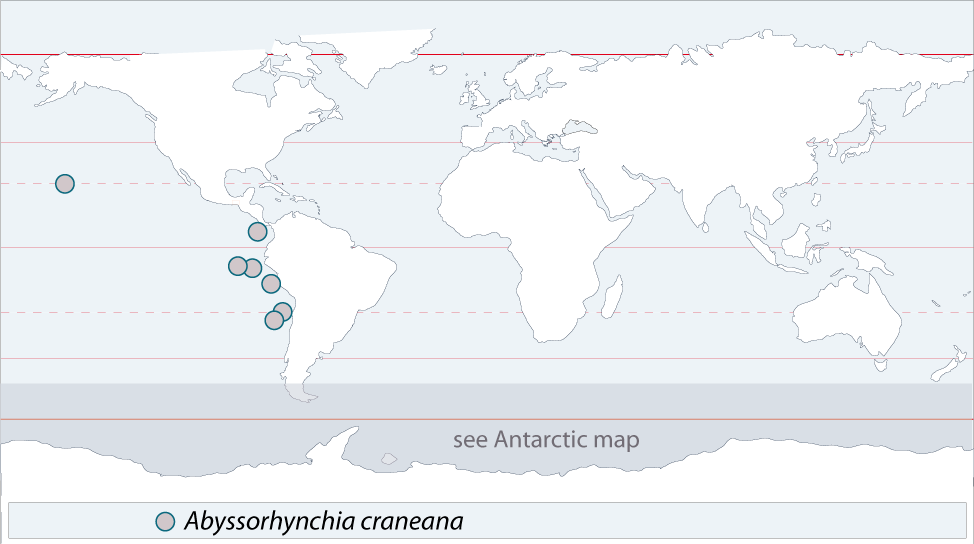
Genus Abyssothyris Thomson, 1927
[Type species= Terebratula wyvilli Davidson, 1878 (p. 436)]
Diagnosis from volume 5 of the Treatise on Invertebrate Paleontology (Kaesler, 2006):
- Small to medium, oval to subpentagonal in outline, ventribiconvex, smooth, thin shelled; anterior commissure unisulcate; beak small, suberect; foramen large, permesothyrid; symphytium partly visible; pedicle collar short, teeth small; cardinal process small, semielliptical, outer hinge plates narrowly triangular, tapering anteriorly to bluntly pointed crural processes located at midloop; crural bases narrow; transverse band broad, gently folded medially, anterior part of loop variable, anterolateral extremities rounded to subangular. Lophophore plectolophous with small median coil.
Geological range: Miocene - Present (Holocene).
Abyssothyris wyvillei (Davidson, 1878)
Liothyris wyvillii: Davidson (1886)
Terebratella (Liothyrina) wyvillei: Möricke (1895)
Liothyrina wyvillii: Dall (1908)
Gryphus wyvillii: Dall (1921)
Abyssothyris wyvillei: Thomson (1927)
Abyssothyris elongata Cooper, 1972
Abyssothyrissp. Cooper, 1973a
Abyssothyris sp. A. wyvillei: Foster (1974)
Liothyrella sp. A Foster, 1974 (see Foster, 1989)
Abyssothyris atlantica Cooper, 1977 (see Laurin, 1997)
Abyssothyris? parva Cooper, 1977 (see Laurin, 1997)
Abyssothyris sp. 1 & 2 Cooper, 1977
Abyssothyris? sp. Cooper, 1982
Abyssothyris cf. elongata Cooper, 1982
Type locality: "42°41'S, 134°10'E, depth 2,600 fathoms" [1829 m].
Depth range: 284 - 6179 m.
References: Blochmann (1910), Cooper (1973a, 1982), Davidson (1878, 1886-1888), Dall (1921), Foster (1969, 1974, 1989), Zezina (1975, 1980a, 1993).
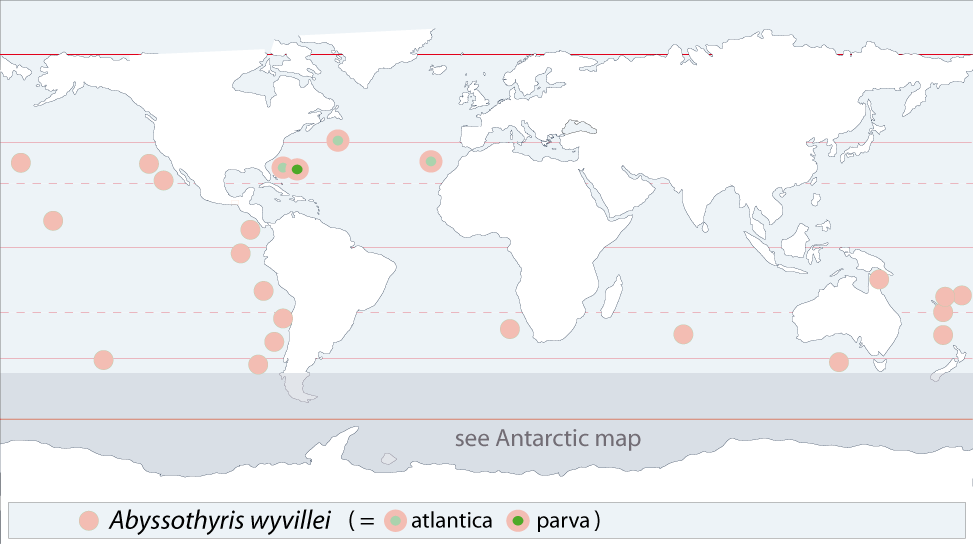
Genus Acrobrochus Cooper, 1983
[Type species= Liothyrella? vema Cooper, 1973a (p. 17)]
Diagnosis from volume 5 of the Treatise on Invertebrate Paleontology (Kaesler, 2006):
- Medium to large, oval to subpentagonal; anterior commissure rectimarginate to uniplicate, smooth; beak suberect, short, labiate; foramen moderately large, permesothyrid; symphytium partly visible; pedicle collar short, excavate; cardinal process is a transverse semiellipse; outer hinge plates taper onto posteroventral edges of crural processes; loop narrow with broad, transverse band.
Geological range: Eocene-Present (Holocene).
Acrobrochus blochmanni (Jackson, 1912)
Liothyrina blochmanni Jackson, 1912 (p. 378)Liothyrella blochmanni: Thomson (1918)
?Liothyrella multiporosa Foster, 1974
?Liothyrella scotti Foster, 1974
Liothyris blochmanni: Zezina (1976)
Type locality: "Station 417; lat. 71°22'S., long. 16°34'W. (off Coats Land). Depth, 1410 fathoms. March 18, 1904" [depth 2579 m].
Depth range: 103 - ?3697 m.
References: Cooper (1973a), Dall (1921), Foster (1974, 1989), Jackson (1912), Zezina (1994).
Acrobrochus vema (Cooper, 1973a)
Liothyris vema: Zezina (1976)
Acrobrochus hendleri Cooper, 1982
Type locality: "V-17-61. Latitude 54°44'S, longitude 55°39'W, at 1814-1919 meters, off east end of Burdwood Bank, east of south end of Argentina."
Depth range: 732 - 2578 m.
Diagnosis (Cooper, 1973a): Large, nearly equivalved Liothyrella?, with stout loop and broadly uniplicate anterior margin.
References: Cooper (1973a, 1982), Foster (1989).
Genus Aerothyris Allan, 1939
[Type species= Magellania macquariensis Thomson, 1918 (p. 30)]
Diagnosis from volume 5 of the Treatise on Invertebrate Paleontology (Kaesler, 2006)
- Medium size, variably ovate, weakly to moderately unisulcate, smooth; beak suberect, attrite, foramen medium to large, mesothyrid, deltidial plates commonly disjunct, rarely conjunct in some adults. Cardinalia moderately thickened; outer hinge plates prominent and gently inclined; inner hinge plates more steeply inclined, uniting medianly to form septalium; cardinal process prominent, consisting of striated transverse myophore; crura with prominent crural processes; median septum bladelike; adult loop teloform.
Geological range: Present (Holocene).
Aerothyris macquariensis (Thomson, 1918)
Magellania macquariensis Thomson, 1918
Type locality: "on beach above present high-water level, Wireless Cove, north-west end of Macquarie Island; over an extent of ¼ mile."
Depth range: 50 - 714 m.
References:Allan (1939, 1940a), Bowen (1968), Cooper (1981), Cotton (1937), Foster (1967, 1969, 1989), Richardson (1997), Thomson (1918).
Aerothyris kerguelensis (Davidson, 1878) *
Waldheimia kerguelensis Davidson, 1878Waldheimia dilatata Lamarck: Smith (1879)
Terebratella dorsata Davidson, 1880
Magellania kerguelensis: Eichler (1911) – See also Aneboconcha eichleri.
Magellania kerguelenensis: Jackson (1918)
Aerothyris eichleri Allan, 1939
Magellania kerguelenensis: Foster (1974)
Macandrevia kerguelensis: d'Hondt (1977)
Magellania kerguelensis: Zezina (1980)
Aerothyris kerguelenensis: Cooper (1981)
Type locality: "dredged by the 'Challenger' Expedition off Marion Island, west of Kerguelen Isle, in a depth of 100 fathoms, and also in lat. 50°4'S., long. 71°22'E., at a depth of 150 fathoms".
Depth range: from some meters – more than 500 m.
References: Allan (1939, 1940a), Cooper (1981), Dall (1921), Davidson (1880, 1886-1888), Eichler (1911), Foster (1969, 1974), Hiller (1994), d'Hondt (1977), Jackson (1918), Richardson (1997), Smith (1879), Zezina (1980a).
* Note:
Genus Amphithyris Thomson, 1918
[Type species= Amphithyris buckmani Thomson, 1918 (p. 20)]
Diagnosis from Nauendorf et al. (2014):
- Small shell (up to 5mm), planoconvex to biconvex, punctate, round to oval; shell outline variable depending on substrate of attachment. Ventral valve convex; dorsal valve slightly convex to almost flat; short pedicle; beak apicate; foramen amphithyrid; schizolophous lophophore. Hinge line nearly straight; triangular delthyrium; dental plates absent.
Geological range: Present (Holocene).
Amphithyris hallettensis Foster, 1974
Type locality: "Deep Freeze III, USS Atka station 23, near Cape Hallet (72°05.8'S, 172°15.2'E), 392 m; January 8, 1958."
Depth range: 348 - 891 m.
Diagnosis (Nauendorf et al., 2014): Shell ventribiconvex, small dorsal septum, imprints of capillae visible in ventral valve interior.
References: Foster (1974), Nauendorf et al., (2014), Thomson (1918).
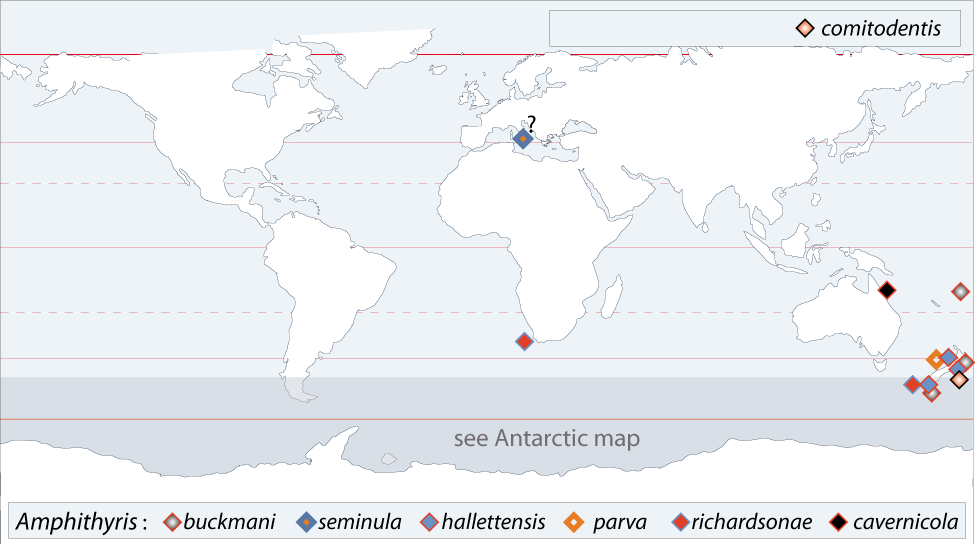
Genus Aneboconcha Cooper, 1973a
[Type species= Aneboconcha obscura Cooper, 1973a (p. 28)]
Diagnosis from volume 5 of the Treatise on Invertebrate Paleontology (Kaesler, 2006):
- Small, smooth, elongate oval, gently unisulcate, beak suberect, foramen large, submesothyrid; deltidial plates disjunct. Cardinal process consisting of transversely oval myophore; socket ridges and outer hinge plates narrow, crural bases narrow, inner hinge plates well developed, uniting with bladelike median septum to form septalium; loop trabecular.
Geological range: Present (Holocene).
Aneboconcha obscura Cooper, 1973a
Magellania sp. Blochmann, 1912
Type locality: "V-17-51. Latitude 55∞17.5'S, longitude 66∞00'W, at 205-207 meters, off the southeast end of Tierra del Fuego, Argentina."
Depth range: 95 - 947 m.
References: Cohen et al. (2011), Cooper (1973a), Foster (1989, see below *), Richardson (1997), Zezina (1980a).
Aneboconcha smithii ** (Pfeffer, 1886)
Waldheimia smithii Pfeffer in Martens & Pfeffer, 1886
Aerothyris (?) smithi: Allan, 1939
Aneboconcha smithi: Zezina (1980)
Type locality: "Süd-Georgien - Deutsche Station 1882-1883." [South Georgia Island].
Depth range: 275 - 970 m.
References: Allan (1939, 1940a), Cohen et al. (2011), Foster (1989, see below *), Martens & Pfeffer (1886), Zezina (1980a), Zezina & Pakhnevich (1998, 2000).
* Foster (1989) pointed out that "A better understanding of this species is particularly vital in order to adequately evaluate a number of somewhat similar species that occur in the same area that may be variants of Magellania venosa. These similar specie include: Waldheimia smithi Pfeffer, 1866 (= Anecoboncha smithi Zezina, 1980); Magellania wyvillei Davidson, 1878; Aneboconcha obscura Cooper, 1973a; Syntomaria curiosa Cooper, 1982; and Dysritosia secreta Cooper, 1982."
** Note: The original species name is smithii and, thus, must be used as it is according to the article 31.1.1. of the International code of Zoological Nomenclature (1999) because it has been formed from a personal name that is Latin.
Aneboconcha eichleri (Allan, 1939)
Allan (1939, p. 246) attributed the specimens figured by Eichler (1911) to a new species of the genus Aerothyris Allan, 1939 under the name A. eichleri [(I) AEROTHYRIS EICHLERI nom. nov. = Magellania Kerguelensis Eichler 1911, Ö (not of Davidson 1878). Type locality: Observatory Bay, Kerguelen Island, in 10 metres], without discussing this change and providing a diagnosis . Eichler's specimens were sampled at the station "Gauss" at less than 10 m depth, in Observatory Bay, by the "Deutsche Südpolar-expedition (1901-1903)". This bay was named in 1874 by the Challenger Expedition, today "baie de l'Observatoire", Kerguelen Islands (TAAF, France). Foster (1974) pointed out that these specimens are simply an elongated form of Magellania kerguelensis. Cooper (1981) considered eichleri as synonymous of Aerothyris kerguelensis.
Following Allan's statement, Zezina (1980a) attributed the specimens collected in Kerguelen islands to Aneboconcha eichleri (Allan, 1939), considering that the specimens figured by Eichler (1911) are not Waldheimia kerguelensis Davidson, 1878, but no diagnosis, no figures are provided. According to the brachidium type, Zezina (1980a) assigned her single specimen sampled in the Kerguelen Islands to Aneboconcha. Foramen and deltidial plates of A. eichleri are similar to those of A. smithii but the former species differs by a smaller size and much more folding of the anterior commissure.
Until more investigations on this species, Eichler's (1911) specimens are considered as belonging to Aerothyris kerguelensis Davidson, 1878. Hiller (1994) indicated that A. kerguelensis is the most common of the brachiopods and is the species that extends over the greatest depth range, from less than 50 m deep to more than 500 m. It is particularly abundant in the shallow area of Marion and Prince Edward Islands (South Africa).
Genus Cancellothyris Thomson, 1926
[Type species = Terebratula cancellata Koch in Küster, 1843 (p. 35) = Terebratulina hedleyi Finlay, 1927]
Diagnosis from volume 5 of the Treatise on Invertebrate Paleontology (Kaesler, 2006):
- Small to medium sized, ovate to subpentagonal, valves biconvex; anterior commissure uniplicate to sulciplicate; surface finely capillate; umbo short, massive, suberect; foramen large, epithyrid, labiate; deltidial plates conjunct. Pedicle collar developed; cardinal process low, bilobed; loop wide, transverse band broad, slightly arched ventrally. Lophophore plectolophous.
Geological range: Miocene - Present (Holocene).
Cancellothyris hedleyi (Finlay, 1927)
Terebratula cancellata Koch in Küster, 1843 (p. 36)
Terebratulina cancellata Koch: Davidson (1886)
Terebratulina hedleyi Finlay, 1927 (p. 533)
Cancellothyris australis Thomson, 1927
Cancellothyris cancellata: Foster (1969)
Type locality: "Westaustralien" [Western Australia].
Depth range: 6 - 366 m.
References: Dawson (1971a, 1971b, 1991), Foster (1969, 1989), Richardson (1979, 1981b), Zezina (2008).
Originally named Terebratula cancellata Koch in Küster (1845, p. 35), the need for renaming this species arose from the preoccupation of the specific name by Terebratula cancellata Eichwald, 1829. It was renamed Terebratulina hedleyi by Finlay (1927, p. 533), while Thomson in a book issued the same year proposed the name Cancellothyris australis (Thomson, 1927, p. 188).
The priority of hedleyi over australis is not doubtful: Finlay's publication was read on 8th December 1925 before the Otago Institute and issued on 19th January 1927 (Finlay, 1927: p. 488), while Thomson's book was published on December 1927 according to Dawson (1972). Curiously, this latter author indicated "H. J. Finlay in 1927" in text but forgot to quote the publication in "References"!
Genus Compsothyris Jackson, 1918
[Type species= Rhynchonella racovitzae Joubin, 1901 (p. 5)]
Diagnosis from volume 4 of the Treatise on Invertebrate Paleontology (Kaesler, 2002):
- Uniplication trigonal, broad, gentle, dorsal fold poorly developed; shell surface with fine radial striae; foramen hypothyrid. Median dorsal septum ridgelike, supporting small septalium; crura somewhat spatulate, flat.
Geological range: Present (Holocene).
Compsothyris racovitzae (Joubin, 1901)
Rhynchonella racovitzae Joubin, 1901
Rhynchonella gerlachei Joubin, 1901
Hemithiris striata Thomson, 1918
Rhynchonella racovitae: Chapman & Crespin (1923)
Hispanirhynchia antarctica Hatai, 1959
Type locality: "St. Faubert VIII [70°00'S, 80°48'W], 500 m - 18 Octobre 1898."
Depth range: 329 - 3970m.
References: Álvarez et al. (2010), Chapman & Crespin (1923), Eichler (1911), Foster (1969, 1974). Hatai (1959), Jackson (1912, 1918), Joubin (1901), Thomson (1918), Zezina (1980a, 1993, 1998).
Compsothyris ballenyi Foster, 1974
Type locality: "off Balleny Island, 2507-2525 m" [66°52'S, 164°32'E].
Depth range: 2507 - 2525 m.
References: Foster (1974), Zezina (1994).
Genus Cryptopora Jeffreys, 1869
[Type species= Cryptopora gnonom = Atretia gnonom Jeffreys, 1869 (p. 136)]
Diagnosis from volume 4 of the Treatise on Invertebrate Paleontology (Kaesler, 2002):
- Small, translucent, subtrigonal to ovoid-lenticular, almost equibiconvex; rectimarginate to broadly sulcate, smooth; beak moderately long, pointed, nearly straight; foramen large, incomplete; deltidial plates auriculate, rudimentary, disjunct. Dental plates distinct, subvertical; cardinal process small and transverse; dorsal median septum high; crura digitate distally.
Geological range: lower Danian - Present (Holocene).
Cryptopora gnomon Jeffreys, 1869
Atretia gnonom: Jeffreys, 1876
Dimerella gnonom: Dall, 1873
Neatretia gnomon: Fischer & Œhlert (1891)
Type locality: No information on the locality in Jeffreys (1869) and Carpenter et al. (1869), but in Jeffreys (1876), this species has been sampled
"during the 'Porcupine' expedition of 1869, in stations 20 [55°11'N, 11°31'W, 2639 m] and 30 [56°24'N, 11°49'W, 2524 m], at depths of 1443 ann 1380 fathoms, off the west coast of Ireland."
Depth range: 300 - 5950 m.
References: Cooper (1973a), Zezina (1981a).
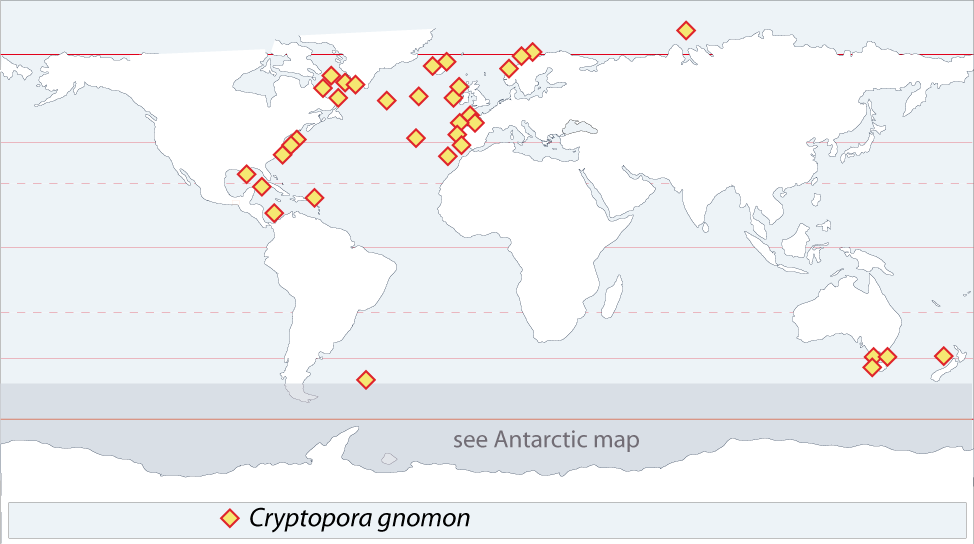
Genus Dallina Beecher, 1893
[Type species= Terebratula septigera Lovén, 1846 (p. 29)]
Diagnosis from volume 5 of the Treatise on Invertebrate Paleontology (Kaesler, 2006):
- Small to large, triangular to subquadrangular in outline; rectimarginate to paraplicate; beak erect, without beak ridges; foramen small to large, mesothyrid, attrite, symphytium concave. Hinge teeth small, weak; pedicle collar very short. Cardinalia lamellar with excavate inner and outer hinge plates separated by narrow crural bases; inner hinge plates converging on median septum to form V-shaped septalium; cardinal process not differentiated; median septum low anteriorly, extending beyond midvalve; adult loop teloform.
Geological range: Miocene - Present (Holocene).
Dallina eltanini Foster, 1974
Type locality: "Stations USC 1345 (54°50'S, 129°48'W): 915-1153 m."
Depth range: 339 - 1208 m.
References: Foster (1974, 1989).
Dallina elongata Hatai, 1940
Type locality: "Sôyô-maru St. 575, 37°48'N., 137°18'E., 123 m, sand."
Depth range: 123 - 567 m.
References: Foster (1974, 1989).
Genus Discradisca Stenzel, 1964
[Type species= Orbicula antillarum d'Orbigny, 1846 (p. 368)]
Diagnosis from volume 2 of the Treatise on Invertebrate Paleontology
- Similar to Discinisca but with wide, transversely suboval pedicle track, closed apically by semicircular, gently concave listrium; ornamentation of fine costellae and growth lamellae.
Geological range: Lower Tertiary (Danian) - Present (Holocene).
Discradisca cumingii (Broderip, 1833)
Orbicula cumingii Broderip, 1833 (pp. 124-125)
Discina cumingi: Suess (1859)
Discinisca cumingii: Davidsonl (1888)
Discradisca cuminghii: Gaspard (2001)
Type locality: "ad Paytam Peruviae, ad Sanctam Elenam, et ad Panamani… and in some instances at a depth of six fathoms" [20 m].
Depth range: 11 - 53 m.
Reference: Zezina & Pakhnevich (1998).
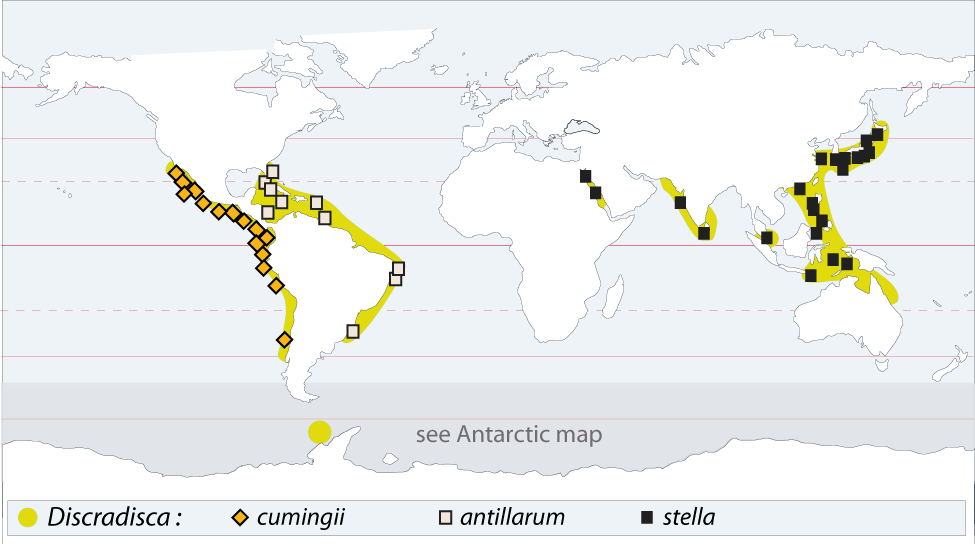
Genus Dyscolia Fischer & Œhlert, 1890
[Type species= Terebratulina wyvillei Davidson, 1878 (p. 436)]
Diagnosis from volume 5 of the Treatise on Invertebrate Paleontology (Kaesler, 2006):
- Medium to very large, subtrigonal to elongate oval; ventribiconvex; surface smooth or with fine, zigzag capillae; beak short, suberect, often truncated or labiate; foramen large, epithyrid to submesothyrid; symphytium almost concealed; pedicle collar long, anteriorly excavated; cardinal process not developed, diductor muscles attached to apical pit; outer hinge plates very weakly developed; crural processes weak, blunt; loop small (less than 0.3 dorsal valve length), thin, with rounded, anterolateral extremities; lophophore small, modified schizolophe; spicules very abundant; four main mantle canals in each valve, branching pattern pinnate.
Geological range: Pliocene – Present (Holocene).
Dyscolia? radiata Cooper, 1981
Type locality: "MD.08: st. 6, DC 47: 33°11.4'S, 44°00.4'E, Walters Bank, at 620-635 m."
Depth: 263 – 635 m.
Diagnosis (Cooper, 1981): Subtriangular, loop narrow, crural processes obtuse, surface covered by fine irregular capillae.
Cooper (1981, p. 24) states: "Dyscolia? radiata most resembles Dyscolia ewingi Cooper from off South America in south Atlantic waters. There is also resemblance to Liothyrella? neozelanica."
Reference: Cooper (1981), Hiller (1986).
Dyscolia sp.
References and Depth: Foster (1974): 915-1153 m, 1887-1894 m; Foster (1989): 4118 m; Hiller (1994): 680-715; Zezina (1980a): 580 m.
Genus Dyscritosia Cooper, 1982
[Type species= Dyscritosia secreta Cooper, 1982 (p. 22)]
Diagnosis from volume 5 of the Treatise on Invertebrate Paleontology (Kaesler, 2006):
- Small to medium, smooth, subcircular, biconvex, rectimarginate; beak low, attrite, erect; foramen medium, submesothyrid; deltidial plates narrow, disjunct. Cardinalia similar to Aneboconcha. Adult loop trabecular.
Original diagnosis (Cooper, 1982): "Shells just under medium size, roundly oval, biconvex, externally like Waltonia inconspicua (Sowerby) but like that species in having rectimarginate anterior commissure and only rudimentary deltidial plates."
Geological range: Present (Holocene).
Dyscritosia secreta Cooper, 1982
Type locality: "Islas Orcadas cruise 575, sta 89, 54°43.1'S, 036°48.3'W, off the South Sandwich Islands, at 225-265 m."
Depth range: 66 - 872 m.
Diagnosis (Cooper, 1982): As for the genus [sic] * .
Foster (1989) suggests that "this species may be an extreme variant of Magellania venosa. (See remarks for M. venosa.)" In this part, the author wrote:
"A better understanding of this species is particularly vital in order to adequately evaluate a numberof somewhat similar species that occur in the same area that may be variants of Magellania venosa. These similar specie include: Waldheimia smithi Pfeffer, 1866 (= Anecoboncha smithi Zezina, 1980); Magellania wyvillei Davidson, 1878; Anecoconcha obscura Cooper, 1973a; Syntomaria curiosa Cooper, 1982; and Dysritosia secreta Cooper, 1982."
References: Cooper (1982), Foster (1989), Richardson (1997).
* Note: A genus diagnosis allows to distinguish, and so to identify the genus from other genera in the same family (or subfamily), while the diagnosis of a species should only contain the taxonomic characters, and their variations, distinguishing a species from another in the same genus - see ICZN (1999). So even in a monospecific genus, the characters should allow to describe a new species within a given genus. In this case a cladistic analysis should be provided to confirm the validity of the phylogenetic characters.
Genus Ecnomiosa Cooper, 1977
[Type species= Ecnomiosa gerda Cooper, 1977 (p. 131)]
Diagnosis from volume 5 of the Treatise on Invertebrate Paleontology (Kaesler, 2006):
- Small, subcircular, smooth, gently biconvex, anterior commissure rectimarginate; beak ridges slightly tuberculate; foramen large, hypothyrid, deltidial plates very narrow, disjunct, pedicle collar short; hinge teeth with small recessive dental plates. No cardinal process; high inner socket ridges with long crura that are anteromedially convergent; septal pillar platelike at its base with high, narrow distal extremity (axial loop phase), descending branches absent. Lophophore zygolophous and heavily spiculate.
Geological range: Present (Holocene).
Ecnomiosa inexpectata Cooper, 1981
Type locality: "MD.08: st. 44, CP 199, 46°18.0'S, 51°14.0'E to 46°16.0'S, 51°13.0'E, east-west radial Crozet, between Possession and Cochons islands at 1500 m."
Depth range: 884 - 1500 m.
Diagnosis (Cooper, 1981): Medium size, faintly sulcate Ecnomiosa.
References: Cooper (1981), Lüter (2008).
Genus Eucalathis Fischer & Œhlert, 1890
[Type species= Terebratulina (?) murrayi Davidson, 1878 (p. 437)]
Diagnosis from volume 5 of the Treatise on Invertebrate Paleontology (Kaesler, 2006):
- Small, subtrigonal, auriculate, ventribiconvex, anterior commissure rectimarginate or incipiently uniplicate, hinge straight; surface capillate with rare intercalations or granular; umbo short, obliquely truncate; deltidial plates short, triangular, disjunct. Pedicle collar present, loop chlidonophorid but transverse band dorsally directed, socket ridges as narrow plates uniting with cardinal process, and anteriorly with crural bases; lophophore with 2 single whorl spirals set at angle to plane of symmetry, filaments long.
Geological range: Eocene - Present (Holocene).
Eucalathis murrayi (Davidson, 1878)
Eucalathis costellata Cooper, 1981
Eucalathis rotundata Cooper, 1981
Type locality: "dredged, lat. 28°33'S., long. 177°50'W., near Kermadoc Isle, south of Fejee Isles, in a depth of 600 fathoms" [1097 m] – correct spelling is Kermadec.
Depth range: 185 - 3374 m.
References: Foster (1969, 1974), Pakhnevitch et al. (2013), Zezina (1980a, 2010).
Eucalathis macrorhynchus Foster, 1974
Type locality: "USC st. 1345 (54°50'S, 129° 48'W): depth 915-1153 m."
Depth range: 326 – 1153 m.
References: Foster (1974, 1989), Zezina (1980a).
Eucalathis magna Cooper, 1981
Type locality: "MD.03: st. 11, CP7, lat. 53°20.3'S, long. 72°29.2'E; west of Heard Island at 790 m."
Depth range: 207 - 402 and 790 m.
Diagnosis (Cooper, 1981): Large, elongate Eucalathis.
Reference: Cooper (1981).
Eucalathis sp.
Foster (1989) identified a single specimen of an Eucalathis-like species dredged between 390 and 3493 m as a possible E. macroctena ? Zezina, 1891 or an immature Terebretulina.
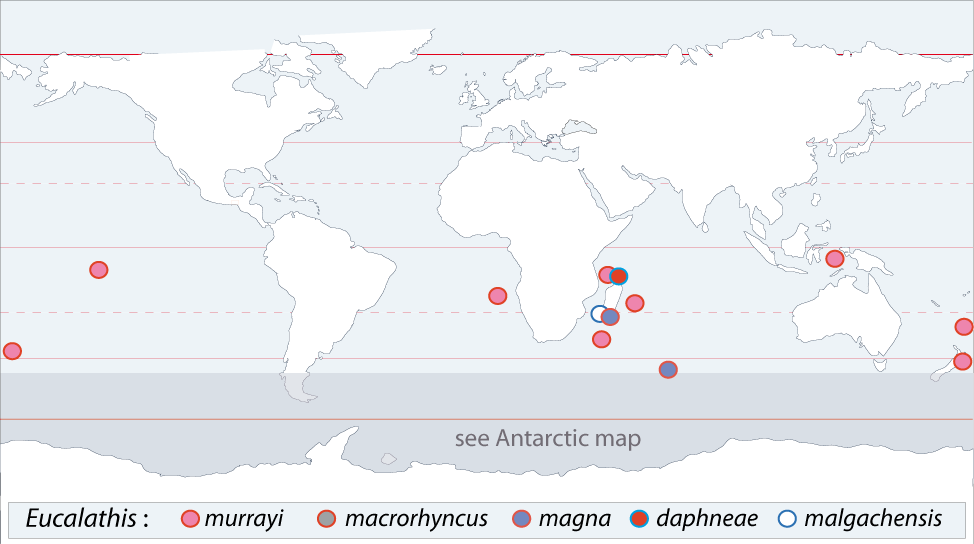
Genus Fallax Atkins, 1960
[Type species= Fallax dalliniformis Atkins, 1960 (p. 72)]
Diagnosis from volume 5 of the Treatise on Invertebrate Paleontology (Kaesler, 2006):
- Medium, biconvex, smooth, elongate ovate to subpentagonal, anterior commissure rectimarginate to parasulcate; beak low, erect; beak ridges rounded; deltidial plates conjunct in adults; foramen small, round, permesothyrid. Dental plates lamellar, straight; pedicle collar broad, sessile, impunctate. Cardinalia lamellar with short, well-developed septalium; inner and outer hinge plates well developed, crural bases not differentiated; cardinal process not differentiated; median septum extending anteriorly about three-quarters valve length; crura short, subparallel, crural processes short; loop diploform; lophophore and mantle finely spiculate.
Geological range: Present (Holocene).
Fallax antarcticus Foster, 1974
Type locality: "HU st. 27-35 (62°47'S, 158°12'W): 2288-2342 m."
Depth range: 2285 - 2342 m.
Reference: Foster (1974).
Genus Fosteria Zezina, 1980
[Type species= Magellania (?) spinosa Foster, 1974 (p. 142)]
Diagnosis from volume 5 of the Treatise on Invertebrate Paleontology (Kaesler, 2006):
- Small, smooth, rectimarginate to unisulcate, foramen large, submesothyrid; beak suberect, attrite; deltidial plates very narrow, disjunct. Cardinalia lamellar, lacking clearly defined cardinal process; inner hinge plates broad, steeply inclined, uniting with low posterior trail of median septum to form septalium; septal pillar high, spinose anteriorly; loop annular, descending branches with several curved spines.
Geological range: Oligocene - Present (Holocene).
Fosteria spinosa (Foster, 1974)
Magellania (?) spinosa Foster, 1974
Fosteria spinosa: Zezina (1980)
Type locality: "HU st. 32-33 (76°22.4'S, 163°26.2'W): 501 m."
Depth range: 256 - 1226 m.
References: Foster (1974), Richardson (1994, 1997), Zezina (1980a).
Genus Gyrothyris Thomson, 1918
[Type species= Gyrothyris mawsoni Thomson, 1918 (p. 28)]
Diagnosis from volume 5 of the Treatise on Invertebrate Paleontology (Kaesler, 2006)
- Medium, transversely ovate to elongate oval; finely multicostate, anterior commissure weakly unisulcate; beak suberect to erect, foramen small, mesothyrid, attrite; deltidial plates usually conjunct, concave, almost hidden. Cardinalia thickened; cardinal process transversely oval myophore, median septum uniting posteriorly with narrow septalium; adult loop typically trabecular but occasionally teloform.
Geological range: Present (Holocene).
Gyrothyris mawsoni Thomson, 1918
Gyrothyris mawsoni antipodesensis Foster, 1974
Gyrothyris mawsoni aucklandensis Foster, 1974
Type locality: "one mile off south end of Macquarie Island."
Depth range: 79 - 563 m.
References: Bowen (1968), Brand et al. (2003), Cooper (1973a), Foster (1967, 1969, 1974), Harper et al. (2011), Richardson (1997), Thomson (1918), Zezina (1980).
Note: Tomson (1918) wrote: "Gyrothyris resembles Pachymagas more than Terebratella, but, differs from the former, in the absence of beak ridges, the shallowness of the hinge trough, and the transverse nature of the cardinal process. Further, Gyrothyris mawsoni possesses a radial ornament which has never been observed on any species of Pachymagas."
According to Bowen (1968), "the Macquarie Island specimens of G. mawsoni resemble Magasella sanguinea but lack its characteristic reddish colour. On the inside, the shell structures are more thickened than in M. sanguinea."
Genus Liothyrella Thomson, 1916
[Type species = Terebratula uva Broderip, 1833 (p. 124)]
Diagnosis from volume 5 of the Treatise on Invertebrate Paleontology (Kaesler, 2006):
- Large to very large, elongate oval to subcircular; ventribiconvex, anterior commissure usually rectimarginate, occasionally broadly uniplicate; smooth or with faint, radial or zigzag capillae; beak usually short, suberect; foramen usually large, submesothyrid, labiate; symphytium wholly or partly visible; pedicle collar short, teeth triangular, narrow; low myophragm may be present; cardinal process transverse semiellipse; outer hinge plates variable in width and length; attached near dorsal edge of crural bases; loop variable; usually widely triangular, crural processes located near socket openings, transverse band relatively narrow, variable; spicules abundant.
Geological range: Eocene – Present (Holocene).
Liothyrella uva (Broderip, 1833)
Liothyris uva: Davidson (1886)
?Terebratula uva: Gray (1853)
Terebratula moseleyi Fischer & Œhlert, 1892
Liothyrella antarctica Blochmann, 1906
Liothyrina uva: Blochmann (1906)
Liothyrina moseleyi: Dall (1908)
Liothyrina uva var. notorcadensis Jakson, 1912
Liothyrina antarctica: Joubin (1914)
?Liothyrella ovata Thomson, 1918
Liothyrella notorcadensis Thomson, 1918
Gryphus antarcticus: Dall (1921)
Gryphus uva: Dall (1921)
Liothyrella oblonga Cooper, 1973a
Liothyrella uva georgina Foster, 1974
Liothyrella antartica georgina Zezina 1980
Liothyrella "uva": Cooper (1983)
Liothyrella uva notorcadensis: Foster (1974)
Liothyrella uva cancerderma Foster, 1974
Liothyris uva: Zezina (1976)
Liothyrella georgina: Cooper (1982)
Liothyrella fosteri Cooper, 1982
Liothyrella expansa Cooper, 1982
Liothyrella notocadensis: Cooper (1982)
Type locality: "in sinu Tehuantepec" - "found by Captain Dare, attached to a sea-vorn bivalve, at a depth of 10-12fathoms" [18-22 m].
Depth range: 0 - 2273 m.
References: Alexander (1990), Barnes & Clarke (1995), Blochmann (1906, 1908), Bowden et al. (2006), Broderip (1833), Came et al. (2014), Cohen et al. (1998), Cohen et al. (2011), Cooper (1973a, 1982), Dall (1908, 1921), Davidson (1880, 1886-1888), Eichler (1911), Fischer & Œhlert (1892), Foster (1969, 1974, 1989), Harper & Peck (2003), Jackson (1912, 1918), Joubin (1914), Lee et al. (2001), Lüter et al. (2016), Mahon et al. (2003), Marshall et al. (1997), McClintock et al. (1993), Meidlinger et al. (1998), Œhlert (1906, 1908), Owen (1835), Parkinson et al. (2005), Peck et al. (2005), Peck & Brey (1996), Peck & Robinson (1994), Peck & Holmes (1989), Peck et al. (2001), Roux & Bremec (1996), Thomson (1918), Zezina (1980a, 1994, 1998), Zezina & Pakhnevich (1998).
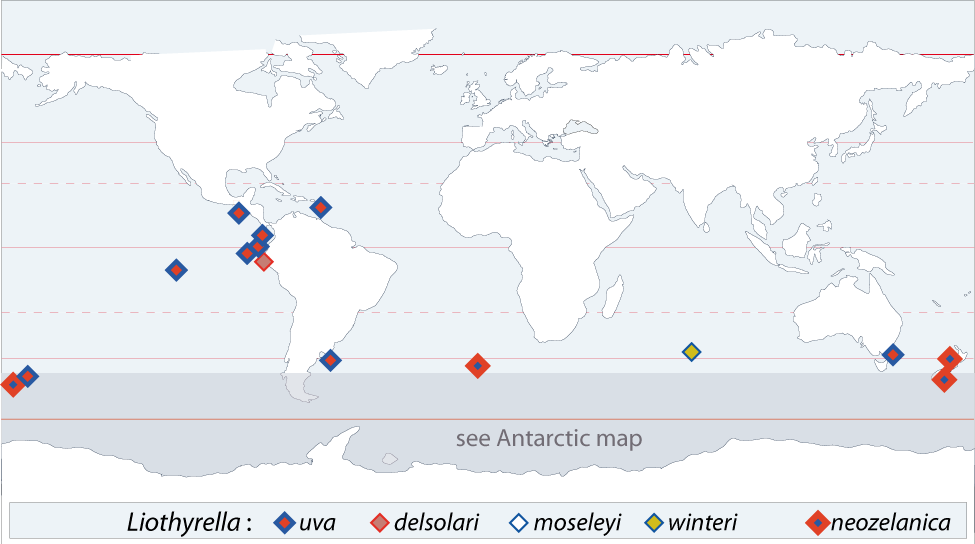
Liothyrella delsolari Cooper, 1982
Type locality: "4°00'S, 80°30'W, between Mancora and Chicama, Peru, at 760-1000 m."
Depth range: 760 - 1208 m.
References: Cooper (1982), Foster (1989).
Liothyrella moseleyi (Davidson, 1878)
Terebratula moseleyi Davidson, 1878
Liothyris moseleyi: Davidson (1886)
Terebratula (Liothyrina) moseleyi: Davidson (1892)
Liothyrina moseleyi: Blochmann (1906)
Liothyrella moseleyi: Hertlein & Grant (1944)
Type locality: "west of Kergelen Island, 210 fathoms [lat. 46°47'S., long. 51° 37'E. ; depth 210 fathoms" [384 m].
Depth range: some meters - 700 m.
References: Blochmann (1908), Cooper (1981), Dall (1908, 1921), Davidson (1878, 1880, 1886-1888), Fischer & Œhlert (1892), Foster (1974), Hiller (1994).
Liothyrella neozelanica Thomson, 1918
Liothyrina sp. Jackson, 1918
Liothyris neozelanica Zezina, 1976
Type locality: "on a flat stone entangled on a fishing line of 200 fathoms length, Cook Strait, off Wellington, New Zealand" [370 m].
Depth range: 6 - 1939 m.
References: Bowen (1968), Dawson (1971a, 1991), Foster (1968, 1974, 1989), Lee (1991), Lüter (2008), Richardson (1981a), Thomson (1918), Ullmann et al. (2017).
Liothyrella winteri(Blochmann, 1906)
Liothyrina winteri Blochmann, 1906
Liothyrella winteri Thomson, 1927
Type locality: "Valdivia, Station 165, St. Paul Tiefe 680 m" [38°40,0'S, 77°38,6'E, depth 672 m, NE of Saint-Paul Island, Valdivia-Expedition, 1898-1899].
Depth range: 672 - 680 m.
References: Blochmann (1906, 1908), d'Hondt (1977).

Genus Macandrevia King, 1859
[= Macandrewia Bronn, 1862; Frenula Dall, 1871; = Waldheimiathyris Helmcke, 1939; = Notorygmia Cooper, 1972]
[Type species= Terebratula cranium Müller, 1776 (p. 261)]
Diagnosis from volume 5 of the Treatise on Invertebrate Paleontology (Kaesler, 2006):
- Subpentagonal in outline, smooth or with fine radial sculpture, umbo suberect to erect, deltidial plates rudimentary, pedicle foramen possibly permesothyrid, attrite; teeth moderate to large, dental plates short, straight, ventrally divergent, united by callus deposit closely applied to floor of valve; crural bases fused with inner socket ridges, crural plates steeply inclined to floor of valve, extended anteriorly, forming long, V-shaped trough extending about 0.5 valve length, low median ridge present early in ontogeny, but median septum absent in adult, loop extending about 0.75 valve length, smooth except for anterior fringe of short spines, ascending branches and transverse band moderately broad with short, posterior projections at union; diductor muscle scars attached to small, transverse impression over dorsal umbo; endopunctae minute, rather widely separated.
Geological range: Eocene - Present (Holocene).
Macandrevia americana Dall, 1895
Eudesia fountaineana Dall, 1890 (not Terebratula fontainei d'Orbigny, 1846)
Macandrevia craniella Dall, 1895
Macandrevia vanhöffeni Blochmann, 1906
Magellana fragilis Joubin, 1914 (not M. fragilis Smith, 1907)
Macandrevia lata Thomson, 1918
Waldheimiathyris americana: Elliot (1951)
Waldheimiathyris vanhöffeni: Elliot (1951)
Waldheimiathyris lata Elliot, 1951
Macandrevia diegenensis Cooper, 1975
Type locality: "station 2783, in 122 fathoms, off the west coast of Patagonia, in latitude 51°2' south; and station 3360, in 1672 fathoms, in the Gulf of Panama" [223 and 3058 m].
Depth range: 71 – 4062 m
References: Blochmann (1906), Cooper (1973a, 1982), Dall (1921), Davidson (1886-1888), Eichler (1911), Foster (1969, 1974), Thomson (1918), Zezina (1980a).
Macandrevia diamantina Dall, 1895
Macandrevia coasti Helmcke, 1939
Notorygmia diamantina: Cooper (1972)
Notorygmia abyssa Cooper, 1972
Macandrevia aff. diamantina: Cooper, 1973a
Macandrevia (Notorygmia) diamantina: Zezina, 1980
Type locality: "off Cocos Island (approximately 550 km off the W shore of Costa Rica)."
Depth range: 2140 – 4600 m.
References: Cooper (1973a), Dall (1895, 1921), Davidson (1886-1888), Foster (1969, 1974), Jackson (1912), Thomson (1918), Zezina (1980a, 1993).
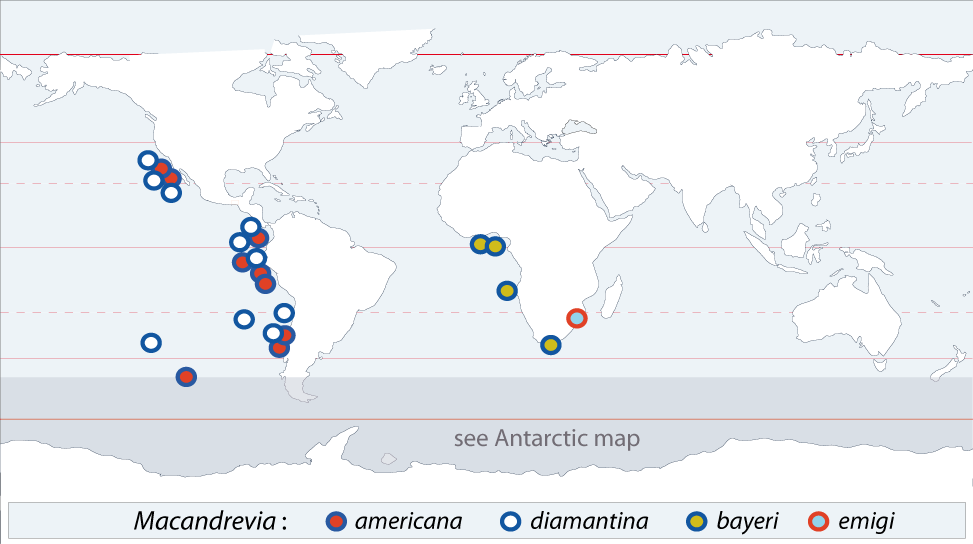
Genus Magasella Dall, 1870
[Type species= Terebratula sanguinea Leach, 1814 (p. 76)]
Diagnosis from Robinson et al. (2016):
- Medium to large, subpentagonal to oval, unisulcate, valve exterior strongly to weakly costate to smooth, fine concentric growth rings, beak erect to suberect, attrite, foramen medium to large, submesothyrid to mesothyrid, deltidial plates commonly conjunct. Cardinalia weakly to moderately thickened, cardinal process canoe-shaped with fine ridges, hinge plates excavate, moderately to steeply inclined, meeting on low, thin median septum to form septalium, adult loop trabecular, lophophore plectolophous.
Geological range: Present (Holocene).
Magasella sanguinea (Leach, 1814)
Anomia cruenta Dillwyn, 1817
Terebratella zelandica Deshayes, 1839
Terebratella rubicunda Sowerby, 1846
Terebratella rubra Sowerby, 1847 (non Pallas, 1766)
Terebratella evansii Davidson, 1852
Terebratella cruenta Davidson, 1887
Magasella sanguinea: Allan (1960)
Magasella sanguinea: Foster (1974)
Type locality: "Habitat in Nova Zelandia."
Depth range: 9 - 1030 m.
References: Àlvarez (2017), Blochmann (1913), Davidson (1886), Foster (1969, 1974, 1989), Jackson (1918), Robinson et al. (2016), Zezina (1980a).
Genus Magellania Bayle, 1880
[Type species= Terebratula flavescens Lamarck, 1819 (p. 246)]
Diagnosis from volume 5 of the Treatise on Invertebrate Paleontology (Kaesler, 2006):
- Medium to large, ovate, smooth as juvenile, becoming costate, unisulcate; beak suberect to erect; foramen large, mesothyrid, attrite; symphytium moderately high. Cardinalia lamellar with wide inner hinge plates and narrow outer hinge plates divided by narrow crural bases, hinge plates excavate, meeting on medium septum to form septalium; cardinal process a transverse myophore; crura short, crural processes prominent; loop teloform. Lophophore plectolophous.
Geological range: Miocene - Present (Holocene).
Magellania fragilis Smith, 1907
Stetothyris antarctica Thomson, 1918
Aerothyris fragilis: Allan (1939)
Victorithyris? antarctica Allan, 1940
Type locality: "Agassiz island, 300 fathoms, off ice barrier" [549 m].
Depth range: 75 – 1254 m.
References: Allan (1939, 1940a, 1940b), Brey et al. (1995), Eichler (1911), Foster (1974, 1989), Jackson (1918), Joubin (1914), Richardson (1997), Smith (1907), Thomson (1818), Zaky et al. (2016), Zezina (1980a, 1998).
Magellania joubini Blochmann, 1906
Magellania sulcata Smith, 1907
Campages joubini Hedley, 1911
Aerothyris joubini: Allan (1939)
Type locality: "Winter-station der Gaußexpedition in 385 m Tiefe" [66°20'S, 89°38' E].
Depth range: 80 – 1894 m.
References: Allan (1939, 1940a), Blochmann (1906), Cotton (1937), Dall (1921), Eichler (1911), Foster (1969, 1972, 1974, 1989), Jackson (1918), Richardson (1997), Thomson (1918), Smith (1907), Zezina (1980a, 1998).
Magellania venosa (Solander, 1786)
Anomia venosa Solander, 1786
Terebratula dilata Lamarck, 1819
Terebratula malvinae d'Orbigny, 1847
Terebratula fontanea d'Orbigny, 1847
Terebratula pulvinata Gould, 1850
Waldheimia venosa: Davidson (1861)
Magasella laevis Dall, 1870
Magellania venosa: Fischer & Œhlert (1892)
Magellania (Neothyris) venosa: Dall (1921)
Waldheimiathyris americana Elliot, 1951
Aerothyris? venosa: Levy (1961)
Magellania? venosa: Cooper (1981)
Type locality: "the country unkown" (Solander, 1786);
"Falkland's Islands" (Dixon, 1789).
Depth range: 2 – 3510 m.
References: Àlvarez (2017), Cohen et al. (2011), Dall (1921), Davidson (1886), Dixon (1789), Fischer & Œhlert (1892), Försterra et al. (2008), Foster (1969, 1974, 1989), Jackson (1912), Jackson et al. (2015), Richardson (1997), Roux & Bremec (1996), Solander (1786), Zezina (1980a).
Genus Manithyris Foster, 1974
[Type species= Manithyris rossi Foster, 1974 (p. 55)]
Diagnosis from volume 4 of the Treatise on Invertebrate Paleontology (Kaesler, 2002):
- Small, subequibiconvex, broadest anterior to midlength; finely capillate shell surface and irregularly ligate anterior commissure. Widely spaced crura spatulate, with outer surfaces strongly convex and inner surfaces concave, transitional between spinuliform and arcuiform; low dorsal median ridge; outer hinge plate narrow, no inner hinge plate.
Geological range: Present (Holocene).
Manithyris rossi Foster, 1974
Type locality: "HU st. 32-52 (73°19'S, 174°53.1'W): 2897-2904 m."
Depth range: 2897 - 2904 m.
Reference: Foster (1974).
Genus Melvicalathis Lee, Lüter & Zezina, 2008 in Lee et al. (2008)
[Type species= Eucalathis macroctena Zezina, 1981 (p. 159)]
Diagnosis from Lee et al. (2008):
- Costae broad, triangular in cross-section; foramen hypothyrid, beak very attrite; transverse band of loop medially directed towards dorsal valve; loop may be incomplete.
Geological range: Present (Holocene).
Melvicalathis macroctena (Zezina, 1981)
Type locality: "Akademik Kurchatov st. 261, 7.x.1969, 30°24'S, 78°59'W, 3870 m."
Depth range: 2009 - 4900 m.
References: Lee et al. (2008).
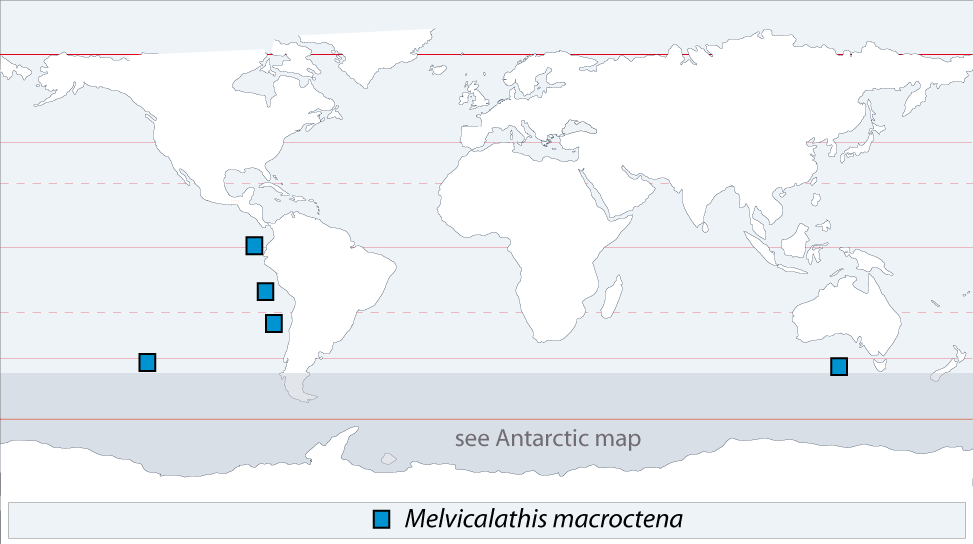
Genus Neorhynchia Thomson, 1915
[Type species= Hemithyris strebeli Dall, 1908 (p. 441)]
Diagnosis from volume 4 of the Treatise on Invertebrate Paleontology (Kaesler, 2002):
- Suboval to pentagonal, gently ventribiconvex, typically sulcate, smooth; broad but deep, arcuate anterior commissure; beak short, hypothyrid; foramen moderate, deltidial plates disjunct. Crura short, gently arcuiform.
Geological range: Present (Holocene).
Neorhynchia strebeli (Dall, 1908)
Neorhynchia strebeli: Thomson (1915)
Neorhynhia sp. Foster, 1969
Neorhynchia profunda Cooper, 1972
Neorhynchia abyssa Cooper, 1972
Neorhynchia strebeli rectimarginata Forster, 1974
Type locality: "U.S.S. Albatross, station 4721, in Mid Pacific, in 2084 fathoms" [16°48.3'N, 62°20.3'E, 3860 m].
Depth range: 1806 - 4682 m.
References: Barnes & Peck (1997), Foster (1967, 1969, 1974, 1989), Zezina (1975).
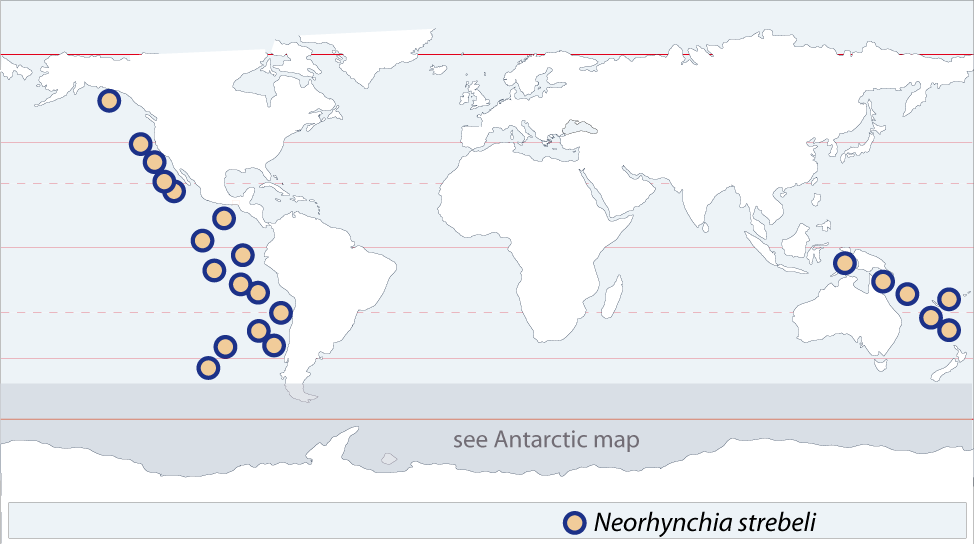
Genus Neothyris Douvillé, 1879
[Type species= Terebratula lenticularis Deshayes, 1839 (p. 274)]
Diagnosis from volume 5 of the Treatise on Invertebrate Paleontology (Kaesler, 2006):
- Large, smooth, weakly unisulcate, beak erect to incurved, foramen small, mesothyrid, attrite; deltidial plates conjunct. Strong posterior shell thickening in adults. Cardinalia thickened, crural bases fused with socket ridges; median septum short, high, bifurcating posteriorly to form wide hinge trough, almost filled by large, swollen boss of cardinal process; crura rather short, crural processes prominent; adult loop teloform. Lophophore plectolophous.
Geological range: Miocene - Present (Holocene).
Neothyris lenticularis (Deshayes, 1839)
Terebratula gaudichaudii Gray, 1833 (not Blainville, 1828)
Waldheimia lenticularis: Gray (1853)
Neothyris lenticularis: Douvillé (1879)
Magellania lenticularis: Suter (1911)
Magellania (Neothyris) lenticularis: Dall (1921)
Neothyris obtusa Thomson, 1920
Neothyris lenticularis compressa Neall, 1972
Neothyris dawsoni Neall, 1972
Neothyris parva Cooper, 1982
Neothyris compressa: Foster (1989)
Type locality: Foveaux Strait (Southern New Zealand).
Depth range: 0 - 1210 m.
References: Bowen (1968), Brand et al. (2003), Came et al. (2014), Foster (1967, 1969, 1974, 1989), Harper et al. (2011), Neall (1970, 1972), Parkinson et al. (2005), Richardson (1997), Zezina (1980a).

Fac-simile of the original description by Deshayes (1839).
Genus Novocrania Lee et Brunton, 2001
[Type species= Patella anomala Müller, 1776; ICZN plenary powers, 1988, opinion 1468]
Diagnosis from volume 2 of the Treatise on Invertebrate Paleontology (Kaesler, 2000):
- Dorsal valve convex to conical; beak subcentral to posterocentral, smooth, finely pustulose or rarely finely costellate; posterior margin commonly straight; recent species with dendroid shell punctation; dorsal posterior adductor scars large, rounded, thickened, widely separated; anterior scars commonly crescentic, raised above valve floor; weak myophragm bisects muscle field; encrusting; ventral valve uncalcified in recent species, otherwise sometimes thin; ventral posterior adductor scars large, anterior scars united medially; marginal mantle setae observed in recent forms; valve margins variably thickened, with limbus or faint submarginal rim.
Geological range: Paleogene (Eocene) - Present (Holocene).
Novocrania lecointei (Joubin, 1901)
?Crania pourtalesii Dall, 1890 (not Crania anomala var. pourtalesii Dall, 1871, p. 35)
Crania patagonica Dall, 1902
Crania joubini Thomson, 1918
Discina? joubini Thomson, 1918
Crania antarcticaensis Hatai, 1965
Neocrania lecointei: Lee & Brunton (1986)
Novocrania lecointei: Lee & Brunton (2001)
Type locality: "N° 578b. - Faubert VII – Lat.70°23' S., Long. 82°47'O - 8 Octobre 1898 – Profondeur : 500 m environ."
Depth range: 40 - 3310 m.
References: Brand et al. (2003), Cohen et al. (2014), Cooper (1973a, 1981), Dall (1921), Eichler (1911), Foster (1968, 1969, 1974), Hatai (1965), Robinson (2014), Sáiz et al. (2008), Thomson (1918), Zezina (1980a, 1981, 1994, 1998), Zezina & Pakhnevich (1998).
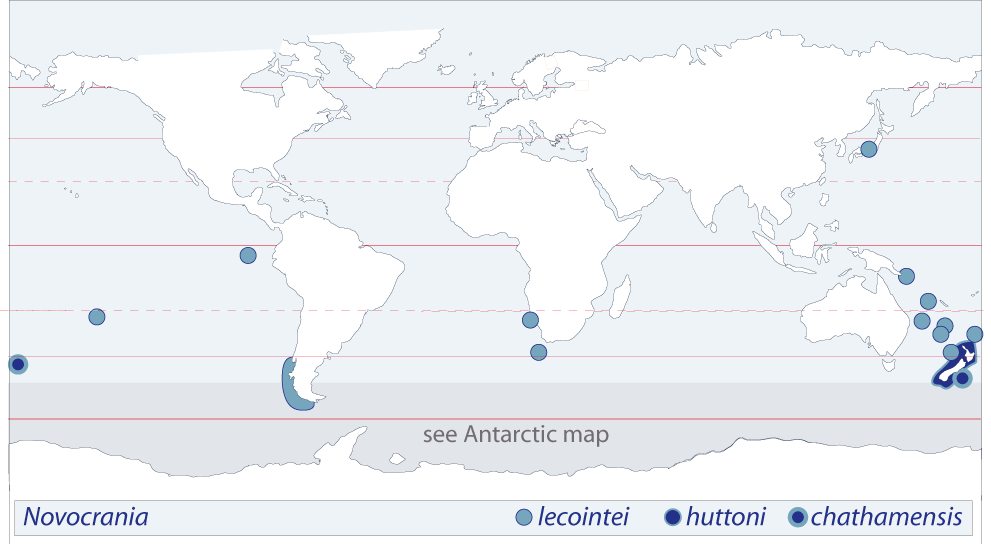
Genus Pelagodiscus Dall, 1908
[Type species= Discina atlantica King, 1868 (p. 171)]
Diagnosis from volume 2 of the Treatise on Invertebrate Paleontology (Kaesler, 2000):
- Similar to Discinisca but smaller, very thin-shelled; lophophore schizolophous.
Geological range: ?Miocene - Present (Holocene).
Pelagodiscus atlanticus (King, 1868)
Pelagodiscus atlantica Hatai, 1936
Type locality: "depth of 1240 fathoms, in N. lat. 52°8', W. long. 15°30', or nearly due west of Dingle Bay" [2268 m].
Depth range: 336 - 5530 m (empty shells until 7600 m).
References: Cooper (1981, 1982), Dall (1921), Eichler (1911), Foster (1967, 1969, 1974), Helmcke (1940), Jackson (1912), Zezina (1975, 1980a, 1981a, 1981b, 1993), Zezina et al. (1993).
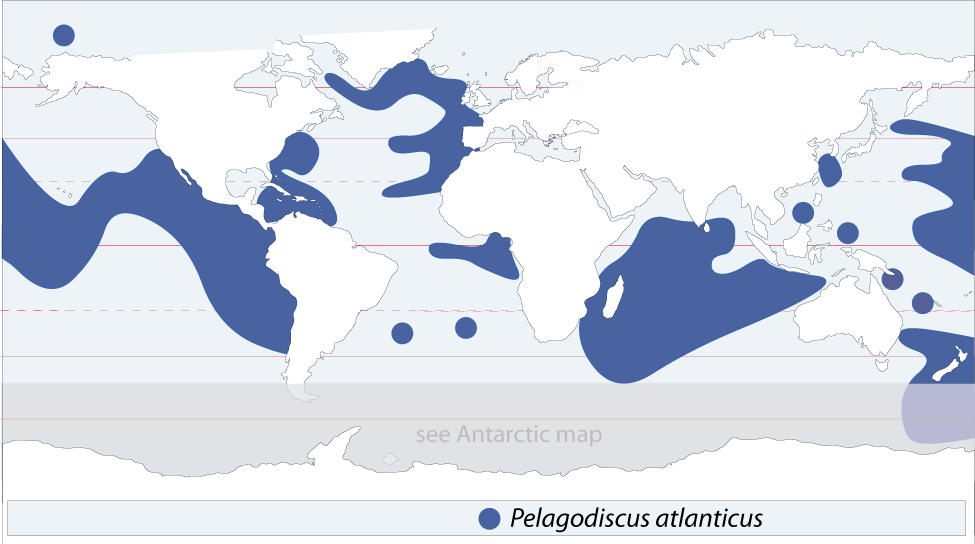
Genus Pemphixina Cooper, 1981
[Type species= Rhynchonella nigricans var. pyxidata Davidson, 1880 (p. 59)]
Diagnosis from volume 4 of the Treatise on Invertebrate Paleontology (Kaesler, 2002):
- Small to medium, moderately dorsibiconvex, rounded to globular, strongly uniplicate, but dorsal fold scarcely raised; beak short, erect, foramen hypothyrid, elongate-oval, small; deltidial plates disjunct; shell surface multicostellate, costellae rounded, interrupted by numerous concentric growth lines. Hinge teeth thick, buttressed by short dental plates; crura short, crescentic in cross section, incipiently canaliform; dorsal median septum short but rising to crest just anterior to crura.
Geological range: Present (Holocene).
Pemphixina pyxidata (Davidson, 1880)
Rhynchonella nigricans var. pyxidata Davidson, 1888
Tegulorhynchia pyxidata: Champan & Crespin (1923)
Notosaria nigricans pyxidata: Cooper (1959)
Notosaria pyxidata: d'Hondt (1977)
Type locality: "South of Kerguelen Island at Station 150, lat. 50°4'S., long. 71°22'E. Depth, 150 fathoms" [274 m].
Depth range: 185 - 900 m.
References: Chapman & Crespin (1923), Cooper (1959, 1981), Davidson (1880), Foster (1974), d'Hondt (1977).
Genus Phaneropora Zezina, 1981
[Type species= Phaneropora galatheae Zezina, 1981 (p. 18)]
Diagnosis from volume 5 of the Treatise on Invertebrate Paleontology (Kaesler, 2006):
- Small, subcircular, smooth, gently biconvex, anterior commissure rectimarginate; beak ridges slightly tuberculate; foramen large, hypothyrid, deltidial plates very narrow, disjunct, pedicle collar short; hinge teeth with small recessive dental plates. No cardinal process; high inner socket ridges with long crura that are anteromedially convergent; septal pillar platelike at its base with high, narrow distal extremity (axial loop phase), descending branches absent. Lophophore zygolphous and heavily spiculate.
Geological range: Present (Holocene).
Phaneropora galatheae Zezina, 1981
Leptothyrella cf. ignota: Hiller, 1986
Type locality: "Galathea" St. 554. 5 Dec. 1951. 37°28'S, 138°55'E, Great Australian Bight, 1320-1340 m."
Depth range: 184 - 4205 m.
References: Foster (1989), Zezina (1980a, 1981).
Genus Platidia Costa, 1852
[Type species= Orthis anomioides Scacchi & Philippi, 1844 in Philippi, 1844 (p. 69)]
Diagnosis from volume 5 of the Treatise on Invertebrate Paleontology (Kaesler, 2006):
- Small, subcircular to subquadrate in outline, planoconvex, thin shelled, semitransparent; smooth, or with radiating lines or spinules on ventral valve; hinge line wide, foramen large, amphithyrid; deltidial plates very narrow, disjunct. Pedicle collar short, sessile; hinge teeth with narrow dental plates and grooved, swollen bases; short ventral myophragm. Cardinal process absent; inner socket ridges strong; outer socket ridges narrow; no hinge plates; septal pillar located directly anterior to large amphithyrid pedicle embayment, bladelike and leaning anteriorly proximally but posteriorly deflected distally and terminating in a pair of posteriorly directed, Ushaped septal flanges; crura long and slender with short processes, descending branches strongly arcuate, uniting medianly with lateral flanks of Ushaped septal flanges. Lophophore zygolophous.
Geological range: Danian - Present (Holocene).
Platidia anomioides (Scacchi & Philippi, 1844 in Philippi, 1844)
Terebratula appressa Forbes, 1844
Platydia anomioides: Costa (1852)
Morrisia anomioides: Davidson (1853)
Platidia davidsoni (Deslongchamps, 1855)
Platidia marionensis Cooper, 1981
Amphithyris sp. Simões & Kowalewski, 2000
? Platidia concentrica Zezina, 1980
Type locality: Sicily.
Depth range: 8 - 2289 m.
References: Cooper (1981, 1982), Davidson (1880, 1886-1888), Foster (1974, 1989), Hiller (1994), Zezina (1980a), Zezina & Pakhnevich (1998, 2000).
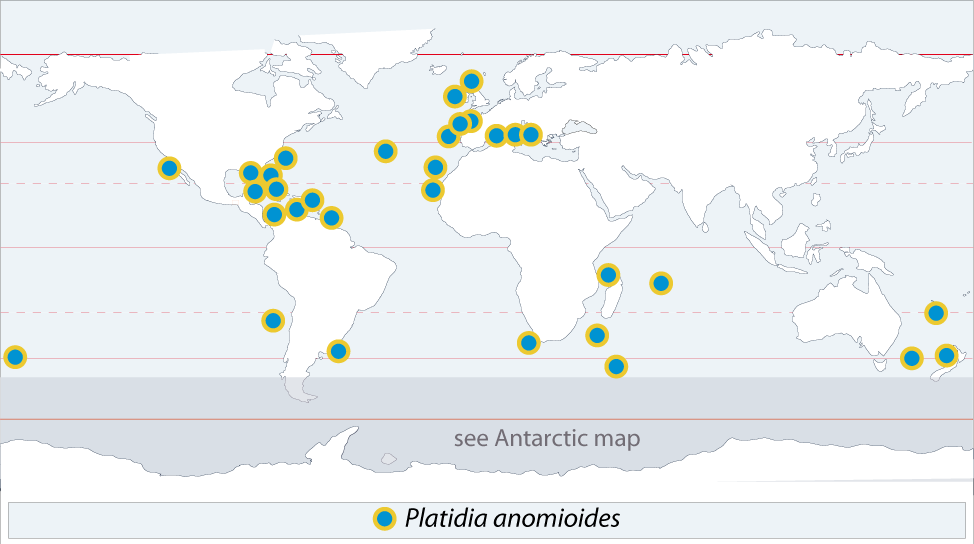
Genus Syntomaria Cooper, 1982
[Type species= Syntomaria curiosa Cooper, 1982 (p. 20)]
Diagnosis from volume 5 of the Treatise on Invertebrate Paleontology (Kaesler, 2006):
- Small, smooth but with prominent growth lines, elongate oval, narrowly biconvex, rectimarginate; beak suberect, attrite, foramen wide, deltidial plates narrow, disjunct. Cardinal process a well-developed transverse myophore; inner hinge plates excavate, uniting on valve floor; septal pillar high, anteriorly inclined, and narrow. Loop annular to incipiently haptoid; descending branches occasionally incomplete.
Geological range: Present (Holocene).
Syntomaria curiosa Cooper, 1982
Type locality: "Islas Orcadas cruise 575, sta 74, 56°12'S, 027°23.9'W, off the South Sandwich Islands, Antarctica, at 179-238 m."
Diagnosis (Cooper, 1982): Small, dark brown, biconvex, elongate oval shells with rudimentary deltidial plates and wide foramen.
Depth range: 161 - 486 m.
Reference: Cooper (1982), Richardson (1997).
Genus Terebratella d'Orbigny, 1847, p. 269
[Type species= Terebratula chilensis Broderip, 1833, p. 141 - (= Anomia dorsata Gmelin, 1790 (p. 3, 348); = Terebratula flexuosa King, 1835, p. 337; = Terebratula patagonica Gould, 1850, p. 347]
Diagnosis from volume 5 of the Treatise on Invertebrate Paleontology (Kaesler, 2006):
- Medium to large, transversely ovate, unisulcate, costate to strongly multicostate; beak erect to suberect, attrite, foramen medium to large, submesothyrid to mesothyrid, deltidial plates commonly conjunct. Cardinalia weakly to moderately thickened, hinge plates excavate, moderately to steeply inclined, meeting on low median septum to form septalium; adult loop trabecular. Lophophore plectolophous.
Geological range: Oligocene - Present (Holocene).
Terebratella dorsata (Gmelin, 1790)
Terebratella flexuosa King, 1831
Terebratula sowerbii King, 1831
Terebratula chilensis Broderip, 1833
Terebratula lupinus Philippi, 1845
Terebratula rhombea Philippi, 1845
Terebratula patagonica Gould, 1851
Terebratella dorsata var. submutica Fischer & Œhlert, 1892
? Terebratella rubiginosa Dall, 1871
Terebratella enzenspergeri Blochmann, 1906
Terebratella submutica Hertlein & Grant, 1944
Type locality: "Habitat in freto magellanico."
Depth range: 9 - 500 m (? 2653 m).
References: Àlvarez (2017), Cohen et al. (2011), Cooper (1973a, 1982), Cotton (1937), Dall (1873, 1921), Davidson (1886), Eichler (1911), Fischer & Œhlert (1892), Foster (1969, 1974, 1989), Gmelin (1790), Gould (1950), d'Hondt (1976, 1977), Jackson (1912), Richardson (1997), Roux & Bremec (1996), Zezina (1980a).
Note: see references for more extensive synonymies of this species.
Genus Terebratulina d'Orbigny, 1847
[Type species= Anomia retusa Linné, 1758 (p. 587)]
Diagnosis from volume 5 of the Treatise on Invertebrate Paleontology (Kaesler, 2006):
- Small to large, ovate to subpentagonal, slightly auriculate, valves biconvex; anterior commissure rectimarginate to uniplicate; surface costellate, costellae may be enlarged or granular, with prominent nodules in young; umbo suberect, foramen incomplete, mesothyrid to permesothyrid, deltidial plates disjunct. Pedicle collar present, median septum and hinge plates absent; cardinal process small; socket ridges and crural bases fused, forming prominent ridge, hinge teeth without swollen bases, but with sulcus on inner face; crura converging, crural processes united to form ringlike loop, transverse band ventrally arched.
Geological range: Upper Jurassic - Present (Holocene).
Terebratulina kiiensis Dall & Pilsbry, 1891
Terebratulina crossei: Fischer & Œhlert (1892) (not Davidson, 1882)
Terebratulina sp. Dall, 1908
Terebratulina magalhaenica Helmcke, 1939
Terebratulina crossei ?: Foster (1969)
Type locality: "Coasts of Province Kii, Japan, Strearns;"
Depth range: 18 – 1370 m (?4640 m).
References: Cooper (1982), Dall (1921), Fischer & Œhlert (1892), Foster (1969, 1989), Helmcke (1939a), Lüter & Sieben (2005).
Note: Helmcke (1939b, p. 240) mentioned that the diagnoses of the new species would follow later in a revision of the genus. Foster (1989, p. 284) stated that "the differences among the species of Terebratulina are in great need of further study on a worldwide level." As Lüter & Sieben (2005) emphasized, this revision was never done until today.
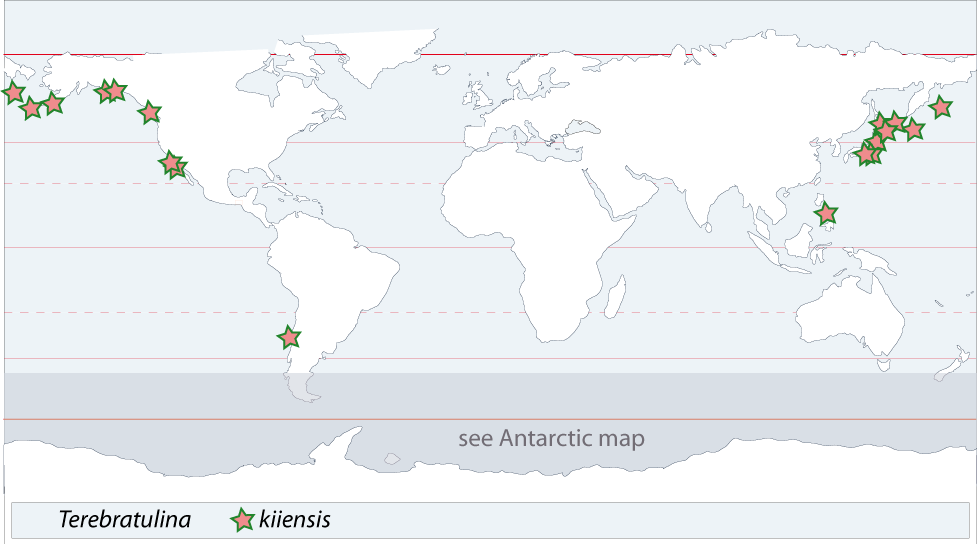
Genus Xenobrochus Cooper, 1981
[Type species= Gryphus africanus Cooper, 1973b (p. 8)]
Diagnosis from volume 5 of the Treatise on Invertebrate Paleontology (Kaesler, 2006):
- Small to medium, oval, ventribiconvex, smooth; anterior commissure rectimarginate; beak long, erect, labiate, foramen large, permesothyrid, symphytium visible; pedicle collar short, teeth large; cardinal process broad, semielliptical; hinge plates narrow, poorly defined; loop narrow, rounded, transverse band convex anteriorly.
Geological range: Present (Holocene).
Xenobrochus africanus (Cooper, 1973b)
Gryphus africanus Cooper, 1973b
Xenobrochus anomalus Cooper, 1981
Type locality: "Anton Bruun Cruise 7, Station 358A, 366 m, 29°19'S, 32°00'E, Durban Bay, South Africa."
Depth range: 70 - 850 m.
Reference: Hiller (1994).
Xenobrochus anomalus Cooper, 1981
Type locality: "MD.08: station 15, BB 88 - Latitude 46°57.7'S, longitude 37°59.9'E, southeast of Marion Island at 204 m."
Depth range: 204 - 460 m.
Diagnosis (Cooper, 1981): Very small, elongate oval Xenobrochus with tubular pedicle collar and extended, erect, socket ridges.
References: Cooper (1981), Hiller (1994)
Xenobrochus australis Cooper, 1981
Not Xenobrochus australis: Bitner (2009) - now X. norfolkensis Bitner, 2011
Type locality: "MD.08: station 11, CP 7 - Latitude 53°20.3'S, longitude 72°29.2'E, west of Heard Island at 790 m."
Depth range: 200 - 967 m.
Diagnosis (Cooper, 1982): Large Xenobrochus with width 60% of length.
References: Cooper (1981).
Acknowlegements
This study is a contribution to the SCAR-Marine Biodiversity Information Network (SCAR-MarBIN) and to the Register of Antarctic Marine Species (RAMS). It was support by a grant of the
"Fondation Total". De Broyer Claude, Danis Bruno and the SCAR-MarBIN staff are thanked for their technical help in data management. The objective of RAMS is to compile and manage an authoritative taxonomic list of species occurring in the Antarctic marine environment, for establishing a standard reference for marine biodiversity research, conservation and sustainable management. The data are included into the Brachiopoda database: http://paleopolis.rediris.es/brachiopoda_ database/index.html.
My best thanks to my friends Aleksandra Bitner, Instytut Paleobiologii, PAN, Warszawa (Poland) and Fernando Álvarez, Universidad de Oviedo (Spain), for their comments and improvement.
Bibliographic references
Alexander R.R. (1990). Mechanical strength of shells of selected extant articulate brachiopods: implications for paleozoic morphologic trends. Historical Biology, 3, 169-188.
Allan R.S. (1939). Studies on the Recent and Tertiary Brachiopoda of Australia and New-Zealand (part I). Records of the Canterbury Museum, 4 (5), 231-248.
Allan R.S. (1940a). A revision of the classification of the terebratelloid brachiopoda. Records of the Canterbury Museum, 4 (6), 267-275.
Allan R.S. (1940b). Studies on the Recent and Tertiary Brachiopoda of Australia and New-Zealand (part II). Records of the Canterbury Museum, 4 (6), 277-296 (Pls. xxxv - xxxvii).
Álvarez F. (2017). Recent brachiopods in the Œhlert collection: pp. 25-109, and Specimens in the collections of Marquis de Monterosato and Frédéric Cailliaud housed in the Musée des Sciences, Laval: pp. 111-122. In: Álvarez F., Emig C.C. & Tréguier J. (eds.), Brachiopodes actuels: historique et révision de la collection D.-P. Œhlert (Laval) ; brachiopodes des côtes françaises métropolitaines. Carnets de Géologie, CG2017_B02, 25-122, and references: 183-188.
Álvarez F., Curry G.B., Brime C. & Anadón N. (2010). Variation in the shell morphology of Compsothyris (Brachiopoda, recent): an example of the problems associated with the compilation of data matrices for phylogenetic analysis and the preparation of electronic databases. Special Papers in Palaeontology, 84, 13-39.
Arnaud P.M. & Emig C.C. (1987). La population, unité fonctionnelle de la biocoenose. Actes du Colloque National Biologie des Populations, C.N.R.S., Lyon 1986, pp. 69-72.
Arndt W. & Grieg J.A. (1933). Die Brachiopoden des arktischen Gebietes (Deutschen Expedition in das nördliche Eismeer im Jahre 1898). Fauna Arctica, 6 (5), 479-488.
Barnes D.K.A. & Clarke A. (1995.) Epibiotic communities on sublittoral macroinvertebrates at Signy island, Antarctica. Journal of marine biological Association of the United Kingdom, 75, 689-703.
Barnes D.K.A. & Peck L.S. (1997). An Antarctic shelf population of the deep-sea, Pacific brachiopod Neorhynchia strebeli. Journal of marine biological Association of the United Kingdom, 77, 399-407.
Bitner M.A. (2009). Recent Brachiopoda from the Norfolk Ridge, New Caledonia, with description of four new species. Zootaxa, 2235, 1–39.
Bitner M.A. (2011). Xenobrochus norfolkensis (Brachiopoda: Dyscoliidae), a new species from the Norfolk Ridge, New Caledonia, South-West Pacific. Carnets de Géologie / Notebooks on Geology, Article 2011/05 (CG2011_A05), 203-211.
Blochmann F. (1906). Neue Brachiopoden der Valdivia- und Gaußexpedition. Zoologischer Anzeiger, 30 (21-22), 690-702 & 824.
Blochmann F. (1908). Zur Systematik und geographischen Verbreitung der Brachiopoden. Zeitschrift für wissenschaftliche Zoologie, 90, 596-644.
Blochmann F. (1910). New brachiopods from South Australia. Transactions of the Royal Society of South Australia, 34, 89-99 (2 Pls.).
Blochmann F. (1913). Some Australian brachiopods. Papers and Proceedings of the Royal Society of Tasmania, 1913, 112-115.
Boullier A., Delance J.H., Emig C.C., d'Hondt J.L., Gaspard D. & Laurin B. (1986). Les populations de Gryphus vitreus (Brachiopoda) en Corse. Implications paléontologiques. Biostratigraphie du Paléozoïque, Brest, 4, 179-196 (1 Pl.).
Bowden D.A., Clarke A., Peck L.S. & Barnes D.K.A. (2006). Antarctic sessile marine benthos: colonisation and growth on artificial substrata over three years. Marine Ecology Progress Series, 316, 1-16.
Bowen Z.P. (1968). A guide to New Zealand Recent brachiopods. Tuatara, 16 (2), 127-150.
Brand U., Logan A., Hiller N. & Richardson J. (2003). Geochemistry of modern brachiopods: applications and implications for oceanography and paleoceanography. Chemical Geology, 198, 305-334.
Brey T., Peck L.S., Gutt J., Hain S. & Arntz W.E. (1995). Population dynamics of Magellania fragilis, a brachiopod dominating a mixed-bottom macrobenthic assemblage on the Antarctic shelf. Journal of marine biological Association of the United Kingdom, 75, 857-869.
Broderip W.J. (1833). Descriptions of some new species of Cuvier's family of Brachiopoda. Proceedings of the Zoological Society of London, 1, 124-128.
Bulman O.M. (1939). Muscle systems of some inarticulate brachiopods. Geological Magazine, 76, 434-444.
Came R.E., Brand U. & Affek H.P. (2014). Clumped isotope signatures in modern brachiopod carbonate. Chemical Geology, 377, 20-30.
Carpenter Dr., Jeffreys J.G. & Thomson W. (1869). Preliminary report of the scientific exploration of the deep sea in H.M.Surveying-Vessel 'Porcupine,' during the Summer of 1869. Proceedings of the Royal Society of London, 18, 397-492.
Chapman F. & Crespin I. (1923). The Austral Rhynchonellacea of the "Nigricans series", with a description of the new genus Tegulorhynchia. Proceedings of the Royal Society of Victoria, 35 (2), 170-193 (Pls. 11-13).
Cohen B.L., Bitner M.A., Harper E.M., Lee D.E, Mutschke E. & Sellanes J. (2011). Vicariance and convergence in Magellanic and New Zealand long-looped brachiopod clades (Pan-Brachiopoda: Terebratelloidea). Zoological Journal of the Linnean Society, 162, 631-645.
Cohen B.L., Gawthrop A.B. & Cavalier-Smith T. (1998). Molecular phylogeny of brachiopods and phoronids based on nuclear-encoded small subunit ribosomal RNA gene sequences. Philosophical Transactions of the Royal Society of London, B 353, 2039-2061.
Cohen B.L., Kaulfuss A. & Lüter C. (2014). Craniid brachiopods: aspects of clade structure and distribution reflect continental drift (Brachiopoda: Craniiformea). Zoological Journal of the Linnean Society, 171 (1), 133-150.
Cooper G.A. (1959). Genera of Tertiary and Recent Rhynchonelloid Brachiopods. Smithsonian miscellaneous Collection, 139 (5), 1-90 (22 Pls.).
Cooper G.A. (1973a). Vema's brachiopods (Recent) Smithson. Smithsonian Contributions to Paleobiology, 17, 1-51.
Cooper G.A. (1973b). New Brachiopoda from the Indian Ocean. Smithsonian Contributions to Paleobiology, 16, 1-43 (8 Pls.).
Cooper G.A. (1981). Brachiopoda from the Southern Indian Ocean (Recent). Smithsonian Contributions to Paleobiology, 43, 1-93 (14 Pls.).
Cooper G.A. (1982). New brachiopoda from the Southern hemisphere and Cryoptopora from Oregon (Recent). Smithsonian Contributions to Paleobiology, 41, 1-43 (7 Pls.).
Cotton B.C. (1937). Brachiopoda. B.A.N.Z. Antarctic Research Expedition 1929–1931 Reports, Adelaide, series B, vol. 4, part 1, 20-22.
Dall W.H. (1873). Catalogue of the recent species of the class Brachiopoda. Proceedings of the Academy of natural Sciences of Philadelphia, 25, 177-204.
Dall W.H. (1895). Report on mollusca and brachiopoda dredged in deep water, chiefly near the Hawaiian Islands, with illustrations of hitherto unfigured species from Northwest America. Proceedings of the United States National Museum, 17, 1894, 675-733 (Pls xxiii-xxxii).
Dall W.H. (1908). Reports on the dredging operations off the West coast of Central America to the Galapagos, to the West coast of Mexico, and the Gulf of California, in charge of Alexander Agassiz, carried on by the U. S. Fish Commission steamer "Albatross" during 1891, Lieut. Commander Z. L. Tanner, U. S. N., Commanding, XXXVIII, and Reports on the scientific results of the Expedition to the Eastern tropical Pacific in charge of Alexander Agassiz, by the U. S. Fish Commission steamer "Albatross" from October 1904, to March 1905, Lieut. Commander L. M. Garrett, U. S. N., Commanding, XIV. Reports on the Mollusca and Brachiopoda. Bulletin of the Museum of comparative Zoology, Harvard College, 43 (6), 205-477 (22 Pls.).
Dall W.H. (1921). Annotated list of the Recent Brachiopoda in the Collection of the United States National Museum, with descriptions of thirty-three new forms. Proceedings of the United States National Museum, 57 (2314), 261-377.
Dall W.H. & Pilsbry H.A. (1891). Terebratulina (unguicula CPR. var?) kiiensis Dall and Pislbry. Nautilus, 5 (2), 18-19 (1 Pl.).
Davidson T. (1878). Extract from a report to Professor Sir Wyville Thomson F.R.S., director of the civilian scientific staff, on the Brachiopoda dredged by H.M.S. Challenger. Proceedings of the Royal Society of London, 27, 428-439.
Davidson T. (1880). Report on the Brachiopoda dredged by the H.M.S. Challenger during the years 1873-1876. Report on the scientific Results of the Voyage of HMS Challenger, 1 (1), 1-67 (Pls. 1-4).
Davidson T. (1886-1888). A monograph of the Recent Brachiopoda. Part I., pp. 1-74 (Pls. 1-13) (1886); Part II, pp. 75-182 (Pls. 14-25)(1887); Part III, pp. 183-248 (Pls. 26-30) (1888). Transactions of the Linnean Society of London, (2) 4 (Zoology), 1-248 (Pls. 1-30).
Dawson E.W. (1971a). A reference list and bibliography of the Recent brachiopoda of New Zealand. Journal of the Royal Society of New Zealand, 1 (2), 159-174.
Dawson E.W. (1971b). On the proper usage of the name Terebratulina hedleyi Finlay, 1927 for Cancellothyris australis Thomson, 1927 (Brachiopoda). Records of the Dominion Museum, Wellington, 7 (16), 151-154.
Dawson E.W. (1972). On the date of publication of J. Allan Thomson's ‘brachiopod morphology and genera'. Tuartara, 19 (2), 57-60.
Dawson E.W. (1991). The systematics and biogeography of the living Brachiopoda of New Zealand. In: Brachiopods through time, MacKinnon D.I., Lee D.E. & J.D. Campbell (eds.), Balkema, Rotterdam, pp. 431-437.
De Broyer C., Danis B. & 64 SCAR-MarBIN Taxonomic Editors [of whom Emig C.C.] (2011). How many species in the Southern Ocean? Towards a dynamic inventory of the Antarctic marine species. Deep-Sea Research II, 58, 5-17.
Deshayes G.P. (1839). Nouvelles espèces de mollusques, provenant des côtes de la Californie, du Mexique, du Kamtschatka et de la Nouvelle-Zélande. Revue zoologique (Société Cuvierienne, Paris), 2, 356-361.
D'Hondt J.L. (1976). Sur quelques brachiopodes actuels (Océan Atlantique, Méditerranée, Kerguelen). Bulletin du Muséum national d'Hisoire naturelle de Paris, (Zool. 243) 350, 1-13.
D'Hondt J.L. (1977). Résultats scientifiques de la campagne MD04/Benthos. Brachiopodes. CNFRA (Comité national français pour les Recherches antarctiques), 42, 66-69.
Dixon G. (1789). Anomia venosa. In: A voyage round the world, but more particularly to the North-West coast of America: performed in 1785, 1786, 1787, and 1788, in the King George and Queen Charlotte, captains Portlock and Dixon, Appendix 1, pp. 355-356. Goulding, London.
Dixon G. (1789). Anomie veinée. Voyage autour du monde, et principalement à la côte nord-ouest de l'Amérique, fait en 1785, 1786, 1787 et 1788, à bord du King-George et de la Queen-Charlotte, par les capitaines Portlock et Dixon, Appendix n°1, pp. 281. Maradan, Paris [in French].
Eichler P. (1911). Die Brachiopoden der Deutsche Südpolar-Expedition 1901-1903. Deutsche Südpolar-Expedition 1901-1903 im Auftrage des Reichsamtes des Innern, herausgegeben von Erich von Drygalski, 12 (Zool. 4) (4), 381-401.
Emig C.C. (1992). Functional disposition of the lophophore in living Brachiopoda. Lethaia, 25, 291-302.
Emig C.C. (1997). Ecology of inarticulated brachiopods. In: Kaesler R.L. (ed.), Treatise on Invertebrate Paleontology. Part H revisited Brachiopoda. Geological Society of America (Boulder, Colorado) & University of Kansas (Lawrence, Kansas), vol. 1, 473-495.
Emig C.C. (2013). Daniel Œhlert (1849-1920) : biographie scientifique et bibliographie. Carnets de Géologie [Notebooks on Geology], Article 2013/08 (CG2013_A08), 303-314.
Emig C.C. (2017). Les brachiopodes des côtes françaises métropolitaines. In: Álvarez F., Emig C.C. & Tréguier J. (eds.), Brachiopodes actuels: historique et révision de la collection D.-P. Œhlert (Laval) ; brachiopodes des côtes françaises métropolitaines. Carnets de Géologie, CG2017_B02, 129-167, and references: 183-188.
Finlay H.J. (1927). New specific names for Austral Mollusca. Transactions and Proceedings of the New Zealand Institute, 57, 488-533.
Fischer P. & Œhlert D.-P. (1892). Brachiopodes de la mission scientifique du Cap Horn, 1882-1883. Bulletin de la Société d'Histoire naturelle d'Autun, 5, 254-334.
Försterra G., Häussermann V. & Lüter C. (2008). Mass occurrence of the recent brachiopod Magellania venosa (Terebratellidae) in the fjords Comau and Reñihué, northern Patagonia, Chile. Marine Ecology, 29, 342-347.
Foster M.W. (1967). A summary of Harvard University's brachiopod studies on Eltanin Cruise 27. Antarctic Journal of the United States, 2 (5), 192.
Foster M.W. (1968). Harvard University's brachiopod studies on Eltanin Cruise 32. Antarctic Journal of the United States, 3 (5), 160.
Foster M.W. (1969). Brachiopoda. Antarctic Map Folio Series, American Geographical Society, New York, 11, 21-22 (Pl. 9).
Foster M.W. (1972). Marine invertebrates from Adelie Land, collected by the XIIth and XVth French Antarctic expeditions. 7.- Brachiopoda. Téthys (Supplément 4), p. 103.
Foster M.W. (1974). Recent Antarctic and subAntarctic brachiopods. Antarctarctic Research Series, Washington, 21, 1-189.
Foster M.W. (1989). Brachiopods from the extreme South Pacific and adjacent waters. Journal of Paleontology, 63 (3), 268-301.
Gaspard D. (2001). Représentativité des Brachiopodes de la Caraïbe du Crétacé à l'Actuel. In : L'exploration naturaliste des Antilles et de la Guyane, CTHS, Paris, pp. 23-44.
Gmelin J.F. (1790). Caroli a Linné, systema naturae. Beer, Lipsiae (=Leipzig), Tomus 1, Pars VI, pp. 3021–3910.
Gould A.A. (1851). Shells from the United States Exploring Expedition. Proceedings of the Boston Society of natural History, 3, 343-348.
Harper E.M. & Peck L. (2003). Predatory behaviour and metabolic costs in the Antarctic muricid gastropod Trophon longstaffi. Polar Biology, 26, 208-217.
Harper E.M., Robinson J.H. & Lee D.E. (2011). Drill hole analysis reveals evidence of targeted predation on modern brachiopods. Palaeogeography, Palaeoclimatology, Palaeoecology, 305, 162-171.
Hatai K.M. (1940). The Cenozoic Brachiopoda of Japan. Science Reports of the Tohuku Imperial University, Sendai, (second series, Geology) 20, 413 pp. (26 figs.,12 Pls.).
Hatai K. (1959). A new Rhynchonellid (Brachiopoda) from Antarctica. In: Biological results of the Japanese Antarctic Research expedition. Special Publication of the Seto marine biological Laboratory, 4, 3-7.
Hatai K. (1965). On a species of Crania (Brachiopoda) from Antarctica. Japanese Antarctic Research Expedition (JARE) Scientific Reports, series E. 26, 1-4 (1 Pl.).
Helmcke J.-G. (1939a). Die Verbeitung von Terebratulina crossei Davidson und das Problem der diskontinuierlichen Verbreitung. Zeitschrift für wissenschaftliche Zoologie, 152, 12-26.
Helmcke J.-G. (1939b). Die Brachiopoden des Zoologischen Museums zu Berlin. III. Sitzungsberichte der Gesellschaft Naturforschender Freunde zu Berlin, Jahrgang 1938 (Oktober–Dezember), pp. 221-268.
Helmcke J.-G. (1940). Die Brachiopoden der Deutschen Tiefsee-Expedition. Wissenschaftliche Ergebnisse der DeutschenTiefsee-Expedition auf dem Dampfer "Valdivia" (1888-1899), Fischer Verlag, Jena, 24 (3), 215-316.
Hiller N. (1986). The South African museum's "Meiring Naude" cruises. Part 16. Brachiopoda from the 1975-1979 cruises. Annals of the South African Museum, 97 (5), 97-140.
Hiller N. (1994). The biogeographic relationships of the Brachiopoda fauna from Marion and Prince Edwards islands. South African Journal of Antarctic Research, 24 (1/2), 67-74.
ICZN - International Commission on Zoological Nomenclature (1999). International code of zoological nomenclature, Fourth Edition, adopted by the International Union of Biological Sciences, The International Trust for Zoological Nomenclature / The Natural History Museum, London, xxix + 306 pp.
Jackson D.J., Mann K., Häussermann V., Schillhabel M., Lüter C., Griesshaber E., Schmahl W. & Wörheide G. (2015). The Magellania venosa biomineralizing proteome: a window into brachiopod shell evolution. Genome Biology and Evolution, 7 (5), 1349-1362.
Jackson J.W. (1912). The Brachiopoda of the Scottish National Antarctic Expedition (1902 to 1904), VI. The Brachiopoda of the Scottish National Antarctic Expedition. Report of the scientific Results of Voyage of the S.Y. Scotia during the years 1902, 1903 and 1904, Edinburg, 6 (6), 141-168, and Transactions of the Royal Society of the Edinburg, (2) 48 (19), 337-390 (Pls. i & ii).
Jackson J.W. (1918). Brachiopoda. British Antarctic ("Terra Nova") Expedition, 1910, natural History Report, British Museum, Zoology, 2 (8), 177-202.
Jeffreys J.G. (1869). The deep-sea dredging expedition in H.M.S. "Porcupine." Nature, 1 (5), 135-137.
Jeffreys J.G. (1876). On some new and remarkable North-Atlantic Brachiopoda. Annals & Magazine of Natural History, (series 4) 18, 250-253.
Joubin L. (1901). Brachiopodes. Résultats du voyage du S.Y. Belgica en 1897-1898-1899 : sous le commandement de A. de Gerlache de Gomery. Rapports scientifiques publiés aux frais du gouvernement belge, sous la direction de la Commission de la Belgica, Zoologie, 8 (6), 1-11 (2 Pls.).
Joubin L. (1914). Brachiopodes. 2e Expédition antarctique française 1908-1910, Masson, Paris, pp. 39-43.
Kaesler R.L. (ed.), 1997-2006. Treatise on invertebrate paleontology. Part H, Brachiopoda, revised, vols. 1-5. Geological Society of America and University of Kansas Press, Boulder, Colorado, and Lawrence, Kansas.
King W. (1868). On some palliobranchiate shells from the Irish Atlantic. Proceedings of the Natural History Society of Dublin, 5 (3-4), 170-173.
Küster H.C. (1843). Brachiopoden. Conchylien-Cabinet von Martini und Chemnitz, Bauer & Raspe, Nürnberg, 7 (1), 7-49 (7 Pls.).
Laurin B. (1997). Brachiopodes récoltées dans les eaux de la Nouvelle-Calédonie et des îles Loyauté, Matthew et Chesterfield. In : A. Crosnier (ed.), Résultats des campagnes MUSORSTOM, vol. 18. Mémoires du Muséum national d'Histoire naturelle de Paris, 176, 411-471.
Leach W.E. (1814). Terebratula. In: Zoological miscellany: being descriptions of new or interesting animals. Nodder, London, Vol. 1, pp. 75-76 (Pl. xxxiii).
Lee D.E. (1991). Aspects of the ecology and distribution of the living Brachiopoda of New Zealand. In: Brachiopods through time, MacKinnon D.I., Lee D.E. & Campbell J.D. (eds.), Balkema, Rotterdam, pp. 273-279.
Lee D.E., Carlson S.J., Buening N. & Samson C.R. (2001). Variation in the loop of two Recent species of Liothyrella (Brachiopoda; Terebratuloidea) from New Zealand and South Orkney Islands. Systematic Association Special Volume Series, 63, 56-70.
Lee D.E., Gregory M.R., Lüter C., Zezina O.N., Robinson J.H. & Christie D.M. (2008). Melvicalathis, a new brachiopod genus (Terebratulida: Chlidonophoridae) from deep sea volcanic substrates, and the biogeographic significance of the mid-ocean ridge system. Zootaxa, 1866, 136-150.
Lüter C. (2008). Recent brachiopods collected during the deep-sea cruise SO 168 Zealandia with the research vessel FS Sonne between Mt. Spong (Tasman Sea) and the Chatham Islands (Pacific) in 2002/2003. Fossils and Strata, 54, 311-320.
Lüter C., Kohlberg G. & Schories D. (2016). Lamp shells, Brachiopoda. In: Marine wildlife, King George Island, Antarctica, Schories D. & Kohlberg G. (eds.), Schories Publications, Rostock, pp. 240-241.
Lüter C. & Sieben K. (2005). Types of recent Brachiopoda in the Museum für Naturkunde, Berlin - catalogue and taxonomic notes. Mitteilungen aus dem Museum für Naturkunde in Berlin, (Zoologische Reihe) 91 (2), 177-192.
Mahon A.R., Amsler C.D., McClintock J.B., Amsler M.O. & Baker B.J. (2003). Tissue-specific palatability and chemical defenses against macropredators and pathogens in the common articulate brachiopod Liothyrella uva from the Antarctic Peninsula. Journal of experimental marine Biology and Ecology, 290 (2), 197-210.
Marshall J.D., Pirrie D., Clarke A., Nolan C.P. & Sharman J. (1997). Stable-isotopic composition of skeletal carbonates from living Antarctic marine invertebrates. Lethaia, 29, 203-212.
Martens E. von & Pfeffer G. (1886). Die Mollusken von Süd-Georgien nach der Ausbeute der Deutschen Station 1882-1883. Jahrbuch der Hamburgischen wissenschaftlichen Anstalten, 3, 63-135.
McClintock J.B., Slattery M. & Thayer C.W. (1993). Energy content and chemical defense of the articulate brachiopod Liothyrella uva (Jackson, 1912) from the Antarctic Peninsula. Journal of experimental marine Biology and Ecology, 169, 103-116.
Meidlinger K., Tyler P.A. & Peck L.S. (1998). Reproductive patterns in the Antarctic brachiopod Liothyrella uva. Marine Biology, 132 (1), 153-162.
Nauendorf A., Wörheide G. & Lüter C. (2014). Revision of the brachiopod genus Amphithyris (Rhynchonelliformea: Platidiidae) with descriptions of two new species. Zootaxa, 3847 (2), 221-240.
Neall V.E. (1970). Notes on the ecology and paleoecology of Neothyris, an endemic New-Zealand brachiopod. New Zealand Journal of marine and freshwater Research, 4, 117-125
Neall V.E. (1972). Systematics of the endemic New Zealand brachiopod Neothyris. Journal of the Royal Society of New Zealand, 2 (2), 229-247.
Œhlert D.-P. (1906). Notes sur les brachiopodes recueillis au cours de l'expédition antarctique française commandée par le Dr J. Charcot. Bulletin du Muséum National Histoire naturelle de Paris, 12 (7), 555-557.
Œhlert D.-P. (1908). Brachiopodes. 1e Expédition Antarctique française 1903-1905, Masson, Paris, pp. 1-3.
Owen R. (1835). On the anatomy of the Brachiopoda of Cuvier, and more especially of the genera Terebratula and Orbicula. Transactions of the Zoological Society of London, 145-164 (Pls. 22-23).
Pakhnevich A.V., Zezina O.N. & Temereva E.N. (2013). Modern brachiopods and phoronids in the collections of the Zoological Museum of the Moscow University [in Russian]. Zoologicheskie issledovania, 13, 48 pp.
Parkinson D., Curry G.B., Cusack M. & Fallick A.E. (2005). Shell structure, patterns and trends of oxygen and carbon stable isotopes in modern brachiopod shells. Chemical Geology, 219 (1-4), 193-235.
Peck L.S., Barnes D. & Willmott J. (2005). Responses to extreme seasonality in food supply: diet plasticity in Antarctic brachiopods. Marine Biology, 147 (2), 453-463.
Peck L.S. & Brey T. (1996). Bomb signals in old Antarctic brachiopods [Letter]. Nature, 380 (6571), 207-208.
Peck L.S. & Holmes L.J. (1989). Scaling patterns in the Antarctic brachiopod Liothyrella uva (Broderip, 1833). Journal of experimental marine Biology and Ecology, 133, 141-150.
Peck L.S., Meidlinger K. & Tyler P.A. (2001). Developmental and settlement characteristics of the Antarctic brachiopod Liothyrella uva (Broderip 1833). Systematic Association Special Volume Series, 63, 80-90.
Peck L.S. & Robinson K. (1994). Pelagic larval development in the brooding Antarctic brachiopod Liothyrella uva. Marine Biology, 120, 279-286.
Philippi R.A. (1844). Enumeratio molluscorum Siciliae cum viventium tum in tellure tertiaria fossilium quae in itinere suo observavit. [Volumen secundum continens addenda et emendanda, nec non comparationem faunae recentis Siciliae cum faunis aliarum terrarum et com fauna periodi tertiariae]. E. Anton, Halle an der Saale, vol. 2, 303 pp. (18 Pls. )[Brachiopoda: pp. 66-70].
Richardson J.R. (1979). Pedicle structure of Articulate brachiopods. Journal of the Royal Society of New Zealand, 9 (4), 415-436.
Richardson J.R. (1981a). Distribution and orientation of six articulate brachiopod species from New Zealand. New Zealand Journal of Zoology, 8 (2), 189-196.
Richardson J.R. (1981b). Brachiopods and pedicles. Paleobiology, 7 (1), 87-95.
Richardson J.R. (1994). Origins and dispersal of a brachiopode family - the systematics, biogeography and evolution of the Family Terebratellidae. Proceedings of the Royal Society of Victoria, 106, 17-29.
Richardson J.R. (1997). Ecology of articulated brachiopods. In: Kaesler R.L. (ed.), Treatise on Invertebrate Paleontology. Part H revisited Brachiopoda. Geological Society of America (Boulder, Colorado) & University of Kansas (Lawrence, Kansas), vol. 1, 439-472.
Robinson J. (2014). The muscles, body wall and valve-opening mechanism of extant craniid (inarticulated) brachiopods. Journal of natural History, 48 (21-22), 1231-1252.
Robinson J.H., Donald K.M., Brandt A.J. & Lee D.E. (2016). Magasella sanguinea (Leach, 1814) and Magasella haurakiensis (Allan, 1931): resolving the taxonomic placement of these endemic New Zealand brachiopods using morphological and molecular traits. Journal of the Royal Society of New Zealand, 46 (2), 139-163.
Roux A. & Bremec C. (1996). Brachiopoda collected in the western South Atlantic by R/V Shinkai Maru cruises (1978-1979). Revista de Investigación y Desarrollo pesquero, 10, 109-114.
Sáiz J.I., García F.J., Manjón-Cabeza M.E., Parapar J., Peña-Cantero A., Saucède T., Troncoso J.S. & Ramos A. (2008). Community structure and spatial distribution of benthic fauna in the Bellingshausen Sea (West Antarctica). Polar Biology, 31, 735-745.
Selden P.A. (ed.), 2007. Treatise on invertebrate paleontology. Part H, Brachiopoda, revised, vol. 6 supplement. Geological Society of America and University of Kansas Press, Boulder, Colorado, and Lawrence, Kansas.
Smith E.A. (1879). Mollusca. In: Zoology of Kerguelen Island. Philosophical Transactions of the Royal Society of London, 168, 167-192.
Smith E.A. (1907). Brachiopoda. Natural History of the National Antarctic Expedition (Discovery) 1901-1904, London, Zoology, 2, 1-2.
Solander D.C. (1786). In: A catalogue of the Portland Museum, lately the property of the Duchess Dowager of Portland, deceased: which will be sold by auction, by Mr. Skinner and Co., 198 pp. [Anomia venosa n° 3609, p. 166].
Thomson J.A. (1915). The genera of recent and Tertiary rhynchonellids. Geological Magazine, 2 (615), 387-392.
Thomson J.A. (1918). Brachiopoda. Australian Antarctic Expedition 1911-1914, Scientific Reports, (series C Zoology and Botany), 4 (3), 1-76 (4 Pls.).
Thomson J.A. (1927). Brachiopod morphology and genera (Recent and Tertiary). New Zealand Board of Science and Art, Manual 7, 1-338 (2 Pls.).
Ullmann C.V., Frei R., Korte C. & Lüter C. (2017). Element/Ca, C and O isotope ratios in modern brachiopods: Species-specific signals of biomineralization. Chemical Geology, 460, 15-24.
Williams A., James M., Emig C.C., Mackay S. & M.C. Rhodes (1997). Anatomy. In: Kaesler R.L. (ed.), Treatise on Invertebrate Paleontology. Part H revisited Brachiopoda. Geological Society of America (Boulder, Colorado) & University of Kansas (Lawrence, Kansas), vol. 1, 7-188.
Zaky A.H., Azmy K., Brand U. & Svavarsson J. (2016). Rare earth elements in deep-water articulated brachiopods: An evaluation of seawater mass. Chemical Geology, 435, 22-34.
Zezina O.N. (1975). Deep-sea brachiopods from the south-east Pacific and Scotia [in Russian]. Trudy Instituta Okeanologii, Moscow, 103, 247-258.
Zezina O.N. (1977a). Brachiopods of the Western Arctic. Composition, distribution, role in biocoenoses [in Russian]. In: Biocenoses of the shelf of Frans Josef Land and the fauna of adjacent waters. Explorations of the Fauna of the Seas [Issledovaniya Fauny Morej], Nauka, Leningrad, 14 (22), 205-218.
Zezina O.N. (1997b). Recent brachiopods in the zone of suspension-feeders on the north-western shelves and slopes of the Euro-Asian continent [in Russian]. In: Benthos of the Northern Euro-Asian Seas. VNIRO Publising House, Moscow, pp. 75-77.
Zezina O.N. (1980a). On composition, distribution and some biological features of the cold water brachiopods in the Southern Hemisphere [in Russian]. In: Ecological investigations of the shelf, Institut Okeanologii im. P.P. Shirshova, Moscow, pp. 9-35.
Zezina O.N. (1980b). On a deep sea existence of brachiopods in the Arctic Basin [in Russian]. In: Vinogradov M.E. & Melnikov I.A. (eds.), The Biology of the central Arctic Basin, Nauka, Moscou, pp. 240-241.
Zezina O.N. (1981a). Recent Deep-Sea Brachiopoda from the Western Pacific. Galathea Report, 15, 7-20.
Zezina O.N. (1981b). New and rare cancellothyroid brachiopods [in Russian]. Trudy Instituta Okeanologii, Moscow, 115, 155-164.
Zezina O.N. (1993). New records of recent deep-sea brachiopods in the Weddell Sea and Orkney trench area [in Russian]. Trudy Instituta Okeanologii, Moscow, 127, 198-200.
Zezina O.N. (1994). Deep-Sea brachiopods. Their peculiarities in morphology and evolution. Sarsia, 79 (1), 59-64.
Zezina O.N. (1997). Recent brachiopods in the zone of suspension-feeders on the north-western shelves and slopes of the Euro-Asian continent [in Russian]. In: Benthos of the Northern Euro-Asian Seas. VNIRO Publishing House, Moscow, pp. 75-77.
Zezina O.N. (1998). New data on recent brachiopods from the bathyal zone of the Antarctic (based on collection of the 39th Cruise of the R/V "Polarstern" in 1996). VNIRO Publishing House, Moscow, pp. 69-74.
Zezina O.N. (2008). Biogeography of the recent brachiopods. Paleontologicheskii Zhurnal, 42 (8), 830-858.
Zezina O.N. (2010). Check list of Holocene brachiopods annotated with geographical ranges of species. Paleontologicheskii Zhurnal, 44 (9), 1176-1199.
Zezina O.N., Nemlicher J.G., Rummi P. & Ushatinskaya G.T. (1993). Studies of the mineral component of the chitin-phosphate shells of recent brachiopods in connection with the specifics of deep-dea forms. Oceanology (Engl. translation), 33 (2), 212-216.
Zezina O.N. & Pakhnevich A.V. (1998). Recent brachiopods identificated in the collection of the R/V Academician Boris Petrov (cruise 29A in 1998) from the Western Antarctic. VNIRO Publishing House, Moscow, pp. 85-88.
Zezina O.N. & Pakhnevich A.V. (2000). On finding of recent articulate brachiopods at underwater volcanic activity region of the Antarctic Peninsula [in Russian]. Doklady Akademii Nauk, 370 (3), 397-398.
Zezina O.N. & Raysky A.C. (2010). Expansion of brachiopods and pycnogonids in the Arctic Basin: ways and barriers [in Russian]. Journal of Siberian Federal University, Biology, 3 (3), 292-302.
Note: Except Helmcke (1939b), all publications were available on my desk and desktop at home.
In 1892, Fischer & Œhlert wrote in their paper entitled "Brachiopodes de la mission scientifique du Cap Horn, 1882-1883":
"Il sera donc nécessaire désormais de pratiquer une révision nouvelle des Brachiopodes et de supprimer peut-être un certain nombre d'espèces. Il en résulte que plus on étudie ces animaux, plus aussi diminue le chiffre des formes spécifiques légitimes."
["At present it will be necessary to do a new revision of the Brachiopods and to perhaps remove a certain number of species. The consequence is that more these animals are studied, more also decreases the number of the valid taxa."]
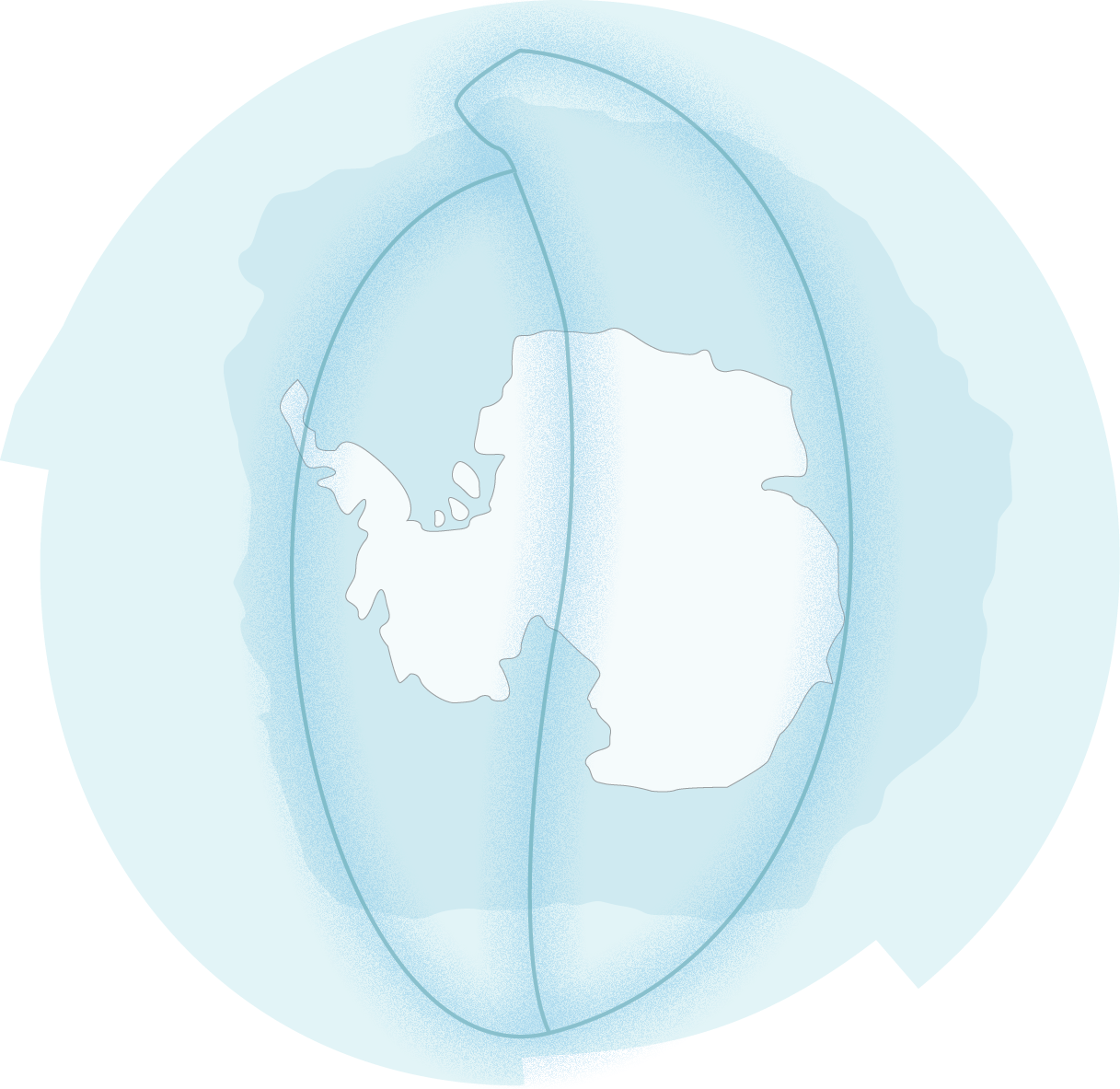
Atlas of Antarctic and sub-Antarctic Brachiopoda
 |
ISBN13 : 978-2-916733-15-9 "Dépôt légal à parution" Manuscript online on August 17, 2017 |
 |
| Copyright Creative Commons - Attribution-NonCommercial-NoDerivs 3.0 Unported  |
||

